Form 8-K FIRSTENERGY CORP For: Aug 23
UNITED STATES
SECURITIES AND EXCHANGE COMMISSION
Washington, D. C. 20549
FORM 8-K
CURRENT REPORT
PURSUANT TO SECTION 13 OR 15(d) OF THE
SECURITIES EXCHANGE ACT OF 1934
Date of Report (Date of earliest event reported): August 23, 2022
| Commission | Registrant; State of Incorporation; | I.R.S. Employer | |||||||||||||||||||||
| File Number | Address; and Telephone Number | Identification No. | |||||||||||||||||||||
| (An | Corporation) | ||||||||||||||||||||||
| Telephone | |||||||||||||||||||||||
Check the appropriate box below if the Form 8-K filing is intended to simultaneously satisfy the filing obligation of the registrant under any of the following provisions:
Securities registered pursuant to Section 12(b) of the Act:
| Title of each class | Trading Symbol(s) | Name of each exchange on which registered | ||||||||||||
Indicate by check mark whether the registrant is an emerging growth company as defined in Rule 405 of the Securities Act of 1933 (17 CFR §230.405) or Rule 12b-2 of the Securities Exchange Act of 1934 (17 CFR §240.12b-2).
Emerging growth company ☐
If an emerging growth company, indicate by check mark if the registrant has elected not to use the extended transition period for complying with any new or revised financial accounting standards provided pursuant to Section 13(a) of the Exchange Act. ☐
Item 7.01 Regulation FD Disclosure.
As previously disclosed, on March 11, 2022, the Special Litigation Committee (the “SLC”) of the Board of Directors (the “Board”) of FirstEnergy Corp. (the “Company”) entered into a Stipulation and Agreement of Settlement (the “Stipulation”) to resolve multiple shareholder derivative lawsuits filed in the U.S. District Court for the Southern District of Ohio (the “Court”), the U.S. District Court for the Northern District of Ohio, and the Ohio Court of Common Pleas, Summit County (collectively, the “Derivative Actions”), which, among other things, included a payment to the Company of $180 million, less Court-ordered attorney’s fees. Also, as previously disclosed, on May 9, 2022, the Court preliminarily approved the Stipulation.
The Court held its final settlement approval hearing with respect to the proposed settlement as set forth in the Stipulation on August 4, 2022. The Court issued an order on August 23, 2022, granting final approval of the settlement (the “Court Order”). Additionally, the Court Order granted plaintiffs a fee and expense award of $36 million, which is less than the $48.6 million award plaintiffs had requested. The Court also entered a final judgment dismissing the case with prejudice. On August 24, 2022, the parties filed a joint motion to dismiss the Derivative Action currently pending in the U.S. District Court for the Northern District of Ohio.
The information set forth in and incorporated by reference into this Item 7.01 of this Current Report on Form 8-K is being furnished pursuant to Item 7.01 of Form 8-K and shall not be deemed “filed” for purposes of Section 18 of the Securities Exchange Act of 1934, or otherwise subject to the liabilities of that section, nor shall it be deemed incorporated by reference into any of the Company’s filings under the Securities Act of 1933 or the Securities Exchange Act of 1934, whether made before or after the date hereof and regardless of any general incorporation language in such filings, except to the extent expressly set forth by specific reference in such a filing. The furnishing of this Item 7.01 of this Current Report on Form 8-K shall not be deemed an admission as to the materiality of any information herein that is required to be disclosed solely by reason of Regulation FD.
Item 9.01 Financial Statements and Exhibits.
| (d) Exhibits | ||||||||
| Exhibit No. | Description | |||||||
| 99.1 | ||||||||
| 99.2 | ||||||||
| 104 | Cover Page Interactive Data File (the cover page XBRL tags are embedded within the Inline XBRL document) | |||||||
Forward-Looking Statements: This Form 8-K includes forward-looking statements based on information currently available to management. Such statements are subject to certain risks and uncertainties and readers are cautioned not to place undue reliance on these forward-looking statements. These statements include declarations regarding management's intents, beliefs and current expectations. These statements typically contain, but are not limited to, the terms “anticipate,” “potential,” “expect,” "forecast," "target," "will," "intend," “believe,” "project," “estimate," "plan" and similar words. Forward-looking statements involve estimates, assumptions, known and unknown risks, uncertainties and other factors that may cause actual results, performance or achievements to be materially different from any future results, performance or achievements expressed or implied by such forward-looking statements, which may include the following: the potential liabilities, increased costs and unanticipated developments resulting from government investigations and agreements, including those associated with compliance with or failure to comply with the Deferred Prosecution Agreement entered into on July 21, 2021 with the U.S. Attorney’s Office for the Southern District of Ohio; the risks and uncertainties associated with government investigations and audits regarding Ohio House Bill 6, as passed by Ohio’s 133rd General Assembly (“HB 6”) and related matters, including potential adverse impacts on federal or state regulatory matters, including, but not limited to, matters relating to rates; the risks and uncertainties associated with litigation, arbitration, mediation, and similar proceedings, particularly regarding HB 6 related matters, including risks associated with obtaining court approval of the settlement agreement in the derivative shareholder lawsuits; changes in national and regional economic conditions, including recession and inflationary pressure, affecting us and/or our customers and those vendors with which we do business; weather conditions, such as temperature variations and severe weather conditions, or other natural disasters affecting future operating results and associated regulatory actions or outcomes in response to such conditions; legislative and regulatory developments, including, but not limited to, matters related to rates, compliance and enforcement activity, cybersecurity, and climate change; the ability to accomplish or realize anticipated benefits from our FE Forward initiative and our other strategic and financial goals, including, but not limited to, overcoming current uncertainties and challenges associated with the ongoing government investigations, executing our transmission and distribution investment plans, greenhouse gas reduction goals, controlling costs, improving our credit metrics, growing earnings, and strengthening our balance sheet; changing market conditions affecting the measurement of certain liabilities and the value of assets held in our pension trusts may negatively impact our results of operations and related guidance, and may also cause us to make contributions to our pension sooner or in amounts that are larger than currently anticipated; the risks associated with cyber-attacks and other disruptions to our, or our vendors’, information technology system, which may compromise our operations, and data security breaches of sensitive data, intellectual property and proprietary or personally identifiable information; mitigating exposure for remedial activities associated with retired and formerly owned electric generation assets; the ability to access the public securities and other capital and credit markets in accordance with our financial plans, the cost of such capital and overall condition of the capital and credit markets affecting us, including the increasing number of financial institutions evaluating the impact of climate change on their investment decisions; the extent and duration of the COVID-19 pandemic and the related impacts to our business, operations and financial condition resulting from the outbreak of COVID-19 including, but not limited to, disruption of businesses in our territories, supply chain disruptions, additional costs, workforce impacts and governmental and regulatory responses to the pandemic, such as the moratoriums on utility disconnections and workforce vaccination mandates imposed at varying points throughout the pandemic; actions that may be taken by credit rating agencies that could negatively affect either our access to or terms of financing or our financial condition and liquidity; changes in assumptions regarding factors such as economic conditions within our territories, the reliability of our transmission and distribution system, or the availability of capital or other resources supporting identified transmission and distribution investment opportunities; changes in customers’ demand for power, including, but not limited to, economic conditions, the impact of climate change, or energy efficiency and peak demand reduction mandates; the potential of non-compliance with debt covenants in our credit facilities; the ability to comply with applicable reliability standards and energy efficiency and peak demand reduction mandates; changes to environmental laws and regulations, including, but not limited to, those related to climate change; labor disruptions by our unionized workforce; changes to significant accounting policies; any changes in tax laws or regulations, or adverse tax audit results or rulings; and the risks and other factors discussed from time to time in our Securities and Exchange Commission (“SEC”) filings. Dividends declared from time to time on FirstEnergy Corp.’s common stock during any period may in the aggregate vary from prior periods due to circumstances considered by FirstEnergy Corp.’s Board of Directors at the time of the actual declarations. A security rating is not a recommendation to buy or hold securities and is subject to revision or withdrawal at any time by the assigning rating agency. Each rating should be evaluated independently of any other rating.
These forward-looking statements are also qualified by, and should be read together with, the risk factors included in FirstEnergy Corp.’s filings with the SEC, including, but not limited to, the most recent Annual Report on Form 10-K and Quarterly Report on Form 10-Q, and any subsequent Quarterly Reports on Form 10-Q and Current Reports on Form 8-K. The foregoing review of factors also should not be construed as exhaustive. New factors emerge from time to time, and it is not possible for management to predict all such factors, nor assess the impact of any such factor on FirstEnergy Corp.’s business or the extent to which any factor, or combination of factors, may cause results to differ materially from those contained in any forward-looking statements. FirstEnergy Corp. expressly disclaims any obligation to update or revise, except as required by law, any forward-looking statements contained herein or in the information incorporated by reference as a result of new information, future events or otherwise.
SIGNATURE
Pursuant to the requirements of the Securities Exchange Act of 1934, the Registrant has duly caused this report to be signed on its behalf by the undersigned hereunto duly authorized.
August 25, 2022
| FIRSTENERGY CORP. | |||||
| Registrant | |||||
| By: | /s/ Jason J. Lisowski | ||||
Jason J. Lisowski Vice President, Controller and Chief Accounting Officer | |||||
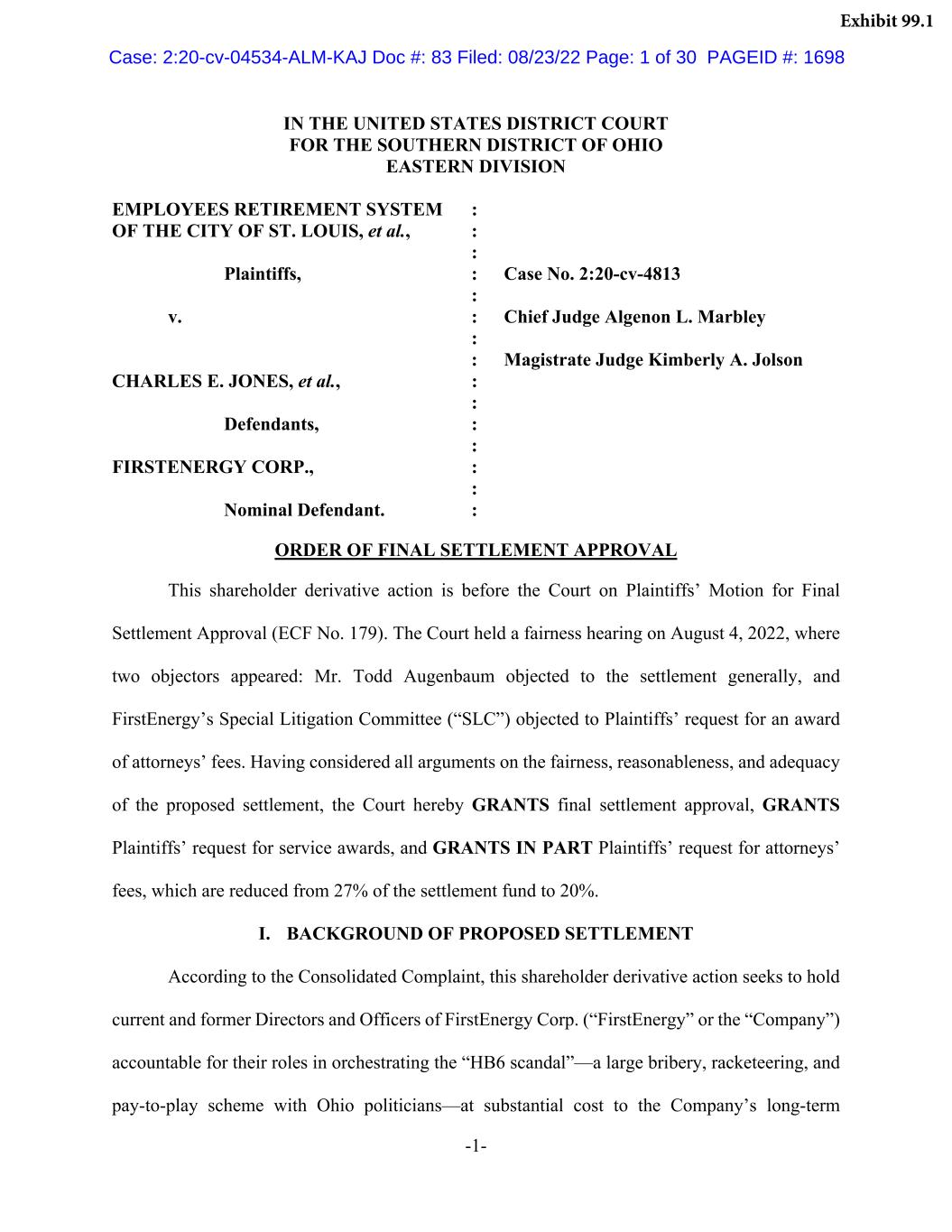
-1- IN THE UNITED STATES DISTRICT COURT FOR THE SOUTHERN DISTRICT OF OHIO EASTERN DIVISION EMPLOYEES RETIREMENT SYSTEM : OF THE CITY OF ST. LOUIS, et al., : : Plaintiffs, : Case No. 2:20-cv-4813 : v. : Chief Judge Algenon L. Marbley : : Magistrate Judge Kimberly A. Jolson CHARLES E. JONES, et al., : : Defendants, : : FIRSTENERGY CORP., : : Nominal Defendant. : ORDER OF FINAL SETTLEMENT APPROVAL This shareholder derivative action is before the Court on Plaintiffs’ Motion for Final Settlement Approval (ECF No. 179). The Court held a fairness hearing on August 4, 2022, where two objectors appeared: Mr. Todd Augenbaum objected to the settlement generally, and FirstEnergy’s Special Litigation Committee (“SLC”) objected to Plaintiffs’ request for an award of attorneys’ fees. Having considered all arguments on the fairness, reasonableness, and adequacy of the proposed settlement, the Court hereby GRANTS final settlement approval, GRANTS Plaintiffs’ request for service awards, and GRANTS IN PART Plaintiffs’ request for attorneys’ fees, which are reduced from 27% of the settlement fund to 20%. I. BACKGROUND OF PROPOSED SETTLEMENT According to the Consolidated Complaint, this shareholder derivative action seeks to hold current and former Directors and Officers of FirstEnergy Corp. (“FirstEnergy” or the “Company”) accountable for their roles in orchestrating the “HB6 scandal”—a large bribery, racketeering, and pay-to-play scheme with Ohio politicians—at substantial cost to the Company’s long-term Case: 2:20-cv-04534-ALM-KAJ Doc #: 83 Filed: 08/23/22 Page: 1 of 30 PAGEID #: 1698 Exhibit 99.1
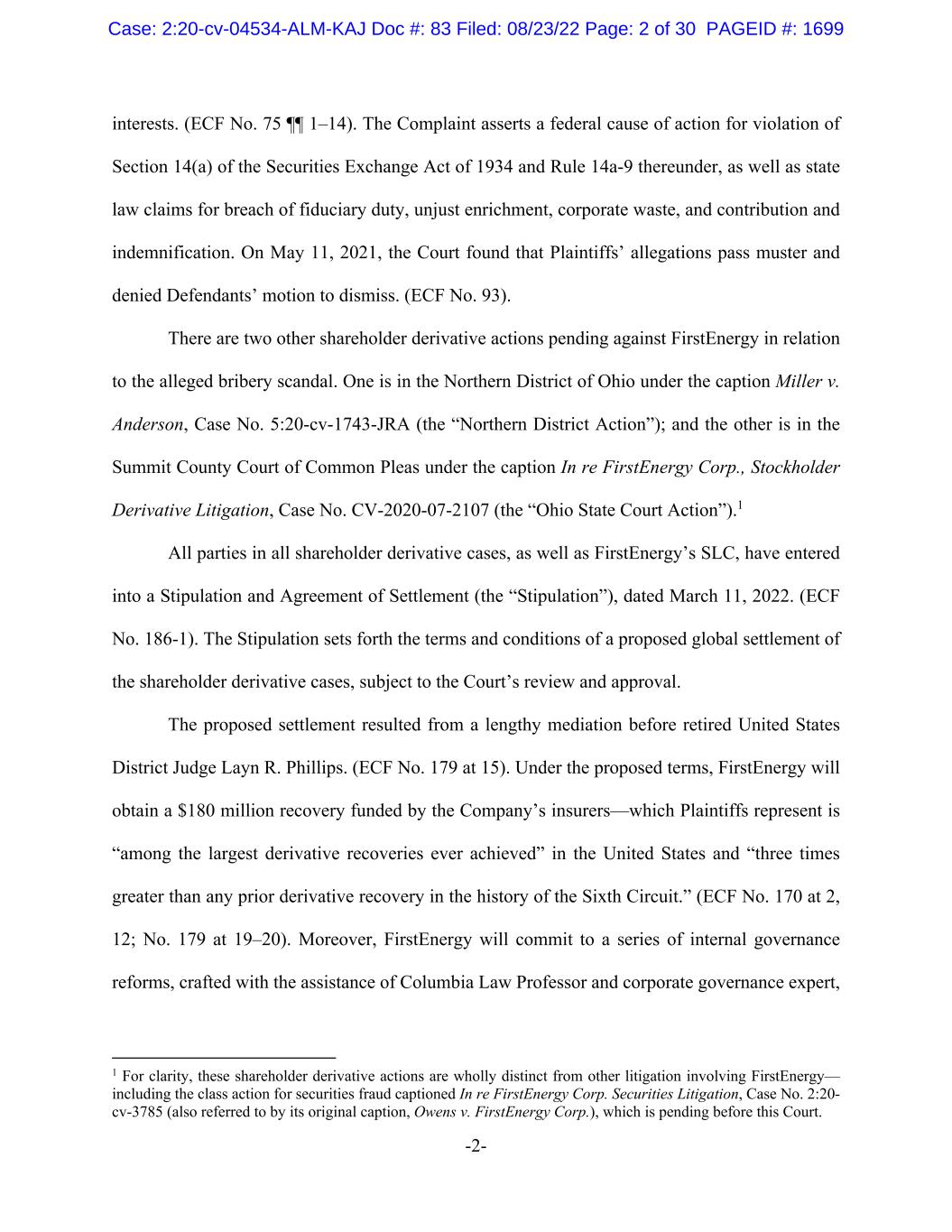
-2- interests. (ECF No. 75 ¶¶ 1–14). The Complaint asserts a federal cause of action for violation of Section 14(a) of the Securities Exchange Act of 1934 and Rule 14a-9 thereunder, as well as state law claims for breach of fiduciary duty, unjust enrichment, corporate waste, and contribution and indemnification. On May 11, 2021, the Court found that Plaintiffs’ allegations pass muster and denied Defendants’ motion to dismiss. (ECF No. 93). There are two other shareholder derivative actions pending against FirstEnergy in relation to the alleged bribery scandal. One is in the Northern District of Ohio under the caption Miller v. Anderson, Case No. 5:20-cv-1743-JRA (the “Northern District Action”); and the other is in the Summit County Court of Common Pleas under the caption In re FirstEnergy Corp., Stockholder Derivative Litigation, Case No. CV-2020-07-2107 (the “Ohio State Court Action”).1 All parties in all shareholder derivative cases, as well as FirstEnergy’s SLC, have entered into a Stipulation and Agreement of Settlement (the “Stipulation”), dated March 11, 2022. (ECF No. 186-1). The Stipulation sets forth the terms and conditions of a proposed global settlement of the shareholder derivative cases, subject to the Court’s review and approval. The proposed settlement resulted from a lengthy mediation before retired United States District Judge Layn R. Phillips. (ECF No. 179 at 15). Under the proposed terms, FirstEnergy will obtain a $180 million recovery funded by the Company’s insurers—which Plaintiffs represent is “among the largest derivative recoveries ever achieved” in the United States and “three times greater than any prior derivative recovery in the history of the Sixth Circuit.” (ECF No. 170 at 2, 12; No. 179 at 19–20). Moreover, FirstEnergy will commit to a series of internal governance reforms, crafted with the assistance of Columbia Law Professor and corporate governance expert, 1 For clarity, these shareholder derivative actions are wholly distinct from other litigation involving FirstEnergy— including the class action for securities fraud captioned In re FirstEnergy Corp. Securities Litigation, Case No. 2:20- cv-3785 (also referred to by its original caption, Owens v. FirstEnergy Corp.), which is pending before this Court. Case: 2:20-cv-04534-ALM-KAJ Doc #: 83 Filed: 08/23/22 Page: 2 of 30 PAGEID #: 1699
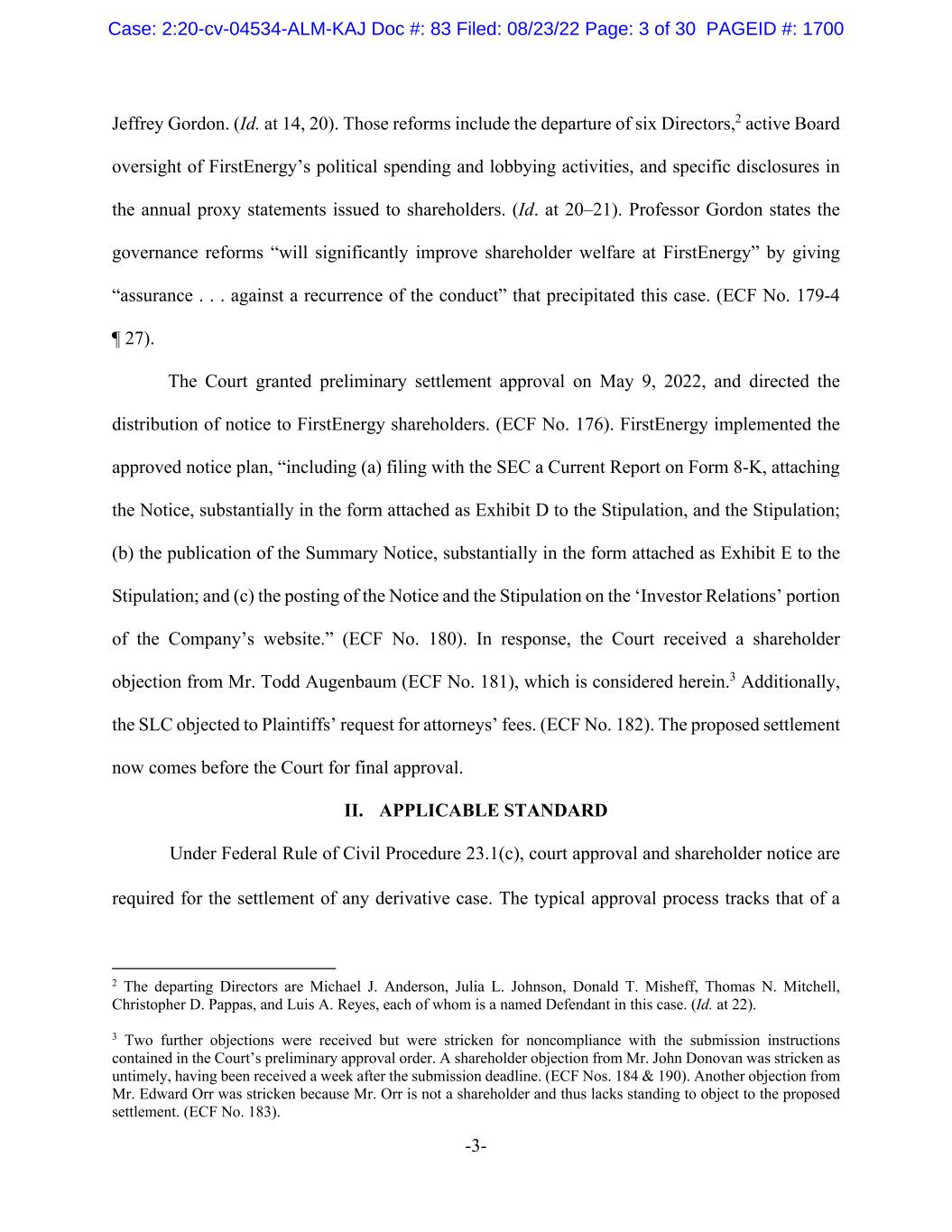
-3- Jeffrey Gordon. (Id. at 14, 20). Those reforms include the departure of six Directors,2 active Board oversight of FirstEnergy’s political spending and lobbying activities, and specific disclosures in the annual proxy statements issued to shareholders. (Id. at 20–21). Professor Gordon states the governance reforms “will significantly improve shareholder welfare at FirstEnergy” by giving “assurance . . . against a recurrence of the conduct” that precipitated this case. (ECF No. 179-4 ¶ 27). The Court granted preliminary settlement approval on May 9, 2022, and directed the distribution of notice to FirstEnergy shareholders. (ECF No. 176). FirstEnergy implemented the approved notice plan, “including (a) filing with the SEC a Current Report on Form 8-K, attaching the Notice, substantially in the form attached as Exhibit D to the Stipulation, and the Stipulation; (b) the publication of the Summary Notice, substantially in the form attached as Exhibit E to the Stipulation; and (c) the posting of the Notice and the Stipulation on the ‘Investor Relations’ portion of the Company’s website.” (ECF No. 180). In response, the Court received a shareholder objection from Mr. Todd Augenbaum (ECF No. 181), which is considered herein.3 Additionally, the SLC objected to Plaintiffs’ request for attorneys’ fees. (ECF No. 182). The proposed settlement now comes before the Court for final approval. II. APPLICABLE STANDARD Under Federal Rule of Civil Procedure 23.1(c), court approval and shareholder notice are required for the settlement of any derivative case. The typical approval process tracks that of a 2 The departing Directors are Michael J. Anderson, Julia L. Johnson, Donald T. Misheff, Thomas N. Mitchell, Christopher D. Pappas, and Luis A. Reyes, each of whom is a named Defendant in this case. (Id. at 22). 3 Two further objections were received but were stricken for noncompliance with the submission instructions contained in the Court’s preliminary approval order. A shareholder objection from Mr. John Donovan was stricken as untimely, having been received a week after the submission deadline. (ECF Nos. 184 & 190). Another objection from Mr. Edward Orr was stricken because Mr. Orr is not a shareholder and thus lacks standing to object to the proposed settlement. (ECF No. 183). Case: 2:20-cv-04534-ALM-KAJ Doc #: 83 Filed: 08/23/22 Page: 3 of 30 PAGEID #: 1700
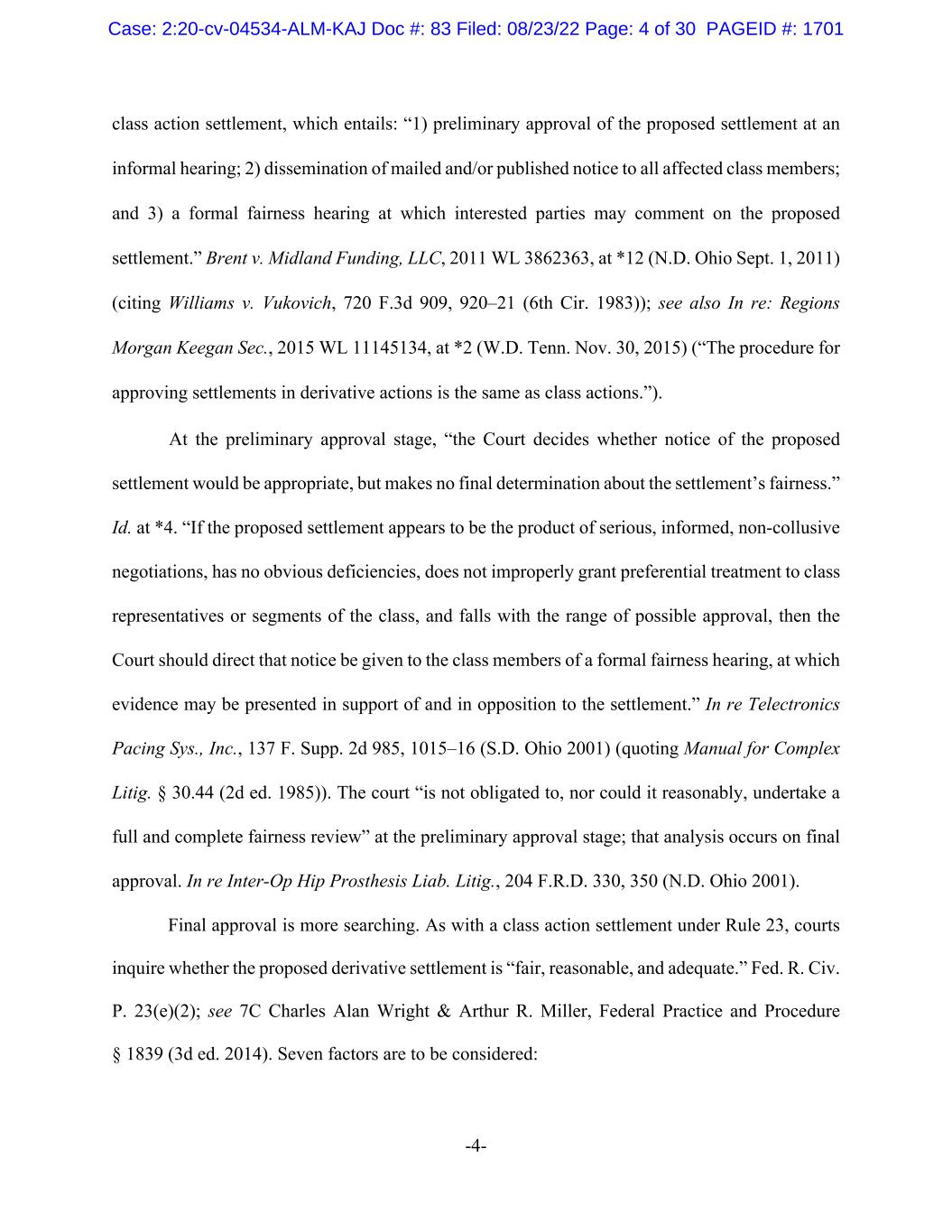
-4- class action settlement, which entails: “1) preliminary approval of the proposed settlement at an informal hearing; 2) dissemination of mailed and/or published notice to all affected class members; and 3) a formal fairness hearing at which interested parties may comment on the proposed settlement.” Brent v. Midland Funding, LLC, 2011 WL 3862363, at *12 (N.D. Ohio Sept. 1, 2011) (citing Williams v. Vukovich, 720 F.3d 909, 920–21 (6th Cir. 1983)); see also In re: Regions Morgan Keegan Sec., 2015 WL 11145134, at *2 (W.D. Tenn. Nov. 30, 2015) (“The procedure for approving settlements in derivative actions is the same as class actions.”). At the preliminary approval stage, “the Court decides whether notice of the proposed settlement would be appropriate, but makes no final determination about the settlement’s fairness.” Id. at *4. “If the proposed settlement appears to be the product of serious, informed, non-collusive negotiations, has no obvious deficiencies, does not improperly grant preferential treatment to class representatives or segments of the class, and falls with the range of possible approval, then the Court should direct that notice be given to the class members of a formal fairness hearing, at which evidence may be presented in support of and in opposition to the settlement.” In re Telectronics Pacing Sys., Inc., 137 F. Supp. 2d 985, 1015–16 (S.D. Ohio 2001) (quoting Manual for Complex Litig. § 30.44 (2d ed. 1985)). The court “is not obligated to, nor could it reasonably, undertake a full and complete fairness review” at the preliminary approval stage; that analysis occurs on final approval. In re Inter-Op Hip Prosthesis Liab. Litig., 204 F.R.D. 330, 350 (N.D. Ohio 2001). Final approval is more searching. As with a class action settlement under Rule 23, courts inquire whether the proposed derivative settlement is “fair, reasonable, and adequate.” Fed. R. Civ. P. 23(e)(2); see 7C Charles Alan Wright & Arthur R. Miller, Federal Practice and Procedure § 1839 (3d ed. 2014). Seven factors are to be considered: Case: 2:20-cv-04534-ALM-KAJ Doc #: 83 Filed: 08/23/22 Page: 4 of 30 PAGEID #: 1701
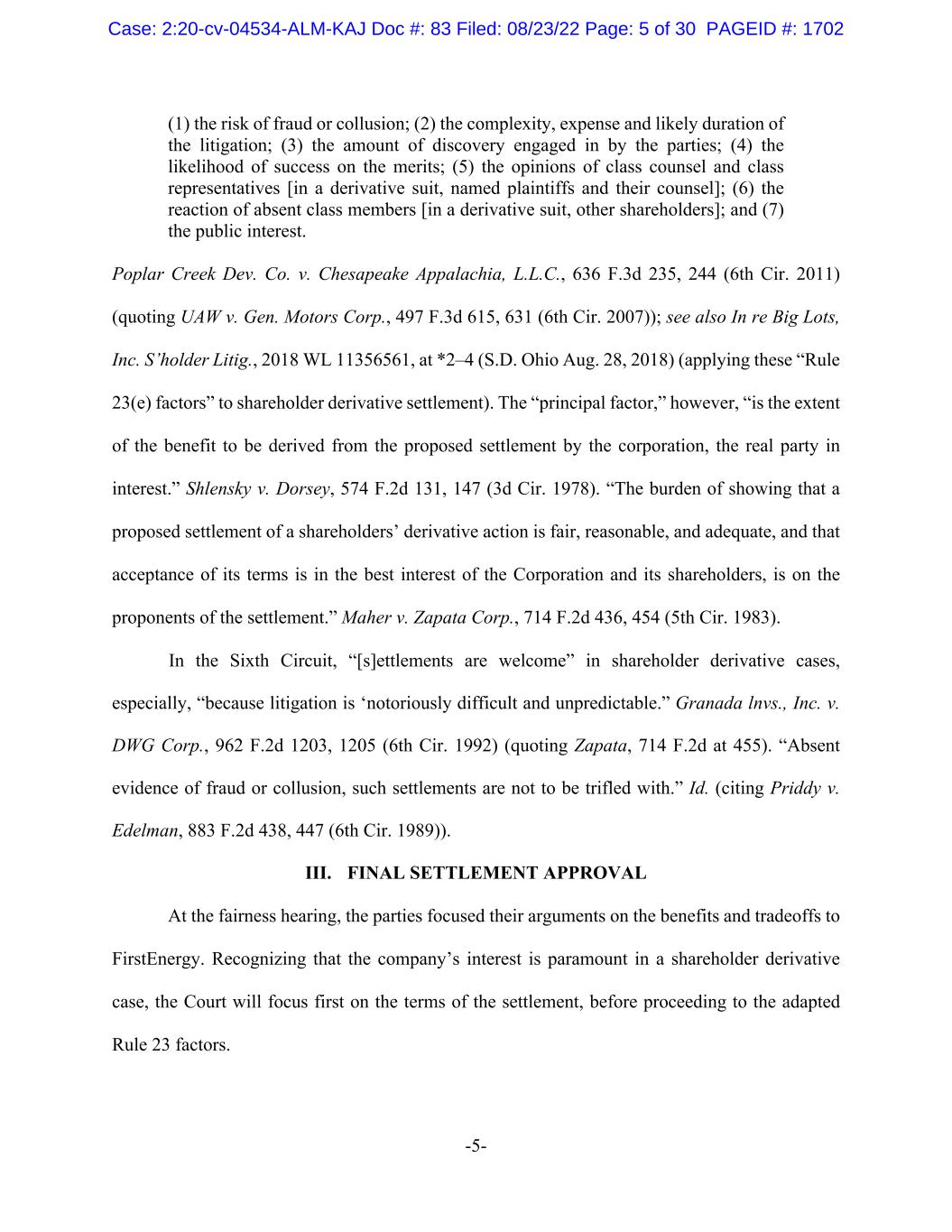
-5- (1) the risk of fraud or collusion; (2) the complexity, expense and likely duration of the litigation; (3) the amount of discovery engaged in by the parties; (4) the likelihood of success on the merits; (5) the opinions of class counsel and class representatives [in a derivative suit, named plaintiffs and their counsel]; (6) the reaction of absent class members [in a derivative suit, other shareholders]; and (7) the public interest. Poplar Creek Dev. Co. v. Chesapeake Appalachia, L.L.C., 636 F.3d 235, 244 (6th Cir. 2011) (quoting UAW v. Gen. Motors Corp., 497 F.3d 615, 631 (6th Cir. 2007)); see also In re Big Lots, Inc. S’holder Litig., 2018 WL 11356561, at *2–4 (S.D. Ohio Aug. 28, 2018) (applying these “Rule 23(e) factors” to shareholder derivative settlement). The “principal factor,” however, “is the extent of the benefit to be derived from the proposed settlement by the corporation, the real party in interest.” Shlensky v. Dorsey, 574 F.2d 131, 147 (3d Cir. 1978). “The burden of showing that a proposed settlement of a shareholders’ derivative action is fair, reasonable, and adequate, and that acceptance of its terms is in the best interest of the Corporation and its shareholders, is on the proponents of the settlement.” Maher v. Zapata Corp., 714 F.2d 436, 454 (5th Cir. 1983). In the Sixth Circuit, “[s]ettlements are welcome” in shareholder derivative cases, especially, “because litigation is ‘notoriously difficult and unpredictable.” Granada lnvs., Inc. v. DWG Corp., 962 F.2d 1203, 1205 (6th Cir. 1992) (quoting Zapata, 714 F.2d at 455). “Absent evidence of fraud or collusion, such settlements are not to be trifled with.” Id. (citing Priddy v. Edelman, 883 F.2d 438, 447 (6th Cir. 1989)). III. FINAL SETTLEMENT APPROVAL At the fairness hearing, the parties focused their arguments on the benefits and tradeoffs to FirstEnergy. Recognizing that the company’s interest is paramount in a shareholder derivative case, the Court will focus first on the terms of the settlement, before proceeding to the adapted Rule 23 factors. Case: 2:20-cv-04534-ALM-KAJ Doc #: 83 Filed: 08/23/22 Page: 5 of 30 PAGEID #: 1702
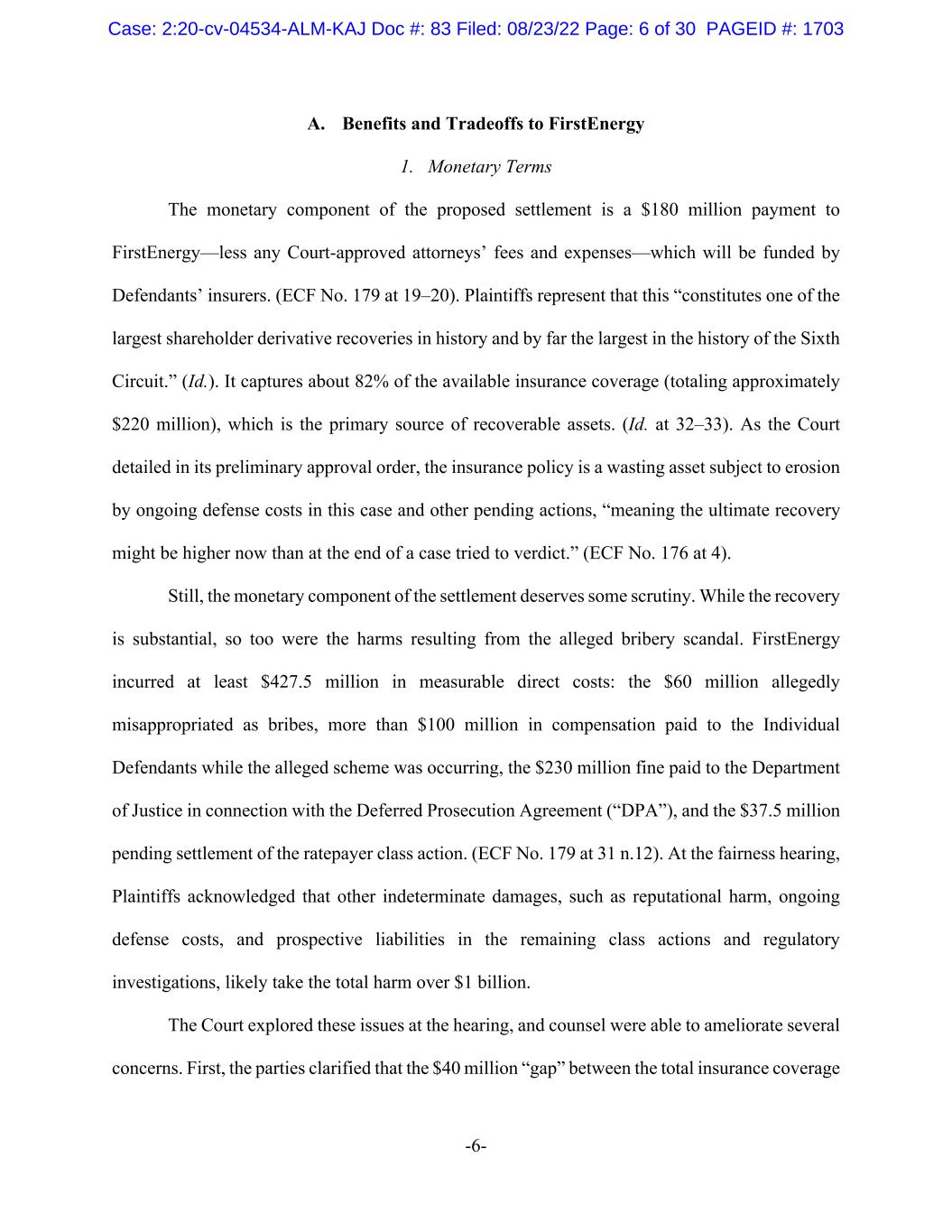
-6- A. Benefits and Tradeoffs to FirstEnergy 1. Monetary Terms The monetary component of the proposed settlement is a $180 million payment to FirstEnergy—less any Court-approved attorneys’ fees and expenses—which will be funded by Defendants’ insurers. (ECF No. 179 at 19–20). Plaintiffs represent that this “constitutes one of the largest shareholder derivative recoveries in history and by far the largest in the history of the Sixth Circuit.” (Id.). It captures about 82% of the available insurance coverage (totaling approximately $220 million), which is the primary source of recoverable assets. (Id. at 32–33). As the Court detailed in its preliminary approval order, the insurance policy is a wasting asset subject to erosion by ongoing defense costs in this case and other pending actions, “meaning the ultimate recovery might be higher now than at the end of a case tried to verdict.” (ECF No. 176 at 4). Still, the monetary component of the settlement deserves some scrutiny. While the recovery is substantial, so too were the harms resulting from the alleged bribery scandal. FirstEnergy incurred at least $427.5 million in measurable direct costs: the $60 million allegedly misappropriated as bribes, more than $100 million in compensation paid to the Individual Defendants while the alleged scheme was occurring, the $230 million fine paid to the Department of Justice in connection with the Deferred Prosecution Agreement (“DPA”), and the $37.5 million pending settlement of the ratepayer class action. (ECF No. 179 at 31 n.12). At the fairness hearing, Plaintiffs acknowledged that other indeterminate damages, such as reputational harm, ongoing defense costs, and prospective liabilities in the remaining class actions and regulatory investigations, likely take the total harm over $1 billion. The Court explored these issues at the hearing, and counsel were able to ameliorate several concerns. First, the parties clarified that the $40 million “gap” between the total insurance coverage Case: 2:20-cv-04534-ALM-KAJ Doc #: 83 Filed: 08/23/22 Page: 6 of 30 PAGEID #: 1703
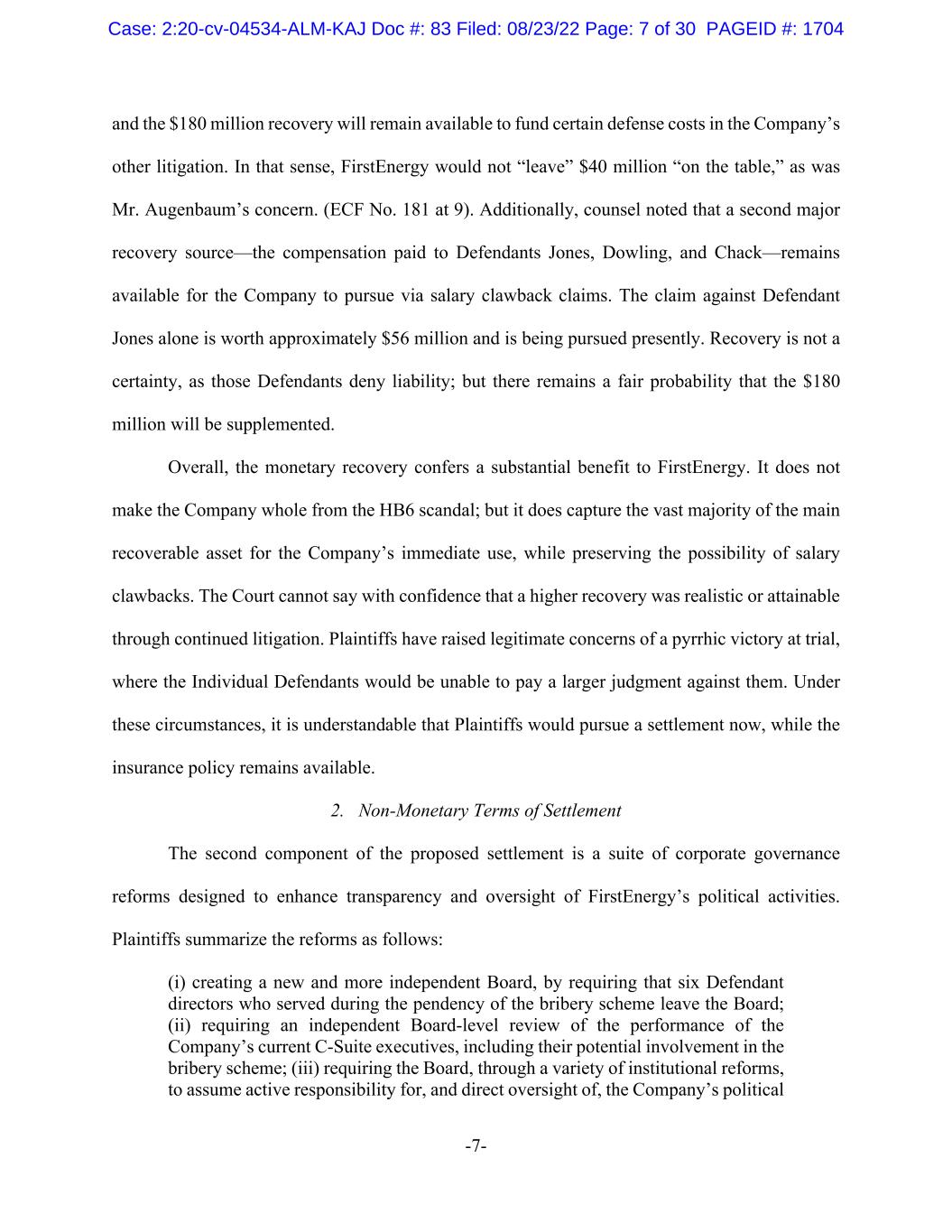
-7- and the $180 million recovery will remain available to fund certain defense costs in the Company’s other litigation. In that sense, FirstEnergy would not “leave” $40 million “on the table,” as was Mr. Augenbaum’s concern. (ECF No. 181 at 9). Additionally, counsel noted that a second major recovery source—the compensation paid to Defendants Jones, Dowling, and Chack—remains available for the Company to pursue via salary clawback claims. The claim against Defendant Jones alone is worth approximately $56 million and is being pursued presently. Recovery is not a certainty, as those Defendants deny liability; but there remains a fair probability that the $180 million will be supplemented. Overall, the monetary recovery confers a substantial benefit to FirstEnergy. It does not make the Company whole from the HB6 scandal; but it does capture the vast majority of the main recoverable asset for the Company’s immediate use, while preserving the possibility of salary clawbacks. The Court cannot say with confidence that a higher recovery was realistic or attainable through continued litigation. Plaintiffs have raised legitimate concerns of a pyrrhic victory at trial, where the Individual Defendants would be unable to pay a larger judgment against them. Under these circumstances, it is understandable that Plaintiffs would pursue a settlement now, while the insurance policy remains available. 2. Non-Monetary Terms of Settlement The second component of the proposed settlement is a suite of corporate governance reforms designed to enhance transparency and oversight of FirstEnergy’s political activities. Plaintiffs summarize the reforms as follows: (i) creating a new and more independent Board, by requiring that six Defendant directors who served during the pendency of the bribery scheme leave the Board; (ii) requiring an independent Board-level review of the performance of the Company’s current C-Suite executives, including their potential involvement in the bribery scheme; (iii) requiring the Board, through a variety of institutional reforms, to assume active responsibility for, and direct oversight of, the Company’s political Case: 2:20-cv-04534-ALM-KAJ Doc #: 83 Filed: 08/23/22 Page: 7 of 30 PAGEID #: 1704
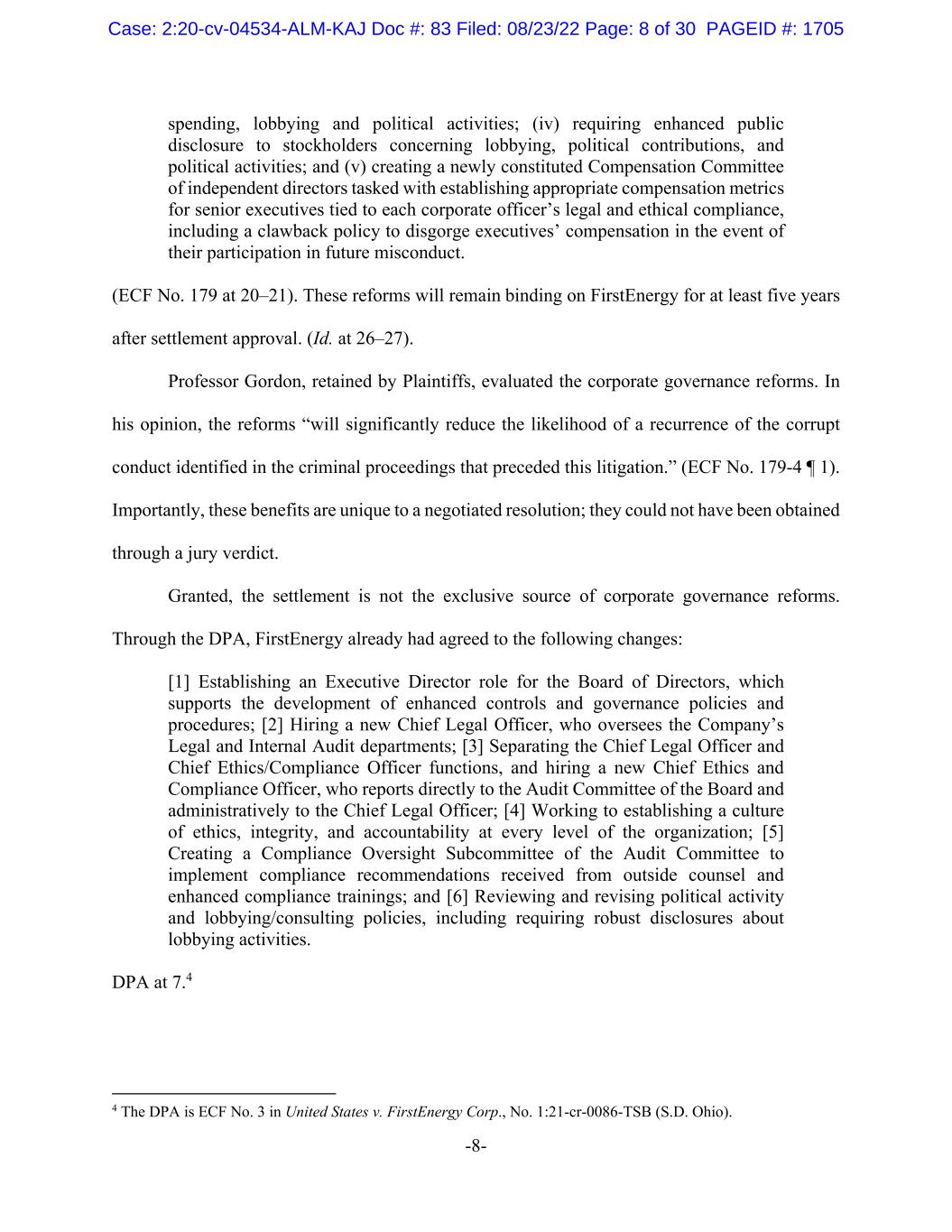
-8- spending, lobbying and political activities; (iv) requiring enhanced public disclosure to stockholders concerning lobbying, political contributions, and political activities; and (v) creating a newly constituted Compensation Committee of independent directors tasked with establishing appropriate compensation metrics for senior executives tied to each corporate officer’s legal and ethical compliance, including a clawback policy to disgorge executives’ compensation in the event of their participation in future misconduct. (ECF No. 179 at 20–21). These reforms will remain binding on FirstEnergy for at least five years after settlement approval. (Id. at 26–27). Professor Gordon, retained by Plaintiffs, evaluated the corporate governance reforms. In his opinion, the reforms “will significantly reduce the likelihood of a recurrence of the corrupt conduct identified in the criminal proceedings that preceded this litigation.” (ECF No. 179-4 ¶ 1). Importantly, these benefits are unique to a negotiated resolution; they could not have been obtained through a jury verdict. Granted, the settlement is not the exclusive source of corporate governance reforms. Through the DPA, FirstEnergy already had agreed to the following changes: [1] Establishing an Executive Director role for the Board of Directors, which supports the development of enhanced controls and governance policies and procedures; [2] Hiring a new Chief Legal Officer, who oversees the Company’s Legal and Internal Audit departments; [3] Separating the Chief Legal Officer and Chief Ethics/Compliance Officer functions, and hiring a new Chief Ethics and Compliance Officer, who reports directly to the Audit Committee of the Board and administratively to the Chief Legal Officer; [4] Working to establishing a culture of ethics, integrity, and accountability at every level of the organization; [5] Creating a Compliance Oversight Subcommittee of the Audit Committee to implement compliance recommendations received from outside counsel and enhanced compliance trainings; and [6] Reviewing and revising political activity and lobbying/consulting policies, including requiring robust disclosures about lobbying activities. DPA at 7.4 4 The DPA is ECF No. 3 in United States v. FirstEnergy Corp., No. 1:21-cr-0086-TSB (S.D. Ohio). Case: 2:20-cv-04534-ALM-KAJ Doc #: 83 Filed: 08/23/22 Page: 8 of 30 PAGEID #: 1705
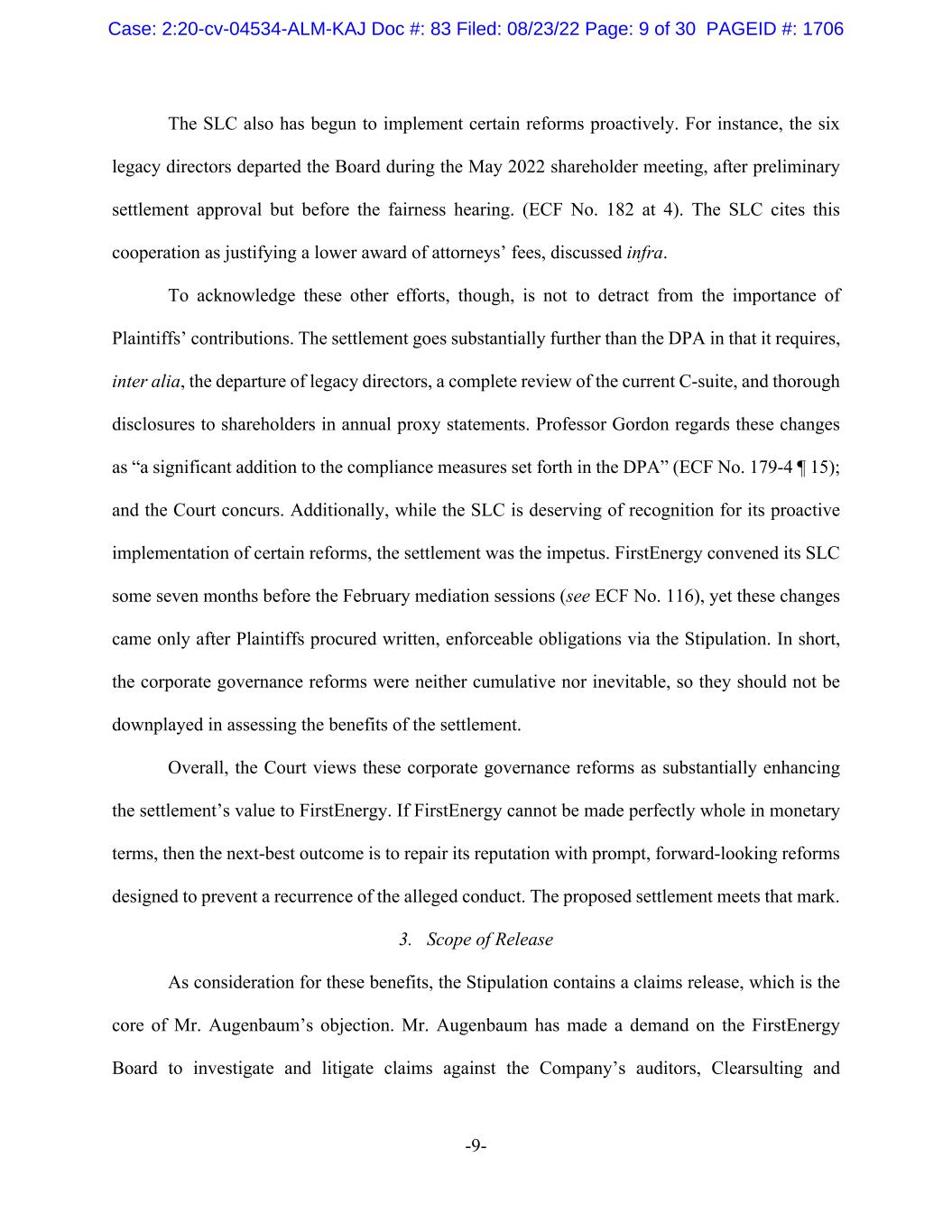
-9- The SLC also has begun to implement certain reforms proactively. For instance, the six legacy directors departed the Board during the May 2022 shareholder meeting, after preliminary settlement approval but before the fairness hearing. (ECF No. 182 at 4). The SLC cites this cooperation as justifying a lower award of attorneys’ fees, discussed infra. To acknowledge these other efforts, though, is not to detract from the importance of Plaintiffs’ contributions. The settlement goes substantially further than the DPA in that it requires, inter alia, the departure of legacy directors, a complete review of the current C-suite, and thorough disclosures to shareholders in annual proxy statements. Professor Gordon regards these changes as “a significant addition to the compliance measures set forth in the DPA” (ECF No. 179-4 ¶ 15); and the Court concurs. Additionally, while the SLC is deserving of recognition for its proactive implementation of certain reforms, the settlement was the impetus. FirstEnergy convened its SLC some seven months before the February mediation sessions (see ECF No. 116), yet these changes came only after Plaintiffs procured written, enforceable obligations via the Stipulation. In short, the corporate governance reforms were neither cumulative nor inevitable, so they should not be downplayed in assessing the benefits of the settlement. Overall, the Court views these corporate governance reforms as substantially enhancing the settlement’s value to FirstEnergy. If FirstEnergy cannot be made perfectly whole in monetary terms, then the next-best outcome is to repair its reputation with prompt, forward-looking reforms designed to prevent a recurrence of the alleged conduct. The proposed settlement meets that mark. 3. Scope of Release As consideration for these benefits, the Stipulation contains a claims release, which is the core of Mr. Augenbaum’s objection. Mr. Augenbaum has made a demand on the FirstEnergy Board to investigate and litigate claims against the Company’s auditors, Clearsulting and Case: 2:20-cv-04534-ALM-KAJ Doc #: 83 Filed: 08/23/22 Page: 9 of 30 PAGEID #: 1706

-10- PricewaterhouseCoopers, on the grounds that those auditors failed to detect or report wrongdoing related to the HB6 scandal. (ECF No. 181 at 3; No. 181-2). Mr. Augenbaum believes the release clause is ambiguous and could be read to encompass potential claims against the auditors. (ECF No. 181 at 4–7). As such, Mr. Augenbaum asks that the Stipulation be amended to avoid any uncertainty. (Id. at 6). The clause at issue reads as follows: “Released Defendants’ Persons” means Defendants, any other individual named as a defendant in any complaint filed in any of the Actions, the Company, the SLC, and any entity in which the Company has a controlling interest, as well as their respective current and former parents, affiliates, subsidiaries, officers, directors, agents, successors, predecessors, assigns, assignees, partnerships, partners, committees, joint ventures, trustees, trusts, employees, immediate family members, heirs, insurers and reinsurers (in their capacities as such), and consultants, experts, and attorneys (provided, however, that consultants, experts and attorneys are only “Released Defendants’ Persons” insofar as they were engaged by Defendants and are not released under this Stipulation if and to the extent that they were engaged by the Company.) (ECF No. 186-1 at 25 (emphasis added)). This aspect of the settlement is untroubling. As the SLC notes in its response, the “provided” language is key: third-party consultants are released only “insofar as they were engaged by Defendants,” as opposed to the Company. Each of FirstEnergy’s auditors was engaged by the Audit Committee on behalf of the Company, not by any Individual Defendant. (ECF No. 185 at 2). Thus, the clear language of the release provides the assurance Mr. Augenbaum seeks. Potential claims against the auditors are preserved in the settlement. Mr. Augenbaum also takes issue with the release of unknown claims, which he states “is extraordinarily broad.” (ECF No. 181 at 12–13). The applicable clause releases all claims that Plaintiffs, the Company, or the SLC (i) asserted in the Complaints or (ii) could have asserted on behalf of the Company that in any way are based on, arise from or relate to the allegations, transactions, facts, matters, disclosures or nondisclosures set forth in the Complaints, including but not limited to the conduct, actions, Case: 2:20-cv-04534-ALM-KAJ Doc #: 83 Filed: 08/23/22 Page: 10 of 30 PAGEID #: 1707
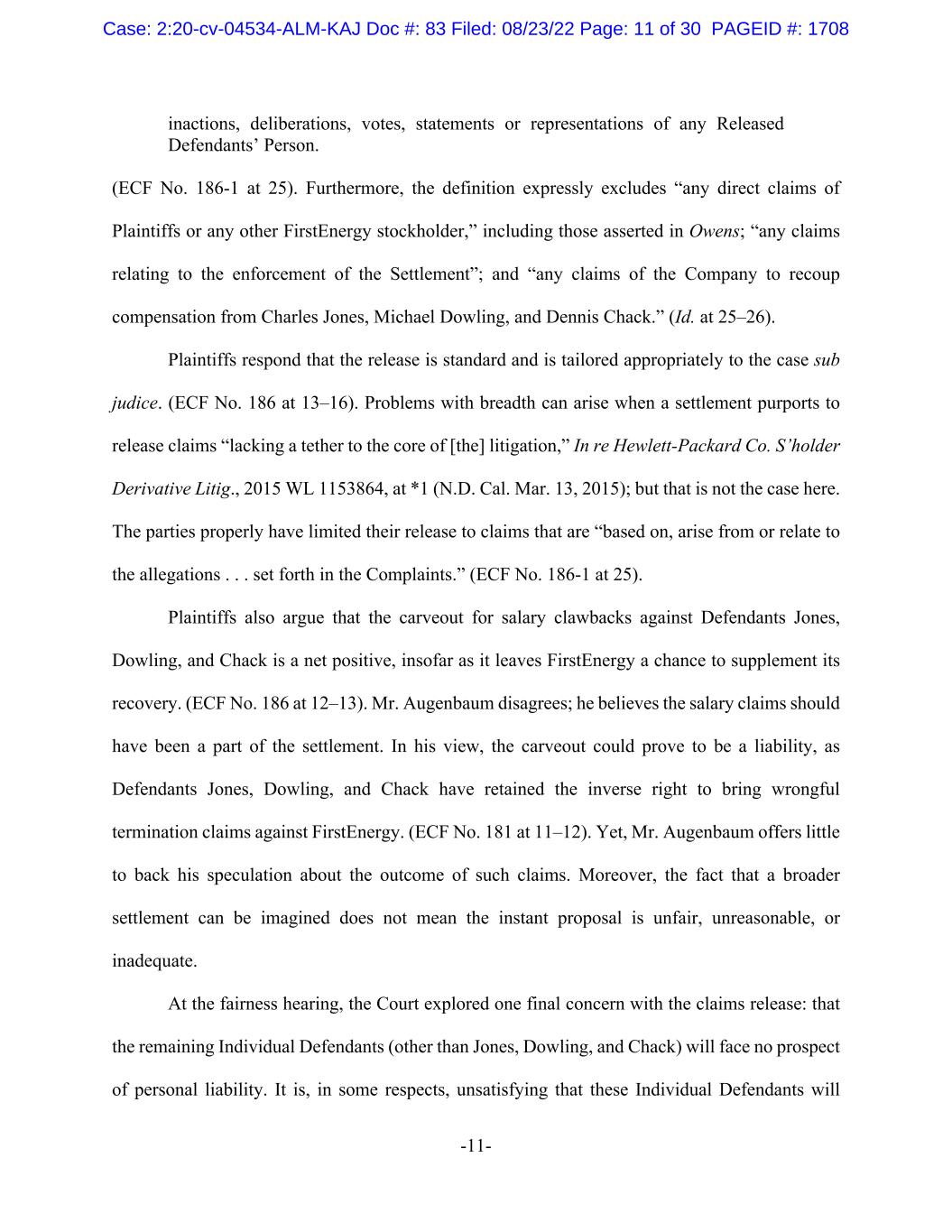
-11- inactions, deliberations, votes, statements or representations of any Released Defendants’ Person. (ECF No. 186-1 at 25). Furthermore, the definition expressly excludes “any direct claims of Plaintiffs or any other FirstEnergy stockholder,” including those asserted in Owens; “any claims relating to the enforcement of the Settlement”; and “any claims of the Company to recoup compensation from Charles Jones, Michael Dowling, and Dennis Chack.” (Id. at 25–26). Plaintiffs respond that the release is standard and is tailored appropriately to the case sub judice. (ECF No. 186 at 13–16). Problems with breadth can arise when a settlement purports to release claims “lacking a tether to the core of [the] litigation,” In re Hewlett-Packard Co. S’holder Derivative Litig., 2015 WL 1153864, at *1 (N.D. Cal. Mar. 13, 2015); but that is not the case here. The parties properly have limited their release to claims that are “based on, arise from or relate to the allegations . . . set forth in the Complaints.” (ECF No. 186-1 at 25). Plaintiffs also argue that the carveout for salary clawbacks against Defendants Jones, Dowling, and Chack is a net positive, insofar as it leaves FirstEnergy a chance to supplement its recovery. (ECF No. 186 at 12–13). Mr. Augenbaum disagrees; he believes the salary claims should have been a part of the settlement. In his view, the carveout could prove to be a liability, as Defendants Jones, Dowling, and Chack have retained the inverse right to bring wrongful termination claims against FirstEnergy. (ECF No. 181 at 11–12). Yet, Mr. Augenbaum offers little to back his speculation about the outcome of such claims. Moreover, the fact that a broader settlement can be imagined does not mean the instant proposal is unfair, unreasonable, or inadequate. At the fairness hearing, the Court explored one final concern with the claims release: that the remaining Individual Defendants (other than Jones, Dowling, and Chack) will face no prospect of personal liability. It is, in some respects, unsatisfying that these Individual Defendants will Case: 2:20-cv-04534-ALM-KAJ Doc #: 83 Filed: 08/23/22 Page: 11 of 30 PAGEID #: 1708
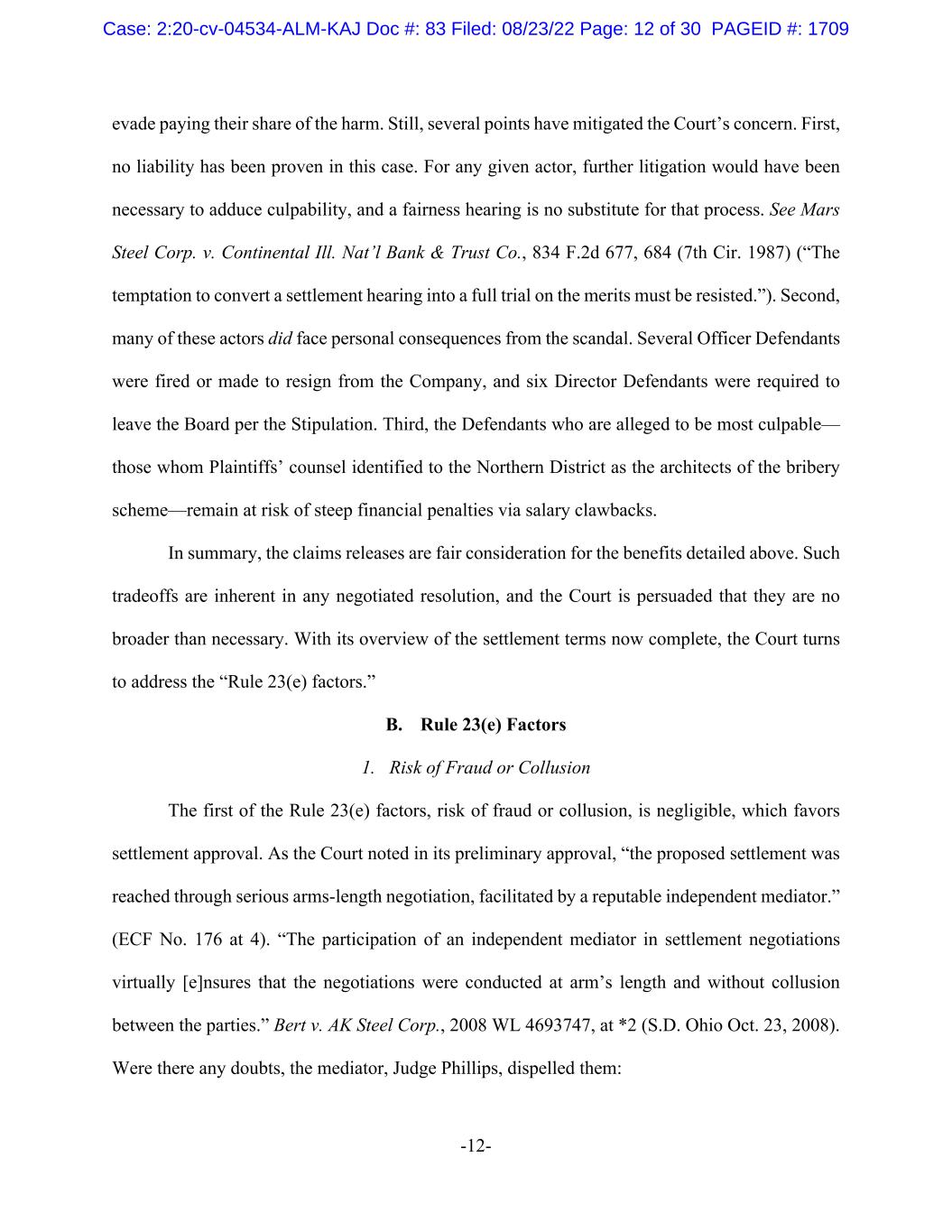
-12- evade paying their share of the harm. Still, several points have mitigated the Court’s concern. First, no liability has been proven in this case. For any given actor, further litigation would have been necessary to adduce culpability, and a fairness hearing is no substitute for that process. See Mars Steel Corp. v. Continental Ill. Nat’l Bank & Trust Co., 834 F.2d 677, 684 (7th Cir. 1987) (“The temptation to convert a settlement hearing into a full trial on the merits must be resisted.”). Second, many of these actors did face personal consequences from the scandal. Several Officer Defendants were fired or made to resign from the Company, and six Director Defendants were required to leave the Board per the Stipulation. Third, the Defendants who are alleged to be most culpable— those whom Plaintiffs’ counsel identified to the Northern District as the architects of the bribery scheme—remain at risk of steep financial penalties via salary clawbacks. In summary, the claims releases are fair consideration for the benefits detailed above. Such tradeoffs are inherent in any negotiated resolution, and the Court is persuaded that they are no broader than necessary. With its overview of the settlement terms now complete, the Court turns to address the “Rule 23(e) factors.” B. Rule 23(e) Factors 1. Risk of Fraud or Collusion The first of the Rule 23(e) factors, risk of fraud or collusion, is negligible, which favors settlement approval. As the Court noted in its preliminary approval, “the proposed settlement was reached through serious arms-length negotiation, facilitated by a reputable independent mediator.” (ECF No. 176 at 4). “The participation of an independent mediator in settlement negotiations virtually [e]nsures that the negotiations were conducted at arm’s length and without collusion between the parties.” Bert v. AK Steel Corp., 2008 WL 4693747, at *2 (S.D. Ohio Oct. 23, 2008). Were there any doubts, the mediator, Judge Phillips, dispelled them: Case: 2:20-cv-04534-ALM-KAJ Doc #: 83 Filed: 08/23/22 Page: 12 of 30 PAGEID #: 1709
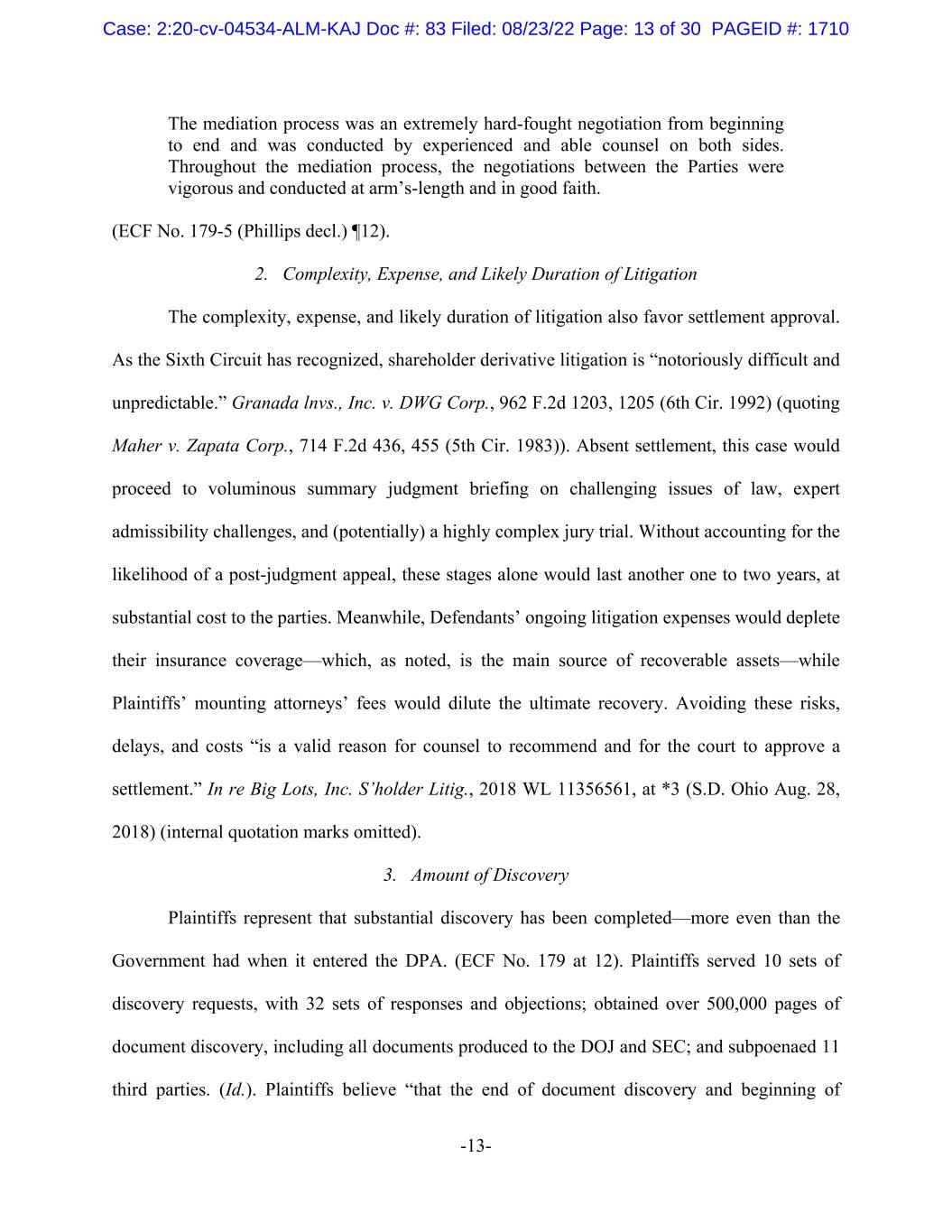
-13- The mediation process was an extremely hard-fought negotiation from beginning to end and was conducted by experienced and able counsel on both sides. Throughout the mediation process, the negotiations between the Parties were vigorous and conducted at arm’s-length and in good faith. (ECF No. 179-5 (Phillips decl.) ¶12). 2. Complexity, Expense, and Likely Duration of Litigation The complexity, expense, and likely duration of litigation also favor settlement approval. As the Sixth Circuit has recognized, shareholder derivative litigation is “notoriously difficult and unpredictable.” Granada lnvs., Inc. v. DWG Corp., 962 F.2d 1203, 1205 (6th Cir. 1992) (quoting Maher v. Zapata Corp., 714 F.2d 436, 455 (5th Cir. 1983)). Absent settlement, this case would proceed to voluminous summary judgment briefing on challenging issues of law, expert admissibility challenges, and (potentially) a highly complex jury trial. Without accounting for the likelihood of a post-judgment appeal, these stages alone would last another one to two years, at substantial cost to the parties. Meanwhile, Defendants’ ongoing litigation expenses would deplete their insurance coverage—which, as noted, is the main source of recoverable assets—while Plaintiffs’ mounting attorneys’ fees would dilute the ultimate recovery. Avoiding these risks, delays, and costs “is a valid reason for counsel to recommend and for the court to approve a settlement.” In re Big Lots, Inc. S’holder Litig., 2018 WL 11356561, at *3 (S.D. Ohio Aug. 28, 2018) (internal quotation marks omitted). 3. Amount of Discovery Plaintiffs represent that substantial discovery has been completed—more even than the Government had when it entered the DPA. (ECF No. 179 at 12). Plaintiffs served 10 sets of discovery requests, with 32 sets of responses and objections; obtained over 500,000 pages of document discovery, including all documents produced to the DOJ and SEC; and subpoenaed 11 third parties. (Id.). Plaintiffs believe “that the end of document discovery and beginning of Case: 2:20-cv-04534-ALM-KAJ Doc #: 83 Filed: 08/23/22 Page: 13 of 30 PAGEID #: 1710
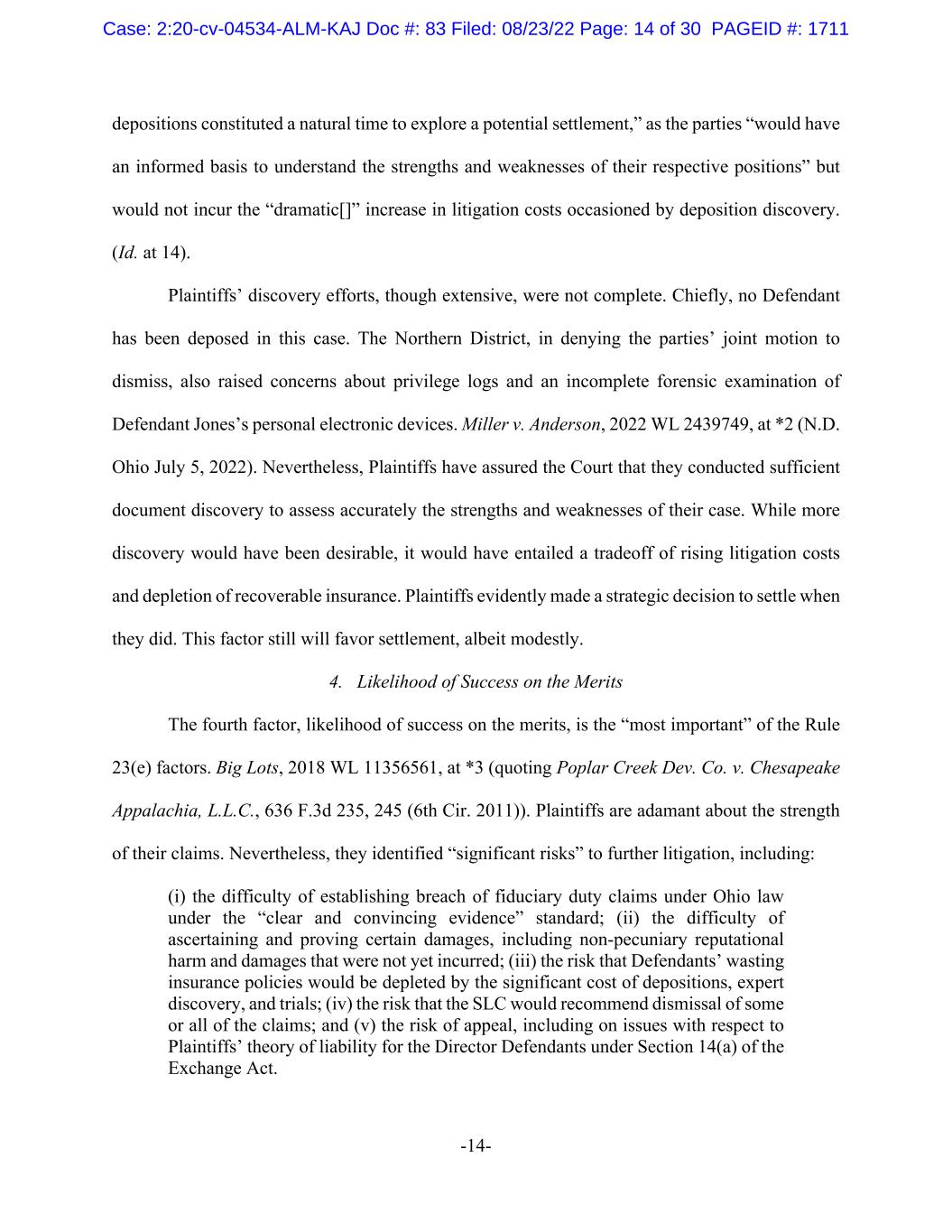
-14- depositions constituted a natural time to explore a potential settlement,” as the parties “would have an informed basis to understand the strengths and weaknesses of their respective positions” but would not incur the “dramatic[]” increase in litigation costs occasioned by deposition discovery. (Id. at 14). Plaintiffs’ discovery efforts, though extensive, were not complete. Chiefly, no Defendant has been deposed in this case. The Northern District, in denying the parties’ joint motion to dismiss, also raised concerns about privilege logs and an incomplete forensic examination of Defendant Jones’s personal electronic devices. Miller v. Anderson, 2022 WL 2439749, at *2 (N.D. Ohio July 5, 2022). Nevertheless, Plaintiffs have assured the Court that they conducted sufficient document discovery to assess accurately the strengths and weaknesses of their case. While more discovery would have been desirable, it would have entailed a tradeoff of rising litigation costs and depletion of recoverable insurance. Plaintiffs evidently made a strategic decision to settle when they did. This factor still will favor settlement, albeit modestly. 4. Likelihood of Success on the Merits The fourth factor, likelihood of success on the merits, is the “most important” of the Rule 23(e) factors. Big Lots, 2018 WL 11356561, at *3 (quoting Poplar Creek Dev. Co. v. Chesapeake Appalachia, L.L.C., 636 F.3d 235, 245 (6th Cir. 2011)). Plaintiffs are adamant about the strength of their claims. Nevertheless, they identified “significant risks” to further litigation, including: (i) the difficulty of establishing breach of fiduciary duty claims under Ohio law under the “clear and convincing evidence” standard; (ii) the difficulty of ascertaining and proving certain damages, including non-pecuniary reputational harm and damages that were not yet incurred; (iii) the risk that Defendants’ wasting insurance policies would be depleted by the significant cost of depositions, expert discovery, and trials; (iv) the risk that the SLC would recommend dismissal of some or all of the claims; and (v) the risk of appeal, including on issues with respect to Plaintiffs’ theory of liability for the Director Defendants under Section 14(a) of the Exchange Act. Case: 2:20-cv-04534-ALM-KAJ Doc #: 83 Filed: 08/23/22 Page: 14 of 30 PAGEID #: 1711
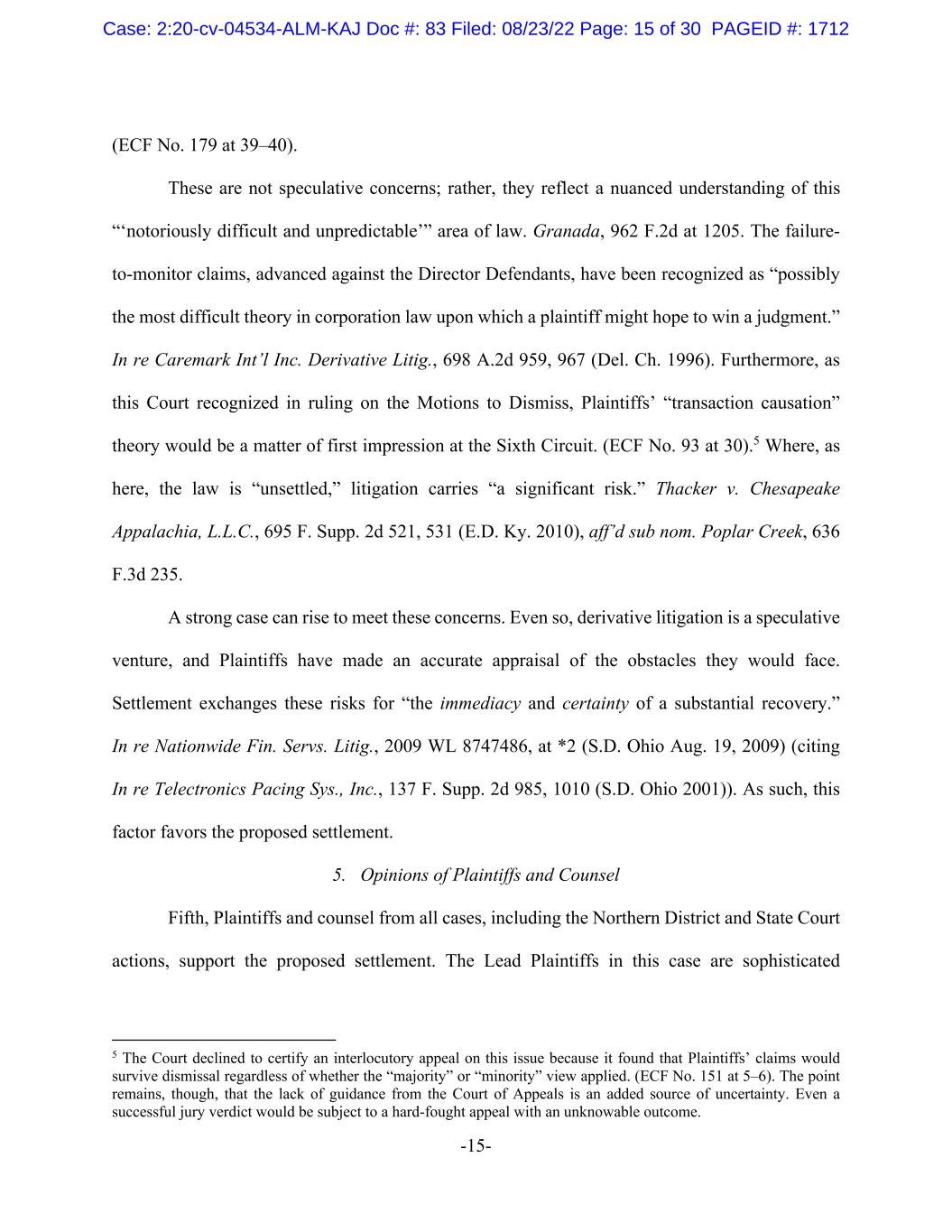
-15- (ECF No. 179 at 39–40). These are not speculative concerns; rather, they reflect a nuanced understanding of this “‘notoriously difficult and unpredictable’” area of law. Granada, 962 F.2d at 1205. The failure- to-monitor claims, advanced against the Director Defendants, have been recognized as “possibly the most difficult theory in corporation law upon which a plaintiff might hope to win a judgment.” In re Caremark Int’l Inc. Derivative Litig., 698 A.2d 959, 967 (Del. Ch. 1996). Furthermore, as this Court recognized in ruling on the Motions to Dismiss, Plaintiffs’ “transaction causation” theory would be a matter of first impression at the Sixth Circuit. (ECF No. 93 at 30).5 Where, as here, the law is “unsettled,” litigation carries “a significant risk.” Thacker v. Chesapeake Appalachia, L.L.C., 695 F. Supp. 2d 521, 531 (E.D. Ky. 2010), aff’d sub nom. Poplar Creek, 636 F.3d 235. A strong case can rise to meet these concerns. Even so, derivative litigation is a speculative venture, and Plaintiffs have made an accurate appraisal of the obstacles they would face. Settlement exchanges these risks for “the immediacy and certainty of a substantial recovery.” In re Nationwide Fin. Servs. Litig., 2009 WL 8747486, at *2 (S.D. Ohio Aug. 19, 2009) (citing In re Telectronics Pacing Sys., Inc., 137 F. Supp. 2d 985, 1010 (S.D. Ohio 2001)). As such, this factor favors the proposed settlement. 5. Opinions of Plaintiffs and Counsel Fifth, Plaintiffs and counsel from all cases, including the Northern District and State Court actions, support the proposed settlement. The Lead Plaintiffs in this case are sophisticated 5 The Court declined to certify an interlocutory appeal on this issue because it found that Plaintiffs’ claims would survive dismissal regardless of whether the “majority” or “minority” view applied. (ECF No. 151 at 5–6). The point remains, though, that the lack of guidance from the Court of Appeals is an added source of uncertainty. Even a successful jury verdict would be subject to a hard-fought appeal with an unknowable outcome. Case: 2:20-cv-04534-ALM-KAJ Doc #: 83 Filed: 08/23/22 Page: 15 of 30 PAGEID #: 1712
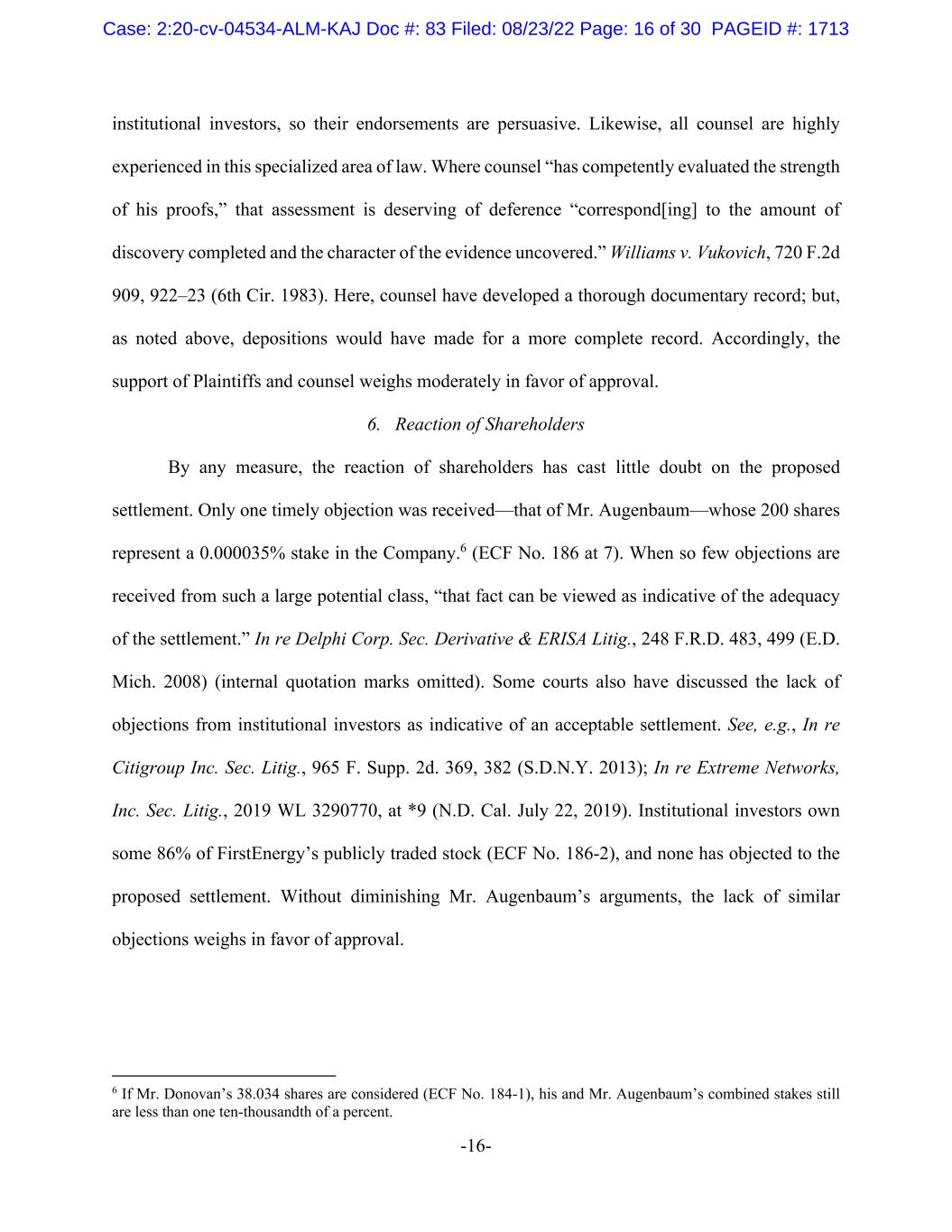
-16- institutional investors, so their endorsements are persuasive. Likewise, all counsel are highly experienced in this specialized area of law. Where counsel “has competently evaluated the strength of his proofs,” that assessment is deserving of deference “correspond[ing] to the amount of discovery completed and the character of the evidence uncovered.” Williams v. Vukovich, 720 F.2d 909, 922–23 (6th Cir. 1983). Here, counsel have developed a thorough documentary record; but, as noted above, depositions would have made for a more complete record. Accordingly, the support of Plaintiffs and counsel weighs moderately in favor of approval. 6. Reaction of Shareholders By any measure, the reaction of shareholders has cast little doubt on the proposed settlement. Only one timely objection was received—that of Mr. Augenbaum—whose 200 shares represent a 0.000035% stake in the Company.6 (ECF No. 186 at 7). When so few objections are received from such a large potential class, “that fact can be viewed as indicative of the adequacy of the settlement.” In re Delphi Corp. Sec. Derivative & ERISA Litig., 248 F.R.D. 483, 499 (E.D. Mich. 2008) (internal quotation marks omitted). Some courts also have discussed the lack of objections from institutional investors as indicative of an acceptable settlement. See, e.g., In re Citigroup Inc. Sec. Litig., 965 F. Supp. 2d. 369, 382 (S.D.N.Y. 2013); In re Extreme Networks, Inc. Sec. Litig., 2019 WL 3290770, at *9 (N.D. Cal. July 22, 2019). Institutional investors own some 86% of FirstEnergy’s publicly traded stock (ECF No. 186-2), and none has objected to the proposed settlement. Without diminishing Mr. Augenbaum’s arguments, the lack of similar objections weighs in favor of approval. 6 If Mr. Donovan’s 38.034 shares are considered (ECF No. 184-1), his and Mr. Augenbaum’s combined stakes still are less than one ten-thousandth of a percent. Case: 2:20-cv-04534-ALM-KAJ Doc #: 83 Filed: 08/23/22 Page: 16 of 30 PAGEID #: 1713
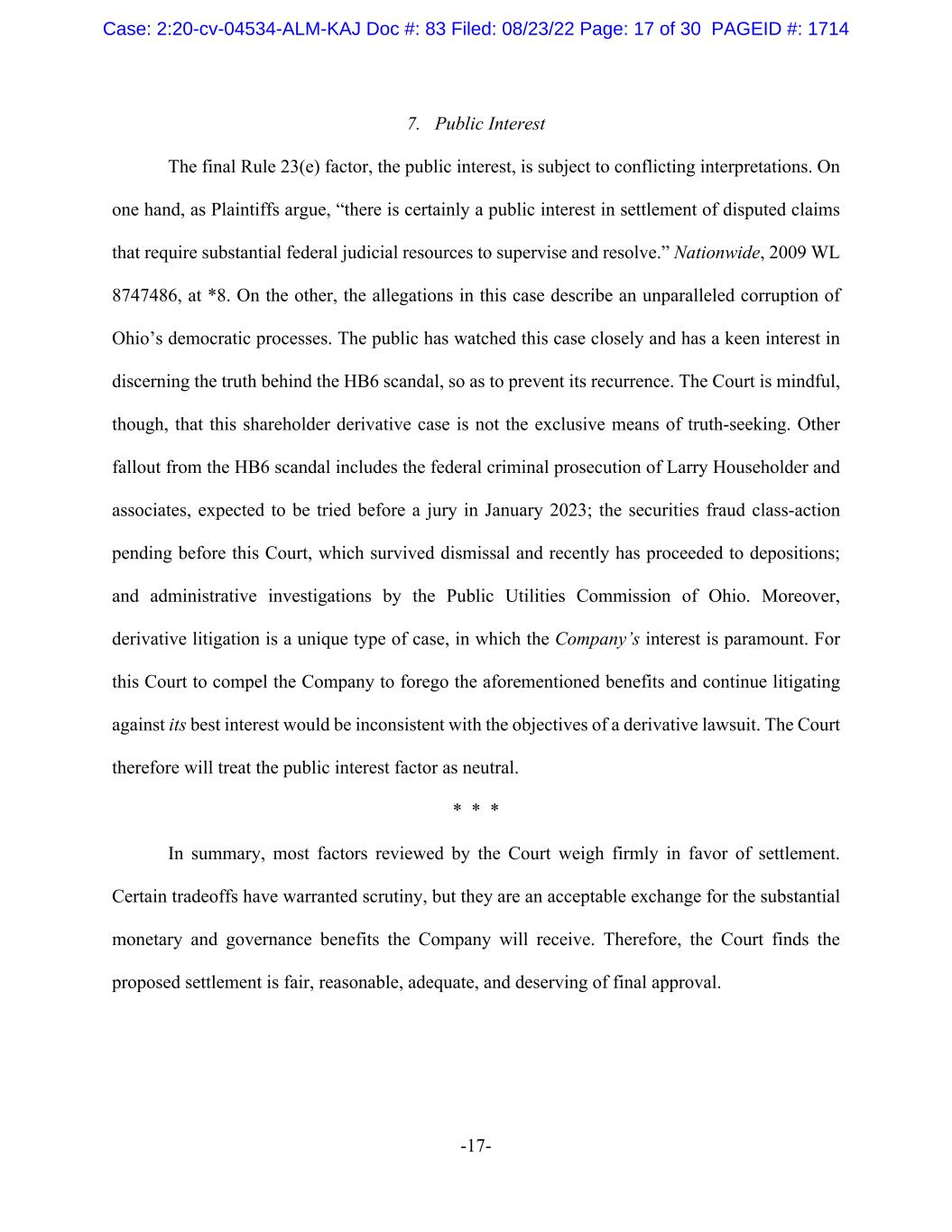
-17- 7. Public Interest The final Rule 23(e) factor, the public interest, is subject to conflicting interpretations. On one hand, as Plaintiffs argue, “there is certainly a public interest in settlement of disputed claims that require substantial federal judicial resources to supervise and resolve.” Nationwide, 2009 WL 8747486, at *8. On the other, the allegations in this case describe an unparalleled corruption of Ohio’s democratic processes. The public has watched this case closely and has a keen interest in discerning the truth behind the HB6 scandal, so as to prevent its recurrence. The Court is mindful, though, that this shareholder derivative case is not the exclusive means of truth-seeking. Other fallout from the HB6 scandal includes the federal criminal prosecution of Larry Householder and associates, expected to be tried before a jury in January 2023; the securities fraud class-action pending before this Court, which survived dismissal and recently has proceeded to depositions; and administrative investigations by the Public Utilities Commission of Ohio. Moreover, derivative litigation is a unique type of case, in which the Company’s interest is paramount. For this Court to compel the Company to forego the aforementioned benefits and continue litigating against its best interest would be inconsistent with the objectives of a derivative lawsuit. The Court therefore will treat the public interest factor as neutral. * * * In summary, most factors reviewed by the Court weigh firmly in favor of settlement. Certain tradeoffs have warranted scrutiny, but they are an acceptable exchange for the substantial monetary and governance benefits the Company will receive. Therefore, the Court finds the proposed settlement is fair, reasonable, adequate, and deserving of final approval. Case: 2:20-cv-04534-ALM-KAJ Doc #: 83 Filed: 08/23/22 Page: 17 of 30 PAGEID #: 1714
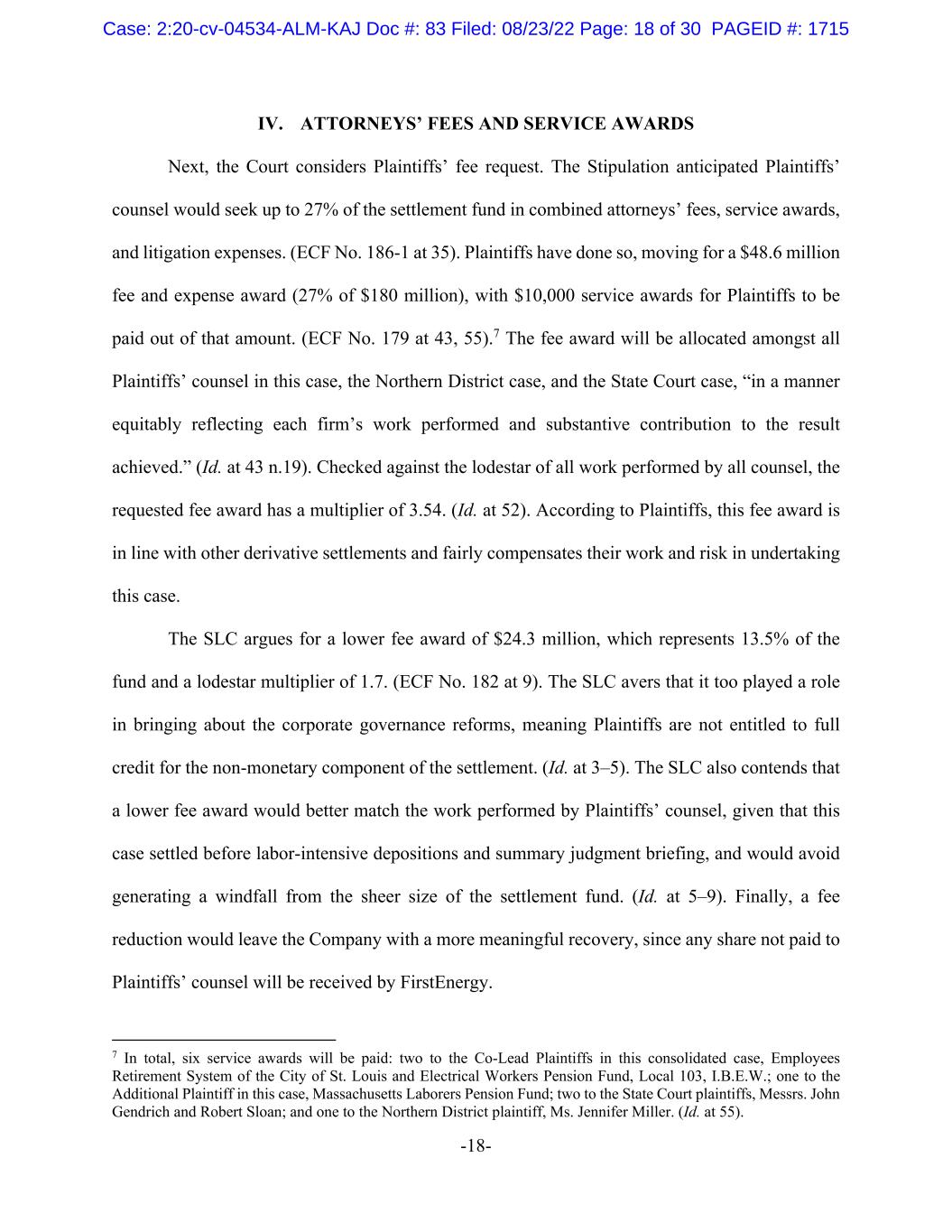
-18- IV. ATTORNEYS’ FEES AND SERVICE AWARDS Next, the Court considers Plaintiffs’ fee request. The Stipulation anticipated Plaintiffs’ counsel would seek up to 27% of the settlement fund in combined attorneys’ fees, service awards, and litigation expenses. (ECF No. 186-1 at 35). Plaintiffs have done so, moving for a $48.6 million fee and expense award (27% of $180 million), with $10,000 service awards for Plaintiffs to be paid out of that amount. (ECF No. 179 at 43, 55).7 The fee award will be allocated amongst all Plaintiffs’ counsel in this case, the Northern District case, and the State Court case, “in a manner equitably reflecting each firm’s work performed and substantive contribution to the result achieved.” (Id. at 43 n.19). Checked against the lodestar of all work performed by all counsel, the requested fee award has a multiplier of 3.54. (Id. at 52). According to Plaintiffs, this fee award is in line with other derivative settlements and fairly compensates their work and risk in undertaking this case. The SLC argues for a lower fee award of $24.3 million, which represents 13.5% of the fund and a lodestar multiplier of 1.7. (ECF No. 182 at 9). The SLC avers that it too played a role in bringing about the corporate governance reforms, meaning Plaintiffs are not entitled to full credit for the non-monetary component of the settlement. (Id. at 3–5). The SLC also contends that a lower fee award would better match the work performed by Plaintiffs’ counsel, given that this case settled before labor-intensive depositions and summary judgment briefing, and would avoid generating a windfall from the sheer size of the settlement fund. (Id. at 5–9). Finally, a fee reduction would leave the Company with a more meaningful recovery, since any share not paid to Plaintiffs’ counsel will be received by FirstEnergy. 7 In total, six service awards will be paid: two to the Co-Lead Plaintiffs in this consolidated case, Employees Retirement System of the City of St. Louis and Electrical Workers Pension Fund, Local 103, I.B.E.W.; one to the Additional Plaintiff in this case, Massachusetts Laborers Pension Fund; two to the State Court plaintiffs, Messrs. John Gendrich and Robert Sloan; and one to the Northern District plaintiff, Ms. Jennifer Miller. (Id. at 55). Case: 2:20-cv-04534-ALM-KAJ Doc #: 83 Filed: 08/23/22 Page: 18 of 30 PAGEID #: 1715
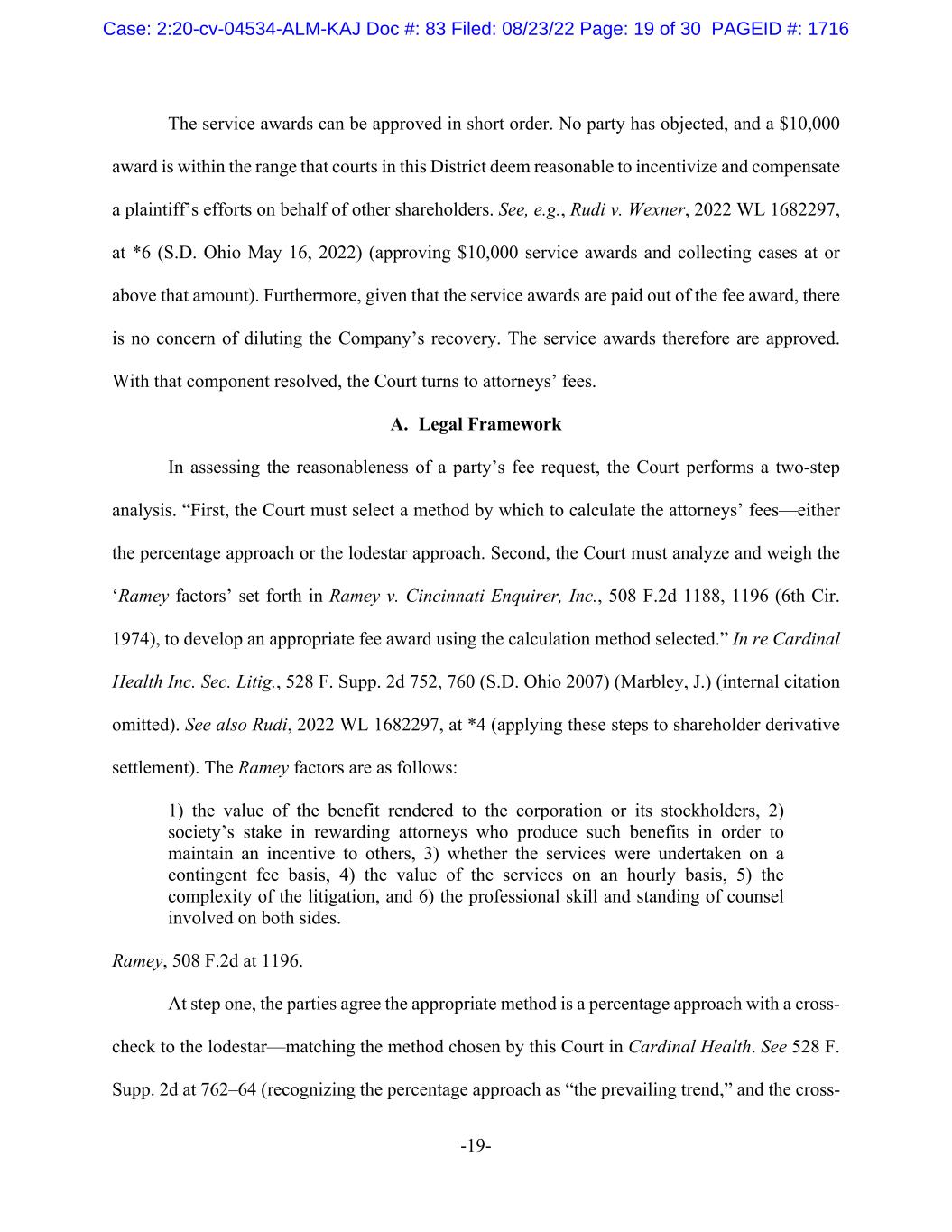
-19- The service awards can be approved in short order. No party has objected, and a $10,000 award is within the range that courts in this District deem reasonable to incentivize and compensate a plaintiff’s efforts on behalf of other shareholders. See, e.g., Rudi v. Wexner, 2022 WL 1682297, at *6 (S.D. Ohio May 16, 2022) (approving $10,000 service awards and collecting cases at or above that amount). Furthermore, given that the service awards are paid out of the fee award, there is no concern of diluting the Company’s recovery. The service awards therefore are approved. With that component resolved, the Court turns to attorneys’ fees. A. Legal Framework In assessing the reasonableness of a party’s fee request, the Court performs a two-step analysis. “First, the Court must select a method by which to calculate the attorneys’ fees—either the percentage approach or the lodestar approach. Second, the Court must analyze and weigh the ‘Ramey factors’ set forth in Ramey v. Cincinnati Enquirer, Inc., 508 F.2d 1188, 1196 (6th Cir. 1974), to develop an appropriate fee award using the calculation method selected.” In re Cardinal Health Inc. Sec. Litig., 528 F. Supp. 2d 752, 760 (S.D. Ohio 2007) (Marbley, J.) (internal citation omitted). See also Rudi, 2022 WL 1682297, at *4 (applying these steps to shareholder derivative settlement). The Ramey factors are as follows: 1) the value of the benefit rendered to the corporation or its stockholders, 2) society’s stake in rewarding attorneys who produce such benefits in order to maintain an incentive to others, 3) whether the services were undertaken on a contingent fee basis, 4) the value of the services on an hourly basis, 5) the complexity of the litigation, and 6) the professional skill and standing of counsel involved on both sides. Ramey, 508 F.2d at 1196. At step one, the parties agree the appropriate method is a percentage approach with a cross- check to the lodestar—matching the method chosen by this Court in Cardinal Health. See 528 F. Supp. 2d at 762–64 (recognizing the percentage approach as “the prevailing trend,” and the cross- Case: 2:20-cv-04534-ALM-KAJ Doc #: 83 Filed: 08/23/22 Page: 19 of 30 PAGEID #: 1716
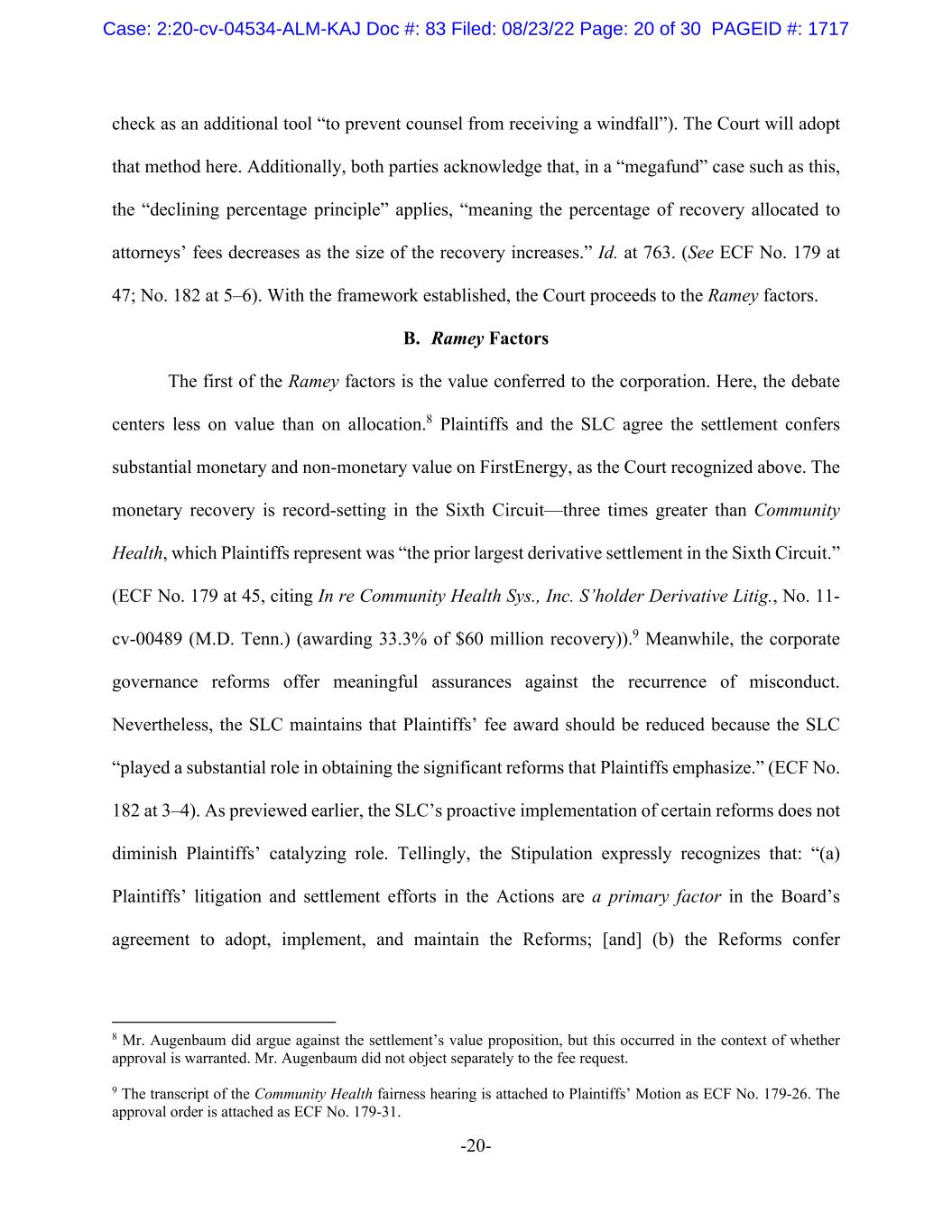
-20- check as an additional tool “to prevent counsel from receiving a windfall”). The Court will adopt that method here. Additionally, both parties acknowledge that, in a “megafund” case such as this, the “declining percentage principle” applies, “meaning the percentage of recovery allocated to attorneys’ fees decreases as the size of the recovery increases.” Id. at 763. (See ECF No. 179 at 47; No. 182 at 5–6). With the framework established, the Court proceeds to the Ramey factors. B. Ramey Factors The first of the Ramey factors is the value conferred to the corporation. Here, the debate centers less on value than on allocation.8 Plaintiffs and the SLC agree the settlement confers substantial monetary and non-monetary value on FirstEnergy, as the Court recognized above. The monetary recovery is record-setting in the Sixth Circuit—three times greater than Community Health, which Plaintiffs represent was “the prior largest derivative settlement in the Sixth Circuit.” (ECF No. 179 at 45, citing In re Community Health Sys., Inc. S’holder Derivative Litig., No. 11- cv-00489 (M.D. Tenn.) (awarding 33.3% of $60 million recovery)).9 Meanwhile, the corporate governance reforms offer meaningful assurances against the recurrence of misconduct. Nevertheless, the SLC maintains that Plaintiffs’ fee award should be reduced because the SLC “played a substantial role in obtaining the significant reforms that Plaintiffs emphasize.” (ECF No. 182 at 3–4). As previewed earlier, the SLC’s proactive implementation of certain reforms does not diminish Plaintiffs’ catalyzing role. Tellingly, the Stipulation expressly recognizes that: “(a) Plaintiffs’ litigation and settlement efforts in the Actions are a primary factor in the Board’s agreement to adopt, implement, and maintain the Reforms; [and] (b) the Reforms confer 8 Mr. Augenbaum did argue against the settlement’s value proposition, but this occurred in the context of whether approval is warranted. Mr. Augenbaum did not object separately to the fee request. 9 The transcript of the Community Health fairness hearing is attached to Plaintiffs’ Motion as ECF No. 179-26. The approval order is attached as ECF No. 179-31. Case: 2:20-cv-04534-ALM-KAJ Doc #: 83 Filed: 08/23/22 Page: 20 of 30 PAGEID #: 1717
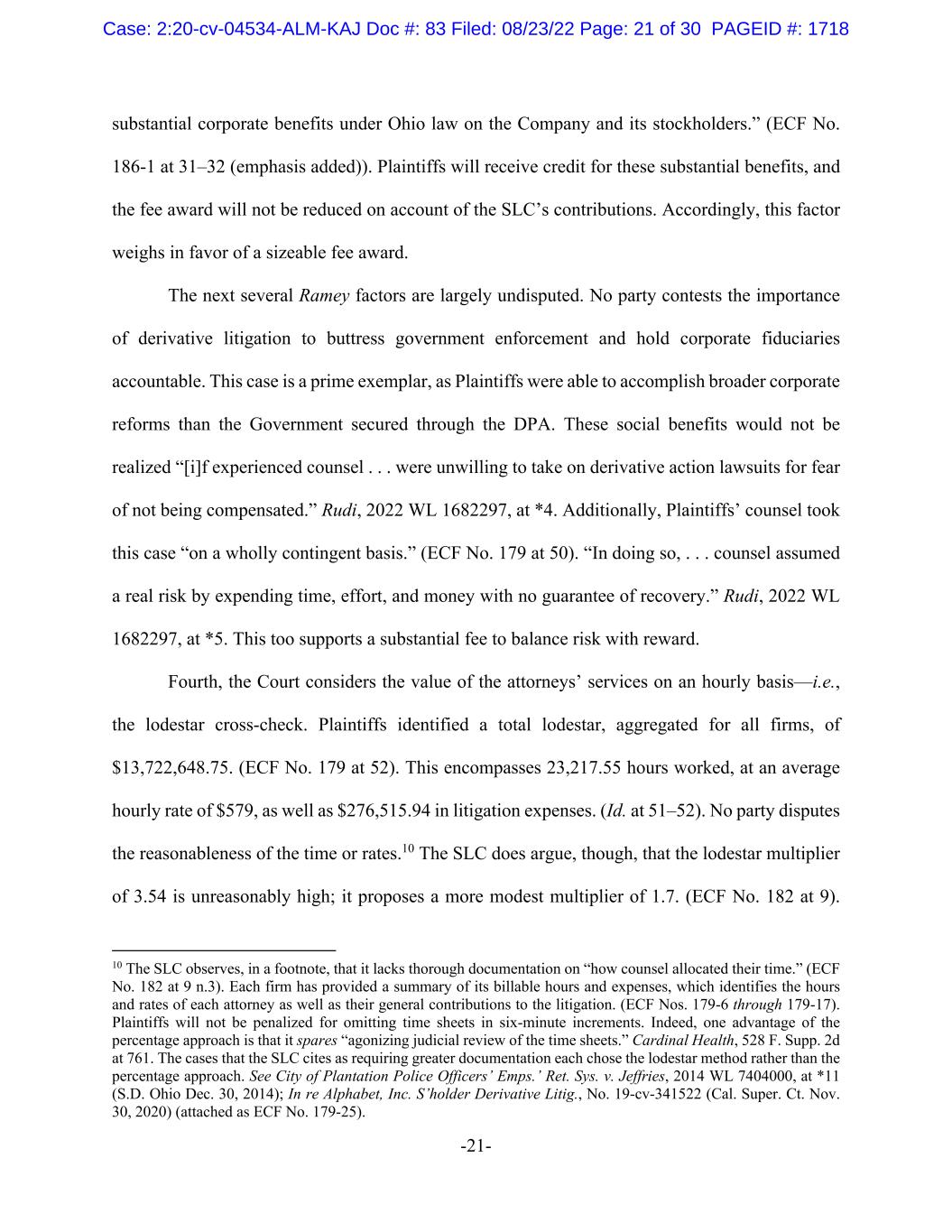
-21- substantial corporate benefits under Ohio law on the Company and its stockholders.” (ECF No. 186-1 at 31–32 (emphasis added)). Plaintiffs will receive credit for these substantial benefits, and the fee award will not be reduced on account of the SLC’s contributions. Accordingly, this factor weighs in favor of a sizeable fee award. The next several Ramey factors are largely undisputed. No party contests the importance of derivative litigation to buttress government enforcement and hold corporate fiduciaries accountable. This case is a prime exemplar, as Plaintiffs were able to accomplish broader corporate reforms than the Government secured through the DPA. These social benefits would not be realized “[i]f experienced counsel . . . were unwilling to take on derivative action lawsuits for fear of not being compensated.” Rudi, 2022 WL 1682297, at *4. Additionally, Plaintiffs’ counsel took this case “on a wholly contingent basis.” (ECF No. 179 at 50). “In doing so, . . . counsel assumed a real risk by expending time, effort, and money with no guarantee of recovery.” Rudi, 2022 WL 1682297, at *5. This too supports a substantial fee to balance risk with reward. Fourth, the Court considers the value of the attorneys’ services on an hourly basis—i.e., the lodestar cross-check. Plaintiffs identified a total lodestar, aggregated for all firms, of $13,722,648.75. (ECF No. 179 at 52). This encompasses 23,217.55 hours worked, at an average hourly rate of $579, as well as $276,515.94 in litigation expenses. (Id. at 51–52). No party disputes the reasonableness of the time or rates.10 The SLC does argue, though, that the lodestar multiplier of 3.54 is unreasonably high; it proposes a more modest multiplier of 1.7. (ECF No. 182 at 9). 10 The SLC observes, in a footnote, that it lacks thorough documentation on “how counsel allocated their time.” (ECF No. 182 at 9 n.3). Each firm has provided a summary of its billable hours and expenses, which identifies the hours and rates of each attorney as well as their general contributions to the litigation. (ECF Nos. 179-6 through 179-17). Plaintiffs will not be penalized for omitting time sheets in six-minute increments. Indeed, one advantage of the percentage approach is that it spares “agonizing judicial review of the time sheets.” Cardinal Health, 528 F. Supp. 2d at 761. The cases that the SLC cites as requiring greater documentation each chose the lodestar method rather than the percentage approach. See City of Plantation Police Officers’ Emps.’ Ret. Sys. v. Jeffries, 2014 WL 7404000, at *11 (S.D. Ohio Dec. 30, 2014); In re Alphabet, Inc. S’holder Derivative Litig., No. 19-cv-341522 (Cal. Super. Ct. Nov. 30, 2020) (attached as ECF No. 179-25). Case: 2:20-cv-04534-ALM-KAJ Doc #: 83 Filed: 08/23/22 Page: 21 of 30 PAGEID #: 1718
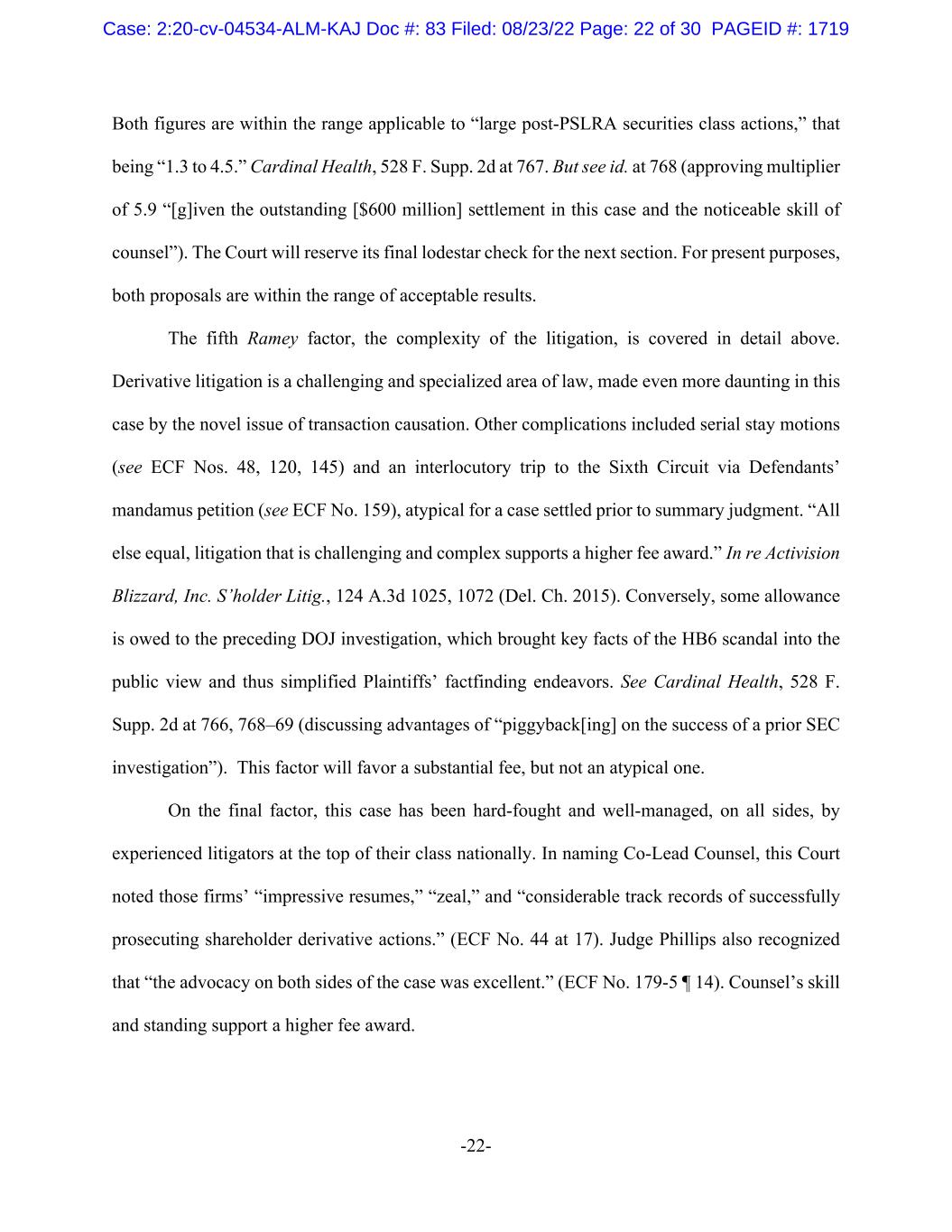
-22- Both figures are within the range applicable to “large post-PSLRA securities class actions,” that being “1.3 to 4.5.” Cardinal Health, 528 F. Supp. 2d at 767. But see id. at 768 (approving multiplier of 5.9 “[g]iven the outstanding [$600 million] settlement in this case and the noticeable skill of counsel”). The Court will reserve its final lodestar check for the next section. For present purposes, both proposals are within the range of acceptable results. The fifth Ramey factor, the complexity of the litigation, is covered in detail above. Derivative litigation is a challenging and specialized area of law, made even more daunting in this case by the novel issue of transaction causation. Other complications included serial stay motions (see ECF Nos. 48, 120, 145) and an interlocutory trip to the Sixth Circuit via Defendants’ mandamus petition (see ECF No. 159), atypical for a case settled prior to summary judgment. “All else equal, litigation that is challenging and complex supports a higher fee award.” In re Activision Blizzard, Inc. S’holder Litig., 124 A.3d 1025, 1072 (Del. Ch. 2015). Conversely, some allowance is owed to the preceding DOJ investigation, which brought key facts of the HB6 scandal into the public view and thus simplified Plaintiffs’ factfinding endeavors. See Cardinal Health, 528 F. Supp. 2d at 766, 768–69 (discussing advantages of “piggyback[ing] on the success of a prior SEC investigation”). This factor will favor a substantial fee, but not an atypical one. On the final factor, this case has been hard-fought and well-managed, on all sides, by experienced litigators at the top of their class nationally. In naming Co-Lead Counsel, this Court noted those firms’ “impressive resumes,” “zeal,” and “considerable track records of successfully prosecuting shareholder derivative actions.” (ECF No. 44 at 17). Judge Phillips also recognized that “the advocacy on both sides of the case was excellent.” (ECF No. 179-5 ¶ 14). Counsel’s skill and standing support a higher fee award. Case: 2:20-cv-04534-ALM-KAJ Doc #: 83 Filed: 08/23/22 Page: 22 of 30 PAGEID #: 1719
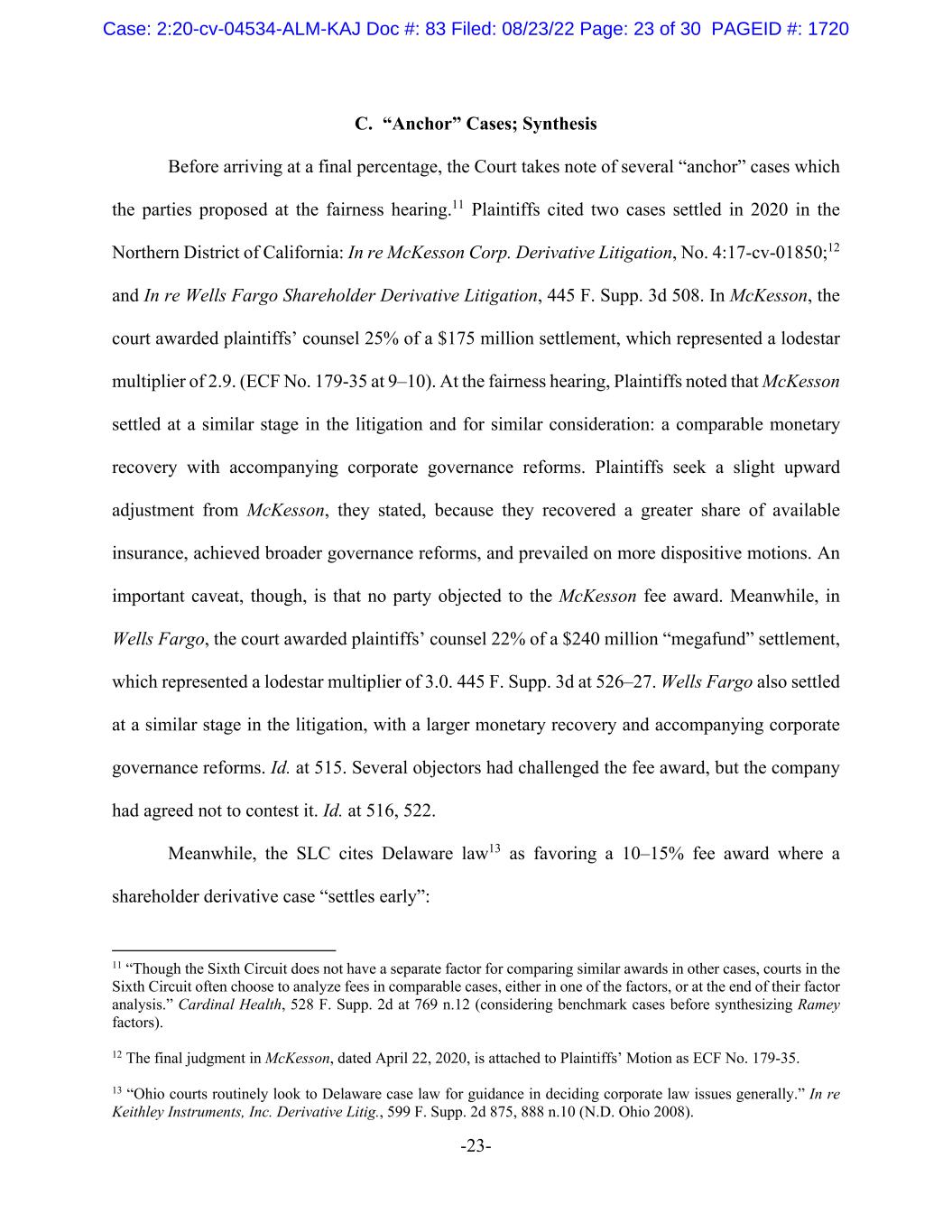
-23- C. “Anchor” Cases; Synthesis Before arriving at a final percentage, the Court takes note of several “anchor” cases which the parties proposed at the fairness hearing.11 Plaintiffs cited two cases settled in 2020 in the Northern District of California: In re McKesson Corp. Derivative Litigation, No. 4:17-cv-01850;12 and In re Wells Fargo Shareholder Derivative Litigation, 445 F. Supp. 3d 508. In McKesson, the court awarded plaintiffs’ counsel 25% of a $175 million settlement, which represented a lodestar multiplier of 2.9. (ECF No. 179-35 at 9–10). At the fairness hearing, Plaintiffs noted that McKesson settled at a similar stage in the litigation and for similar consideration: a comparable monetary recovery with accompanying corporate governance reforms. Plaintiffs seek a slight upward adjustment from McKesson, they stated, because they recovered a greater share of available insurance, achieved broader governance reforms, and prevailed on more dispositive motions. An important caveat, though, is that no party objected to the McKesson fee award. Meanwhile, in Wells Fargo, the court awarded plaintiffs’ counsel 22% of a $240 million “megafund” settlement, which represented a lodestar multiplier of 3.0. 445 F. Supp. 3d at 526–27. Wells Fargo also settled at a similar stage in the litigation, with a larger monetary recovery and accompanying corporate governance reforms. Id. at 515. Several objectors had challenged the fee award, but the company had agreed not to contest it. Id. at 516, 522. Meanwhile, the SLC cites Delaware law13 as favoring a 10–15% fee award where a shareholder derivative case “settles early”: 11 “Though the Sixth Circuit does not have a separate factor for comparing similar awards in other cases, courts in the Sixth Circuit often choose to analyze fees in comparable cases, either in one of the factors, or at the end of their factor analysis.” Cardinal Health, 528 F. Supp. 2d at 769 n.12 (considering benchmark cases before synthesizing Ramey factors). 12 The final judgment in McKesson, dated April 22, 2020, is attached to Plaintiffs’ Motion as ECF No. 179-35. 13 “Ohio courts routinely look to Delaware case law for guidance in deciding corporate law issues generally.” In re Keithley Instruments, Inc. Derivative Litig., 599 F. Supp. 2d 875, 888 n.10 (N.D. Ohio 2008). Case: 2:20-cv-04534-ALM-KAJ Doc #: 83 Filed: 08/23/22 Page: 23 of 30 PAGEID #: 1720
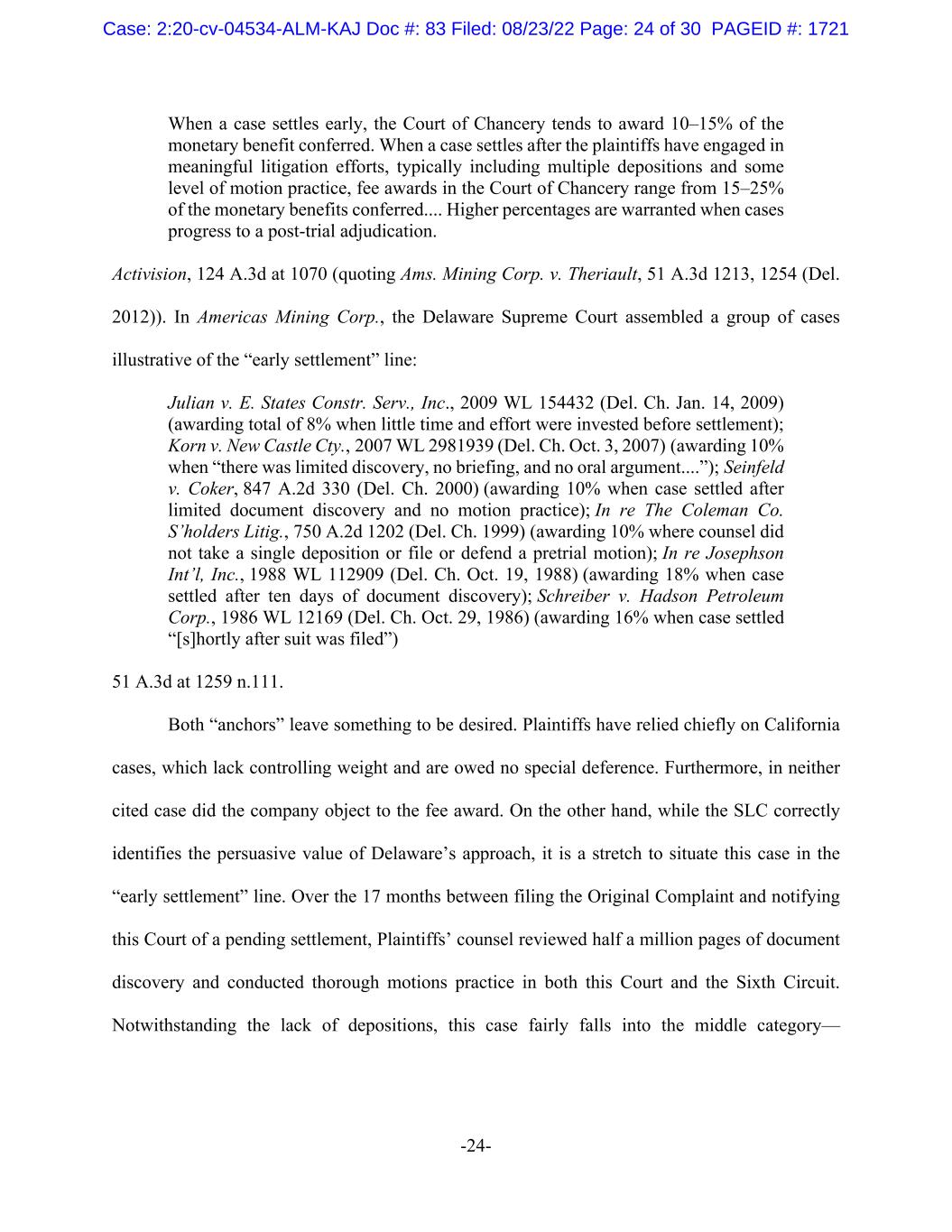
-24- When a case settles early, the Court of Chancery tends to award 10–15% of the monetary benefit conferred. When a case settles after the plaintiffs have engaged in meaningful litigation efforts, typically including multiple depositions and some level of motion practice, fee awards in the Court of Chancery range from 15–25% of the monetary benefits conferred.... Higher percentages are warranted when cases progress to a post-trial adjudication. Activision, 124 A.3d at 1070 (quoting Ams. Mining Corp. v. Theriault, 51 A.3d 1213, 1254 (Del. 2012)). In Americas Mining Corp., the Delaware Supreme Court assembled a group of cases illustrative of the “early settlement” line: Julian v. E. States Constr. Serv., Inc., 2009 WL 154432 (Del. Ch. Jan. 14, 2009) (awarding total of 8% when little time and effort were invested before settlement); Korn v. New Castle Cty., 2007 WL 2981939 (Del. Ch. Oct. 3, 2007) (awarding 10% when “there was limited discovery, no briefing, and no oral argument....”); Seinfeld v. Coker, 847 A.2d 330 (Del. Ch. 2000) (awarding 10% when case settled after limited document discovery and no motion practice); In re The Coleman Co. S’holders Litig., 750 A.2d 1202 (Del. Ch. 1999) (awarding 10% where counsel did not take a single deposition or file or defend a pretrial motion); In re Josephson Int’l, Inc., 1988 WL 112909 (Del. Ch. Oct. 19, 1988) (awarding 18% when case settled after ten days of document discovery); Schreiber v. Hadson Petroleum Corp., 1986 WL 12169 (Del. Ch. Oct. 29, 1986) (awarding 16% when case settled “[s]hortly after suit was filed”) 51 A.3d at 1259 n.111. Both “anchors” leave something to be desired. Plaintiffs have relied chiefly on California cases, which lack controlling weight and are owed no special deference. Furthermore, in neither cited case did the company object to the fee award. On the other hand, while the SLC correctly identifies the persuasive value of Delaware’s approach, it is a stretch to situate this case in the “early settlement” line. Over the 17 months between filing the Original Complaint and notifying this Court of a pending settlement, Plaintiffs’ counsel reviewed half a million pages of document discovery and conducted thorough motions practice in both this Court and the Sixth Circuit. Notwithstanding the lack of depositions, this case fairly falls into the middle category— Case: 2:20-cv-04534-ALM-KAJ Doc #: 83 Filed: 08/23/22 Page: 24 of 30 PAGEID #: 1721
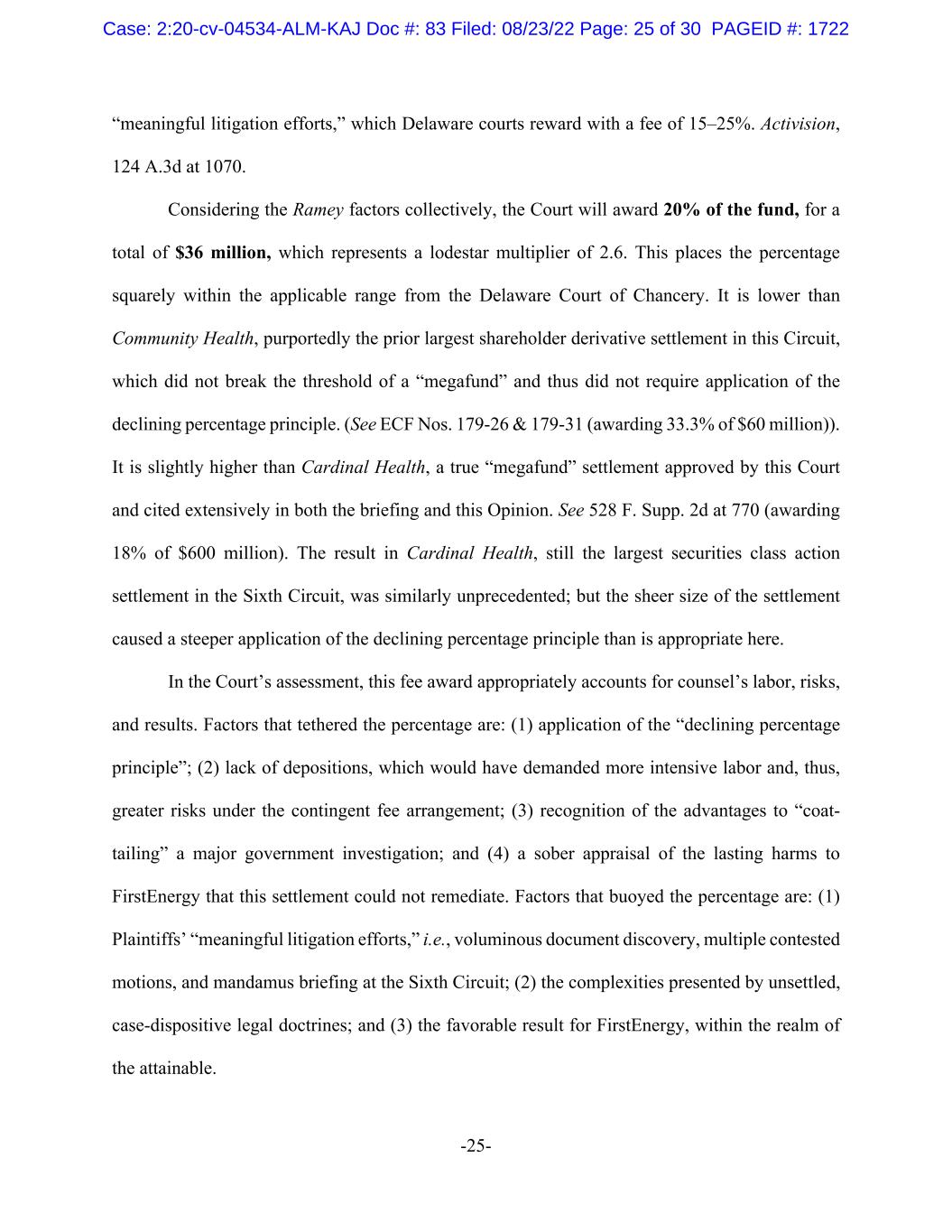
-25- “meaningful litigation efforts,” which Delaware courts reward with a fee of 15–25%. Activision, 124 A.3d at 1070. Considering the Ramey factors collectively, the Court will award 20% of the fund, for a total of $36 million, which represents a lodestar multiplier of 2.6. This places the percentage squarely within the applicable range from the Delaware Court of Chancery. It is lower than Community Health, purportedly the prior largest shareholder derivative settlement in this Circuit, which did not break the threshold of a “megafund” and thus did not require application of the declining percentage principle. (See ECF Nos. 179-26 & 179-31 (awarding 33.3% of $60 million)). It is slightly higher than Cardinal Health, a true “megafund” settlement approved by this Court and cited extensively in both the briefing and this Opinion. See 528 F. Supp. 2d at 770 (awarding 18% of $600 million). The result in Cardinal Health, still the largest securities class action settlement in the Sixth Circuit, was similarly unprecedented; but the sheer size of the settlement caused a steeper application of the declining percentage principle than is appropriate here. In the Court’s assessment, this fee award appropriately accounts for counsel’s labor, risks, and results. Factors that tethered the percentage are: (1) application of the “declining percentage principle”; (2) lack of depositions, which would have demanded more intensive labor and, thus, greater risks under the contingent fee arrangement; (3) recognition of the advantages to “coat- tailing” a major government investigation; and (4) a sober appraisal of the lasting harms to FirstEnergy that this settlement could not remediate. Factors that buoyed the percentage are: (1) Plaintiffs’ “meaningful litigation efforts,” i.e., voluminous document discovery, multiple contested motions, and mandamus briefing at the Sixth Circuit; (2) the complexities presented by unsettled, case-dispositive legal doctrines; and (3) the favorable result for FirstEnergy, within the realm of the attainable. Case: 2:20-cv-04534-ALM-KAJ Doc #: 83 Filed: 08/23/22 Page: 25 of 30 PAGEID #: 1722
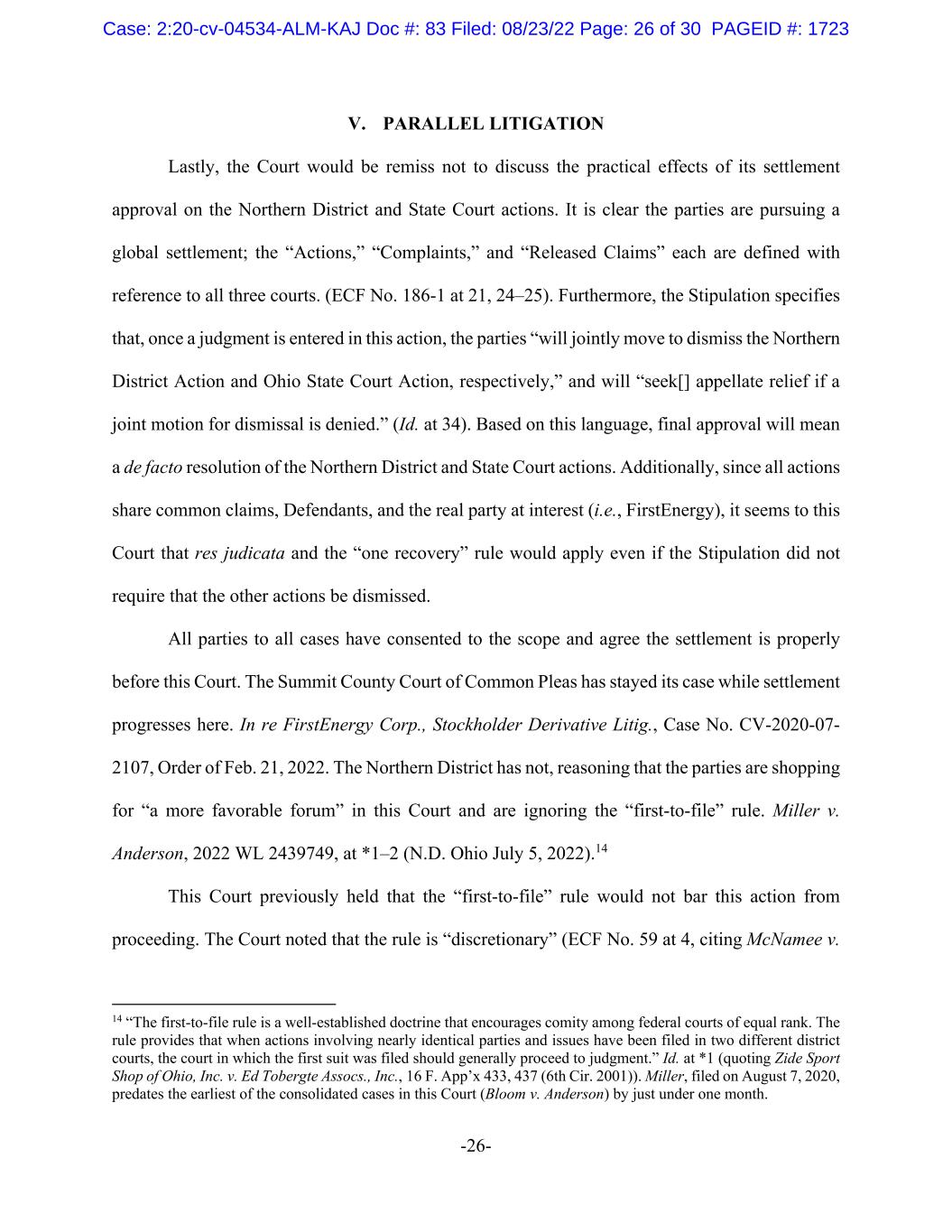
-26- V. PARALLEL LITIGATION Lastly, the Court would be remiss not to discuss the practical effects of its settlement approval on the Northern District and State Court actions. It is clear the parties are pursuing a global settlement; the “Actions,” “Complaints,” and “Released Claims” each are defined with reference to all three courts. (ECF No. 186-1 at 21, 24–25). Furthermore, the Stipulation specifies that, once a judgment is entered in this action, the parties “will jointly move to dismiss the Northern District Action and Ohio State Court Action, respectively,” and will “seek[] appellate relief if a joint motion for dismissal is denied.” (Id. at 34). Based on this language, final approval will mean a de facto resolution of the Northern District and State Court actions. Additionally, since all actions share common claims, Defendants, and the real party at interest (i.e., FirstEnergy), it seems to this Court that res judicata and the “one recovery” rule would apply even if the Stipulation did not require that the other actions be dismissed. All parties to all cases have consented to the scope and agree the settlement is properly before this Court. The Summit County Court of Common Pleas has stayed its case while settlement progresses here. In re FirstEnergy Corp., Stockholder Derivative Litig., Case No. CV-2020-07- 2107, Order of Feb. 21, 2022. The Northern District has not, reasoning that the parties are shopping for “a more favorable forum” in this Court and are ignoring the “first-to-file” rule. Miller v. Anderson, 2022 WL 2439749, at *1–2 (N.D. Ohio July 5, 2022).14 This Court previously held that the “first-to-file” rule would not bar this action from proceeding. The Court noted that the rule is “discretionary” (ECF No. 59 at 4, citing McNamee v. 14 “The first-to-file rule is a well-established doctrine that encourages comity among federal courts of equal rank. The rule provides that when actions involving nearly identical parties and issues have been filed in two different district courts, the court in which the first suit was filed should generally proceed to judgment.” Id. at *1 (quoting Zide Sport Shop of Ohio, Inc. v. Ed Tobergte Assocs., Inc., 16 F. App’x 433, 437 (6th Cir. 2001)). Miller, filed on August 7, 2020, predates the earliest of the consolidated cases in this Court (Bloom v. Anderson) by just under one month. Case: 2:20-cv-04534-ALM-KAJ Doc #: 83 Filed: 08/23/22 Page: 26 of 30 PAGEID #: 1723
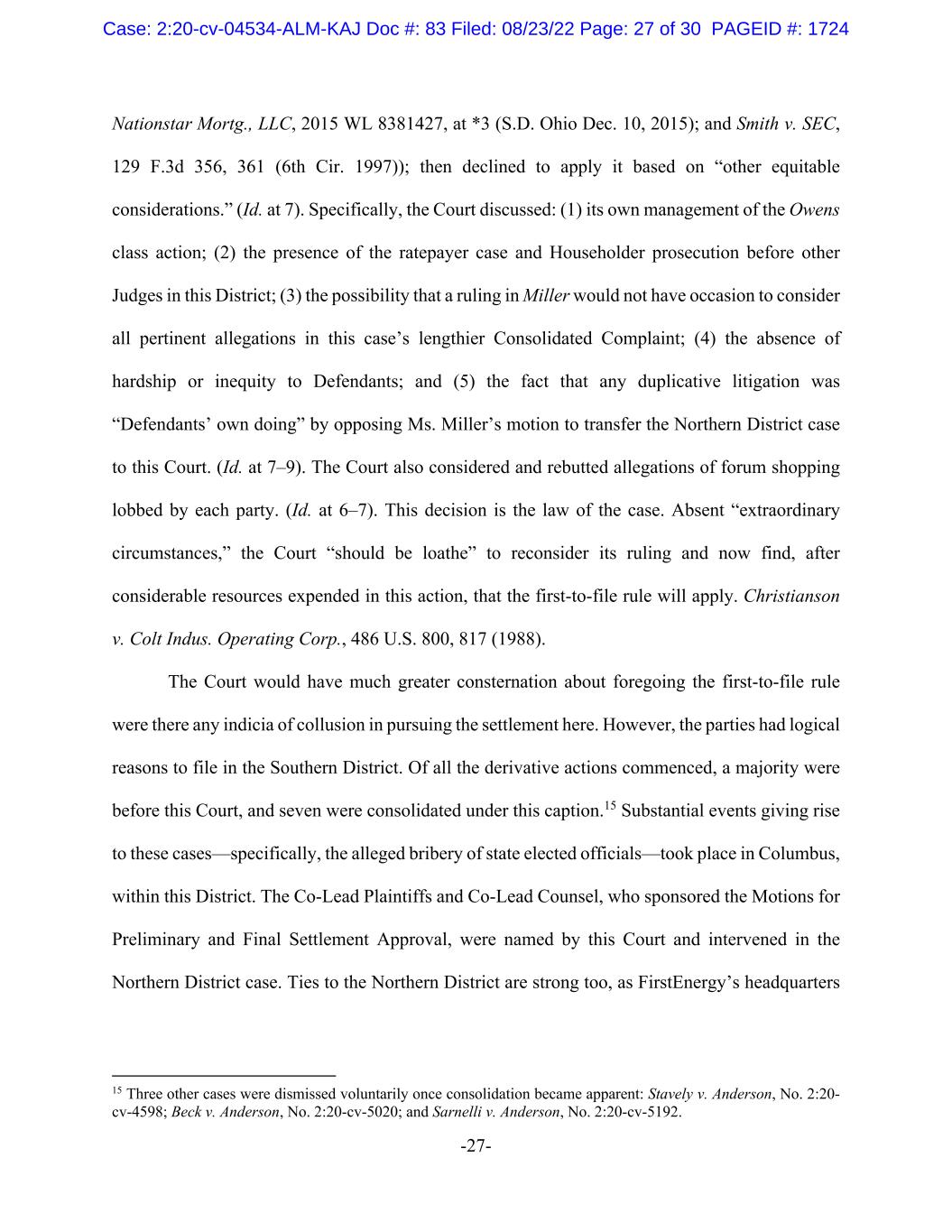
-27- Nationstar Mortg., LLC, 2015 WL 8381427, at *3 (S.D. Ohio Dec. 10, 2015); and Smith v. SEC, 129 F.3d 356, 361 (6th Cir. 1997)); then declined to apply it based on “other equitable considerations.” (Id. at 7). Specifically, the Court discussed: (1) its own management of the Owens class action; (2) the presence of the ratepayer case and Householder prosecution before other Judges in this District; (3) the possibility that a ruling in Miller would not have occasion to consider all pertinent allegations in this case’s lengthier Consolidated Complaint; (4) the absence of hardship or inequity to Defendants; and (5) the fact that any duplicative litigation was “Defendants’ own doing” by opposing Ms. Miller’s motion to transfer the Northern District case to this Court. (Id. at 7–9). The Court also considered and rebutted allegations of forum shopping lobbed by each party. (Id. at 6–7). This decision is the law of the case. Absent “extraordinary circumstances,” the Court “should be loathe” to reconsider its ruling and now find, after considerable resources expended in this action, that the first-to-file rule will apply. Christianson v. Colt Indus. Operating Corp., 486 U.S. 800, 817 (1988). The Court would have much greater consternation about foregoing the first-to-file rule were there any indicia of collusion in pursuing the settlement here. However, the parties had logical reasons to file in the Southern District. Of all the derivative actions commenced, a majority were before this Court, and seven were consolidated under this caption.15 Substantial events giving rise to these cases—specifically, the alleged bribery of state elected officials—took place in Columbus, within this District. The Co-Lead Plaintiffs and Co-Lead Counsel, who sponsored the Motions for Preliminary and Final Settlement Approval, were named by this Court and intervened in the Northern District case. Ties to the Northern District are strong too, as FirstEnergy’s headquarters 15 Three other cases were dismissed voluntarily once consolidation became apparent: Stavely v. Anderson, No. 2:20- cv-4598; Beck v. Anderson, No. 2:20-cv-5020; and Sarnelli v. Anderson, No. 2:20-cv-5192. Case: 2:20-cv-04534-ALM-KAJ Doc #: 83 Filed: 08/23/22 Page: 27 of 30 PAGEID #: 1724
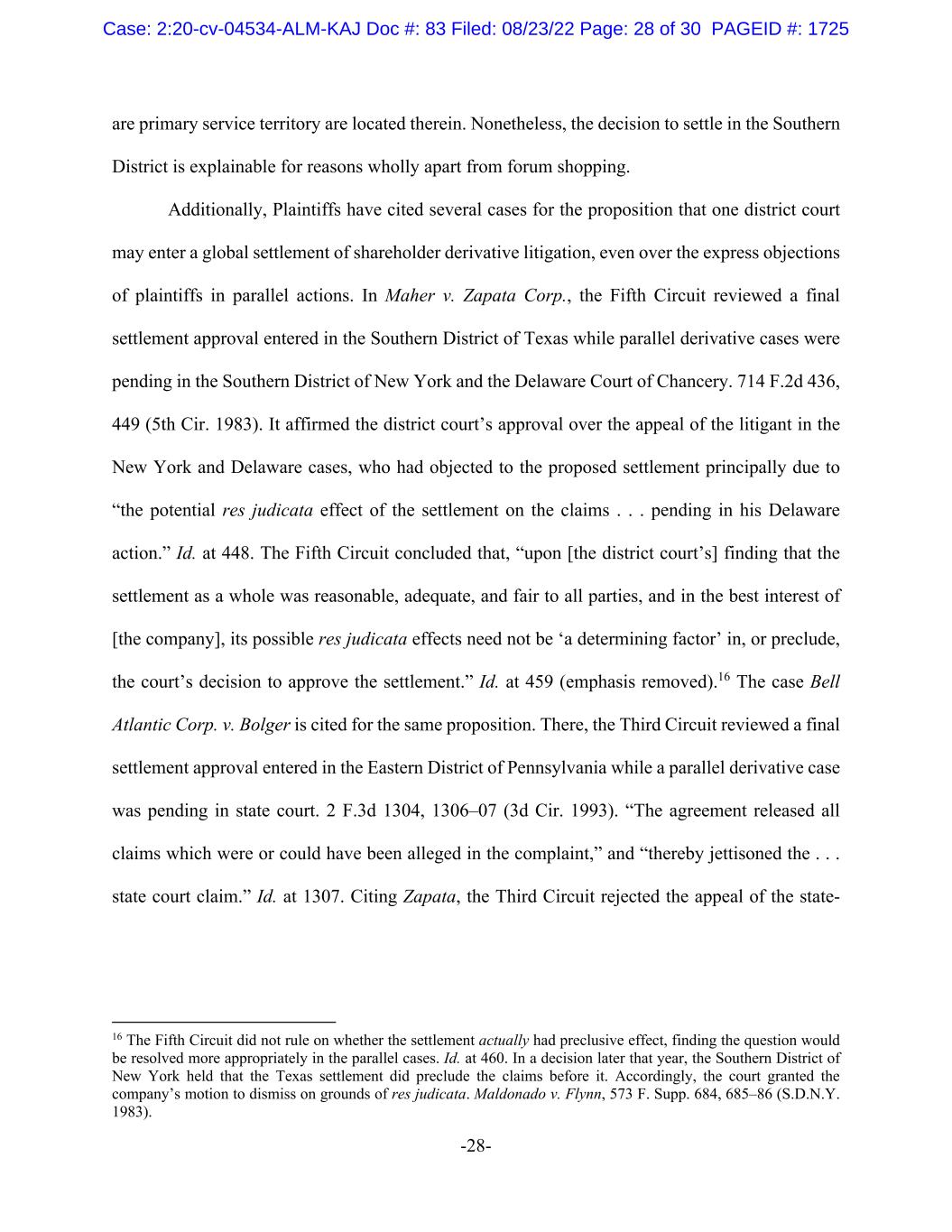
-28- are primary service territory are located therein. Nonetheless, the decision to settle in the Southern District is explainable for reasons wholly apart from forum shopping. Additionally, Plaintiffs have cited several cases for the proposition that one district court may enter a global settlement of shareholder derivative litigation, even over the express objections of plaintiffs in parallel actions. In Maher v. Zapata Corp., the Fifth Circuit reviewed a final settlement approval entered in the Southern District of Texas while parallel derivative cases were pending in the Southern District of New York and the Delaware Court of Chancery. 714 F.2d 436, 449 (5th Cir. 1983). It affirmed the district court’s approval over the appeal of the litigant in the New York and Delaware cases, who had objected to the proposed settlement principally due to “the potential res judicata effect of the settlement on the claims . . . pending in his Delaware action.” Id. at 448. The Fifth Circuit concluded that, “upon [the district court’s] finding that the settlement as a whole was reasonable, adequate, and fair to all parties, and in the best interest of [the company], its possible res judicata effects need not be ‘a determining factor’ in, or preclude, the court’s decision to approve the settlement.” Id. at 459 (emphasis removed).16 The case Bell Atlantic Corp. v. Bolger is cited for the same proposition. There, the Third Circuit reviewed a final settlement approval entered in the Eastern District of Pennsylvania while a parallel derivative case was pending in state court. 2 F.3d 1304, 1306–07 (3d Cir. 1993). “The agreement released all claims which were or could have been alleged in the complaint,” and “thereby jettisoned the . . . state court claim.” Id. at 1307. Citing Zapata, the Third Circuit rejected the appeal of the state- 16 The Fifth Circuit did not rule on whether the settlement actually had preclusive effect, finding the question would be resolved more appropriately in the parallel cases. Id. at 460. In a decision later that year, the Southern District of New York held that the Texas settlement did preclude the claims before it. Accordingly, the court granted the company’s motion to dismiss on grounds of res judicata. Maldonado v. Flynn, 573 F. Supp. 684, 685–86 (S.D.N.Y. 1983). Case: 2:20-cv-04534-ALM-KAJ Doc #: 83 Filed: 08/23/22 Page: 28 of 30 PAGEID #: 1725
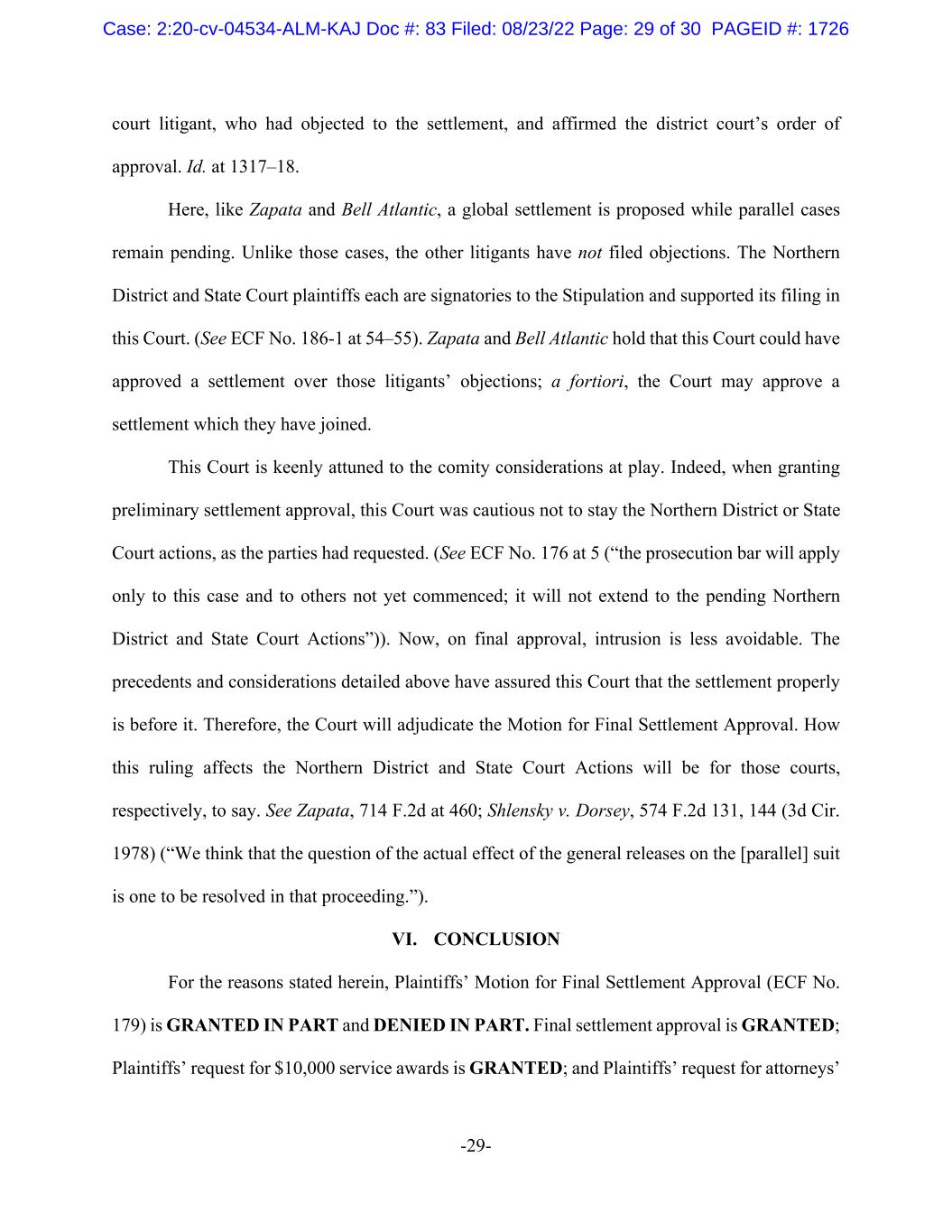
-29- court litigant, who had objected to the settlement, and affirmed the district court’s order of approval. Id. at 1317–18. Here, like Zapata and Bell Atlantic, a global settlement is proposed while parallel cases remain pending. Unlike those cases, the other litigants have not filed objections. The Northern District and State Court plaintiffs each are signatories to the Stipulation and supported its filing in this Court. (See ECF No. 186-1 at 54–55). Zapata and Bell Atlantic hold that this Court could have approved a settlement over those litigants’ objections; a fortiori, the Court may approve a settlement which they have joined. This Court is keenly attuned to the comity considerations at play. Indeed, when granting preliminary settlement approval, this Court was cautious not to stay the Northern District or State Court actions, as the parties had requested. (See ECF No. 176 at 5 (“the prosecution bar will apply only to this case and to others not yet commenced; it will not extend to the pending Northern District and State Court Actions”)). Now, on final approval, intrusion is less avoidable. The precedents and considerations detailed above have assured this Court that the settlement properly is before it. Therefore, the Court will adjudicate the Motion for Final Settlement Approval. How this ruling affects the Northern District and State Court Actions will be for those courts, respectively, to say. See Zapata, 714 F.2d at 460; Shlensky v. Dorsey, 574 F.2d 131, 144 (3d Cir. 1978) (“We think that the question of the actual effect of the general releases on the [parallel] suit is one to be resolved in that proceeding.”). VI. CONCLUSION For the reasons stated herein, Plaintiffs’ Motion for Final Settlement Approval (ECF No. 179) is GRANTED IN PART and DENIED IN PART. Final settlement approval is GRANTED; Plaintiffs’ request for $10,000 service awards is GRANTED; and Plaintiffs’ request for attorneys’ Case: 2:20-cv-04534-ALM-KAJ Doc #: 83 Filed: 08/23/22 Page: 29 of 30 PAGEID #: 1726
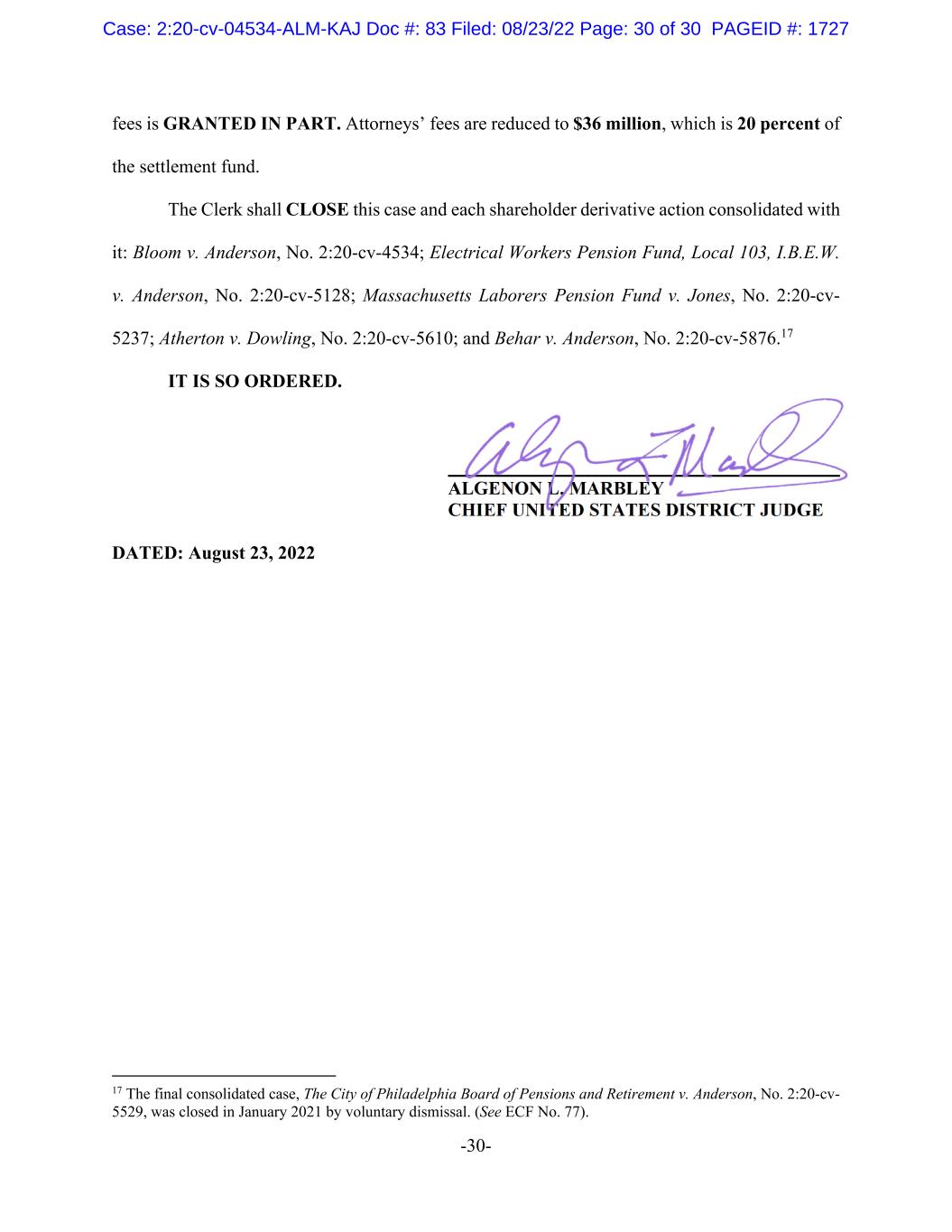
-30- fees is GRANTED IN PART. Attorneys’ fees are reduced to $36 million, which is 20 percent of the settlement fund. The Clerk shall CLOSE this case and each shareholder derivative action consolidated with it: Bloom v. Anderson, No. 2:20-cv-4534; Electrical Workers Pension Fund, Local 103, I.B.E.W. v. Anderson, No. 2:20-cv-5128; Massachusetts Laborers Pension Fund v. Jones, No. 2:20-cv- 5237; Atherton v. Dowling, No. 2:20-cv-5610; and Behar v. Anderson, No. 2:20-cv-5876.17 IT IS SO ORDERED. ALGENON L. MARBLEY CHIEF UNITED STATES DISTRICT JUDGE DATED: August 23, 2022 17 The final consolidated case, The City of Philadelphia Board of Pensions and Retirement v. Anderson, No. 2:20-cv- 5529, was closed in January 2021 by voluntary dismissal. (See ECF No. 77). Case: 2:20-cv-04534-ALM-KAJ Doc #: 83 Filed: 08/23/22 Page: 30 of 30 PAGEID #: 1727
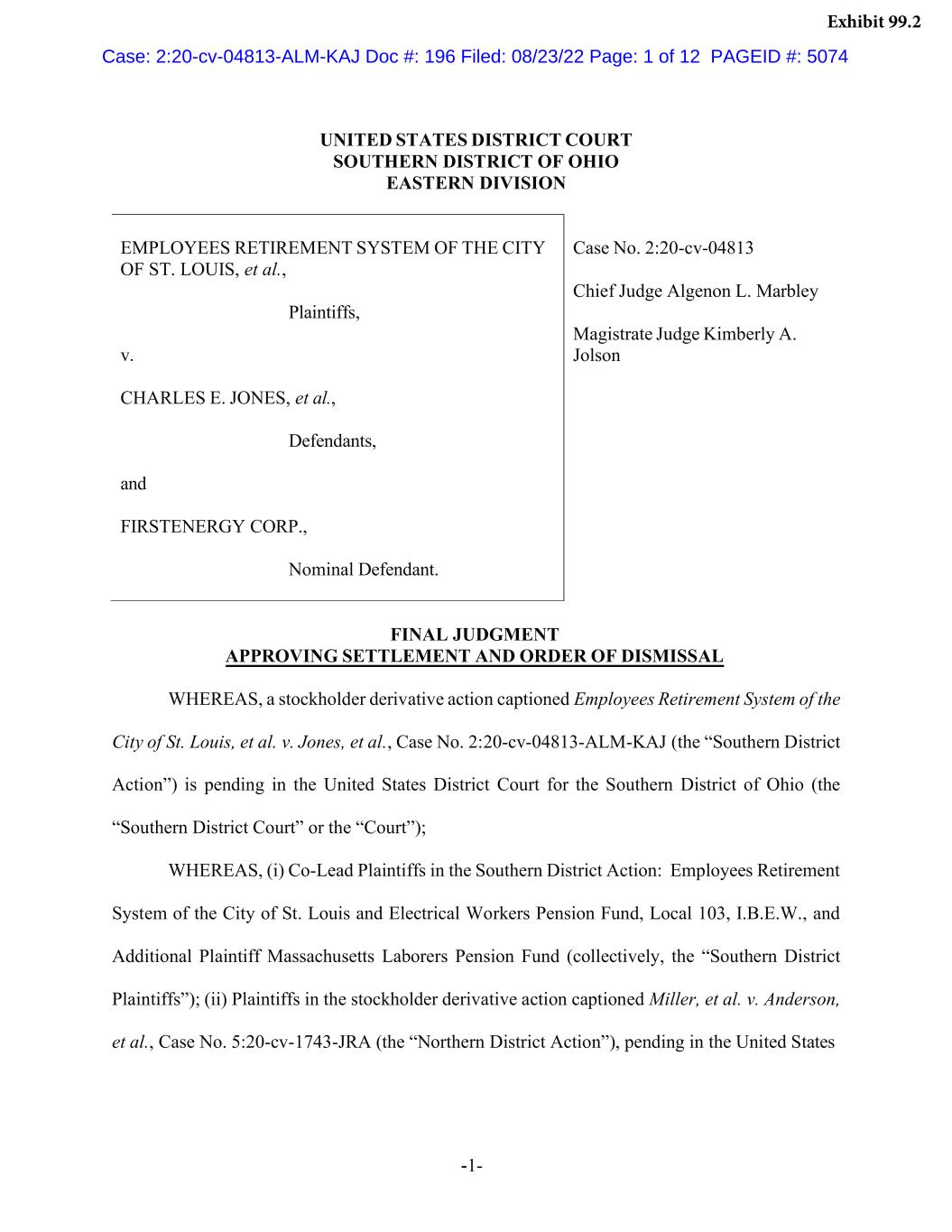
1- UNITED STATES DISTRICT COURT SOUTHERN DISTRICT OF OHIO EASTERN DIVISION Case No. 2:20-cv-04813 Chief Judge Algenon L. Marbley Magistrate Judge Kimberly A. Jolson FINAL JUDGMENT APPROVING SETTLEMENT AND ORDER OF DISMISSAL WHEREAS, a stockholder derivative action captioned Employees Retirement System of the City of St. Louis, et al. v. Jones, et al., Case No. 2:20-cv-04813-ALM-KAJ (the “Southern District Action”) is pending in the United States District Court for the Southern District of Ohio (the “Southern District Court” or the “Court”); WHEREAS, (i) Co-Lead Plaintiffs in the Southern District Action: Employees Retirement System of the City of St. Louis and Electrical Workers Pension Fund, Local 103, I.B.E.W., and Additional Plaintiff Massachusetts Laborers Pension Fund (collectively, the “Southern District Plaintiffs”); (ii) Plaintiffs in the stockholder derivative action captioned Miller, et al. v. Anderson, et al., Case No. 5:20-cv-1743-JRA (the “Northern District Action”), pending in the United States EMPLOYEES RETIREMENT SYSTEM OF THE CITY OF ST. LOUIS, et al., Plaintiffs, v. CHARLES E. JONES, et al., Defendants, and FIRSTENERGY CORP., Nominal Defendant. Case: 2:20-cv-04813-ALM-KAJ Doc #: 196 Filed: 08/23/22 Page: 1 of 12 PAGEID #: 5074 Exhibit 99.2
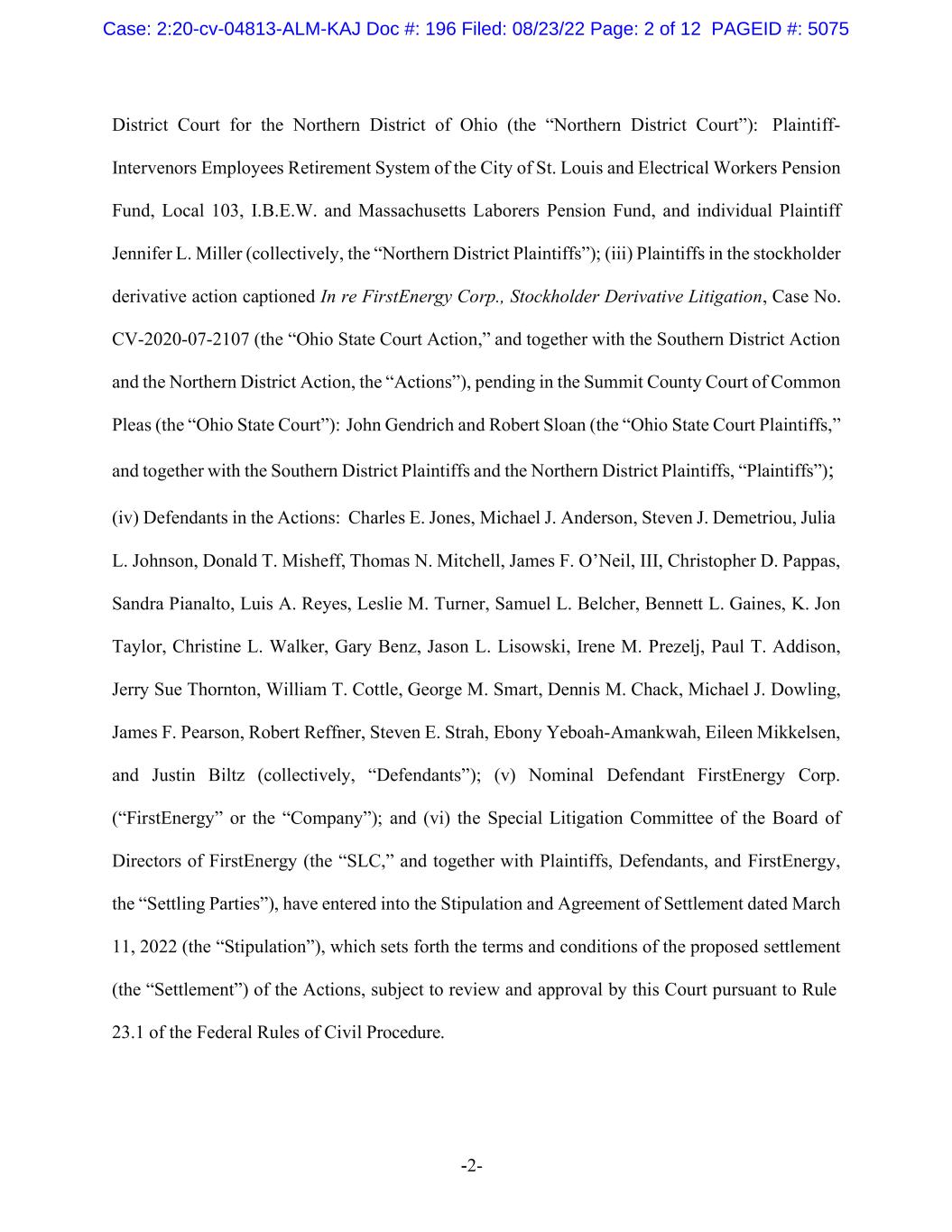
2- District Court for the Northern District of Ohio (the “Northern District Court”): Plaintiff- Intervenors Employees Retirement System of the City of St. Louis and Electrical Workers Pension Fund, Local 103, I.B.E.W. and Massachusetts Laborers Pension Fund, and individual Plaintiff Jennifer L. Miller (collectively, the “Northern District Plaintiffs”); (iii) Plaintiffs in the stockholder derivative action captioned In re FirstEnergy Corp., Stockholder Derivative Litigation, Case No. CV-2020-07-2107 (the “Ohio State Court Action,” and together with the Southern District Action and the Northern District Action, the “Actions”), pending in the Summit County Court of Common Pleas (the “Ohio State Court”): John Gendrich and Robert Sloan (the “Ohio State Court Plaintiffs,” and together with the Southern District Plaintiffs and the Northern District Plaintiffs, “Plaintiffs”); (iv) Defendants in the Actions: Charles E. Jones, Michael J. Anderson, Steven J. Demetriou, Julia L. Johnson, Donald T. Misheff, Thomas N. Mitchell, James F. O’Neil, III, Christopher D. Pappas, Sandra Pianalto, Luis A. Reyes, Leslie M. Turner, Samuel L. Belcher, Bennett L. Gaines, K. Jon Taylor, Christine L. Walker, Gary Benz, Jason L. Lisowski, Irene M. Prezelj, Paul T. Addison, Jerry Sue Thornton, William T. Cottle, George M. Smart, Dennis M. Chack, Michael J. Dowling, James F. Pearson, Robert Reffner, Steven E. Strah, Ebony Yeboah-Amankwah, Eileen Mikkelsen, and Justin Biltz (collectively, “Defendants”); (v) Nominal Defendant FirstEnergy Corp. (“FirstEnergy” or the “Company”); and (vi) the Special Litigation Committee of the Board of Directors of FirstEnergy (the “SLC,” and together with Plaintiffs, Defendants, and FirstEnergy, the “Settling Parties”), have entered into the Stipulation and Agreement of Settlement dated March 11, 2022 (the “Stipulation”), which sets forth the terms and conditions of the proposed settlement (the “Settlement”) of the Actions, subject to review and approval by this Court pursuant to Rule 23.1 of the Federal Rules of Civil Procedure. Case: 2:20-cv-04813-ALM-KAJ Doc #: 196 Filed: 08/23/22 Page: 2 of 12 PAGEID #: 5075
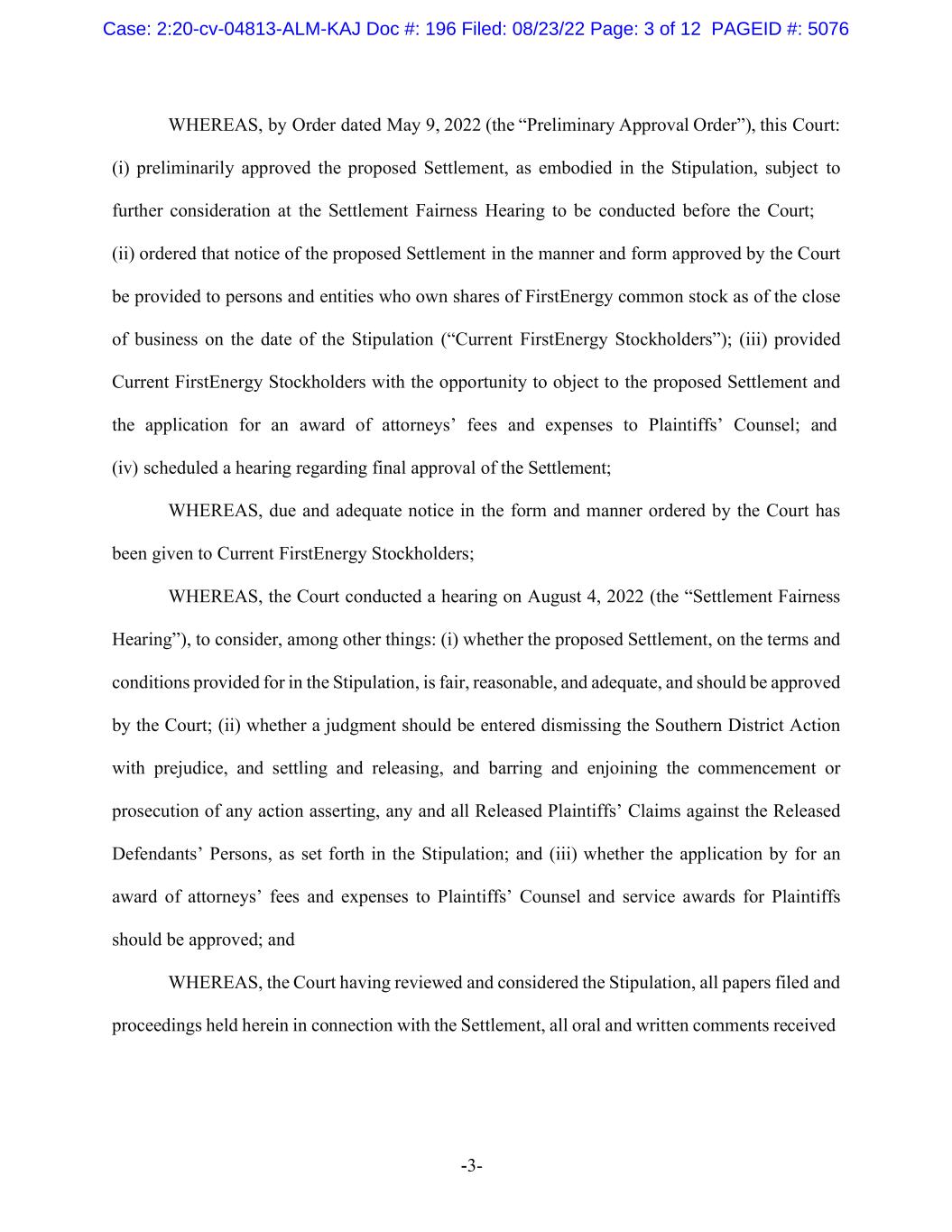
3- WHEREAS, by Order dated May 9, 2022 (the “Preliminary Approval Order”), this Court: (i) preliminarily approved the proposed Settlement, as embodied in the Stipulation, subject to further consideration at the Settlement Fairness Hearing to be conducted before the Court; (ii) ordered that notice of the proposed Settlement in the manner and form approved by the Court be provided to persons and entities who own shares of FirstEnergy common stock as of the close of business on the date of the Stipulation (“Current FirstEnergy Stockholders”); (iii) provided Current FirstEnergy Stockholders with the opportunity to object to the proposed Settlement and the application for an award of attorneys’ fees and expenses to Plaintiffs’ Counsel; and (iv) scheduled a hearing regarding final approval of the Settlement; WHEREAS, due and adequate notice in the form and manner ordered by the Court has been given to Current FirstEnergy Stockholders; WHEREAS, the Court conducted a hearing on August 4, 2022 (the “Settlement Fairness Hearing”), to consider, among other things: (i) whether the proposed Settlement, on the terms and conditions provided for in the Stipulation, is fair, reasonable, and adequate, and should be approved by the Court; (ii) whether a judgment should be entered dismissing the Southern District Action with prejudice, and settling and releasing, and barring and enjoining the commencement or prosecution of any action asserting, any and all Released Plaintiffs’ Claims against the Released Defendants’ Persons, as set forth in the Stipulation; and (iii) whether the application by for an award of attorneys’ fees and expenses to Plaintiffs’ Counsel and service awards for Plaintiffs should be approved; and WHEREAS, the Court having reviewed and considered the Stipulation, all papers filed and proceedings held herein in connection with the Settlement, all oral and written comments received Case: 2:20-cv-04813-ALM-KAJ Doc #: 196 Filed: 08/23/22 Page: 3 of 12 PAGEID #: 5076
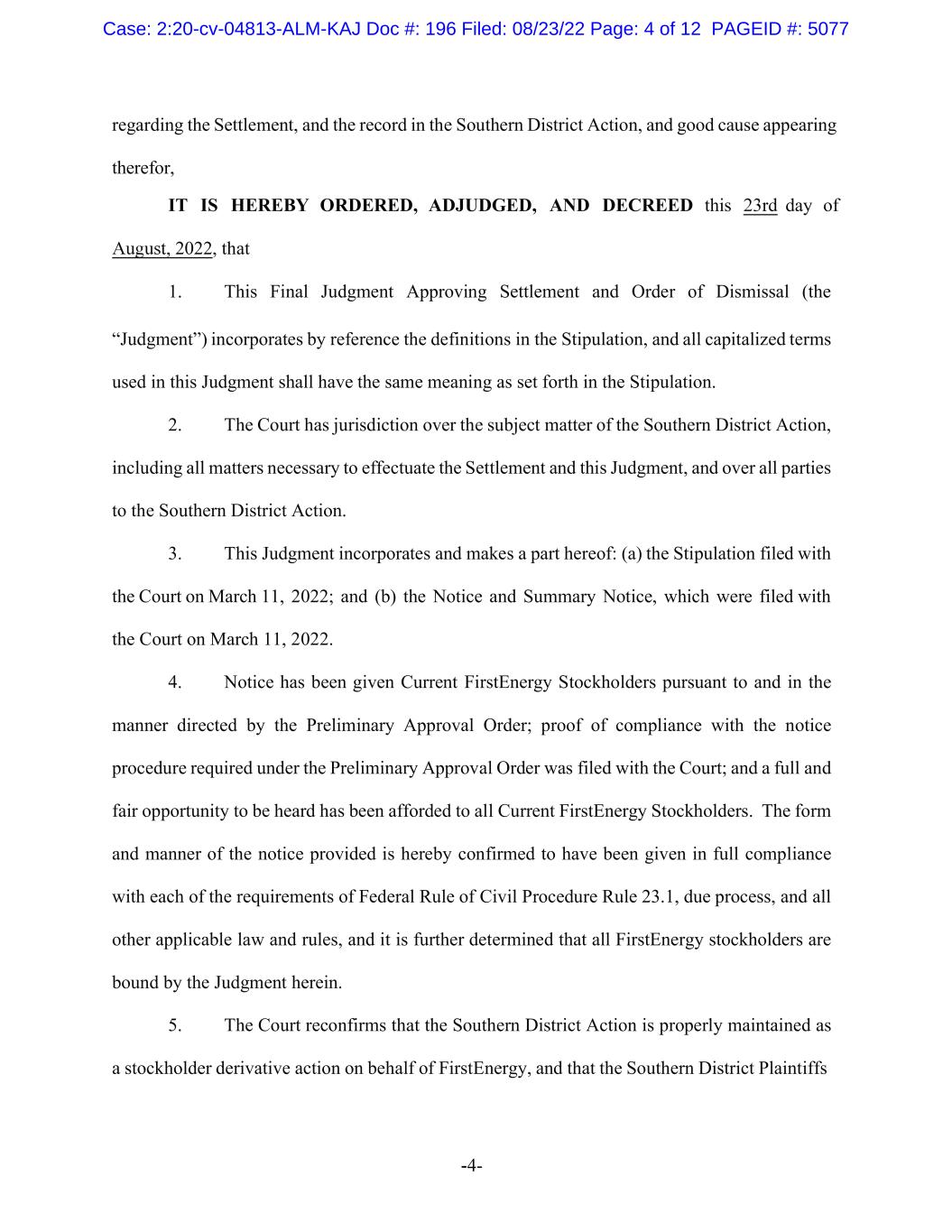
4- regarding the Settlement, and the record in the Southern District Action, and good cause appearing therefor, IT IS HEREBY ORDERED, ADJUDGED, AND DECREED this day of , 2022, that 1. This Final Judgment Approving Settlement and Order of Dismissal (the “Judgment”) incorporates by reference the definitions in the Stipulation, and all capitalized terms used in this Judgment shall have the same meaning as set forth in the Stipulation. 2. The Court has jurisdiction over the subject matter of the Southern District Action, including all matters necessary to effectuate the Settlement and this Judgment, and over all parties to the Southern District Action. 3. This Judgment incorporates and makes a part hereof: (a) the Stipulation filed with the Court on March 11, 2022; and (b) the Notice and Summary Notice, which were filed with the Court on March 11, 2022. 4. Notice has been given Current FirstEnergy Stockholders pursuant to and in the manner directed by the Preliminary Approval Order; proof of compliance with the notice procedure required under the Preliminary Approval Order was filed with the Court; and a full and fair opportunity to be heard has been afforded to all Current FirstEnergy Stockholders. The form and manner of the notice provided is hereby confirmed to have been given in full compliance with each of the requirements of Federal Rule of Civil Procedure Rule 23.1, due process, and all other applicable law and rules, and it is further determined that all FirstEnergy stockholders are bound by the Judgment herein. 5. The Court reconfirms that the Southern District Action is properly maintained as a stockholder derivative action on behalf of FirstEnergy, and that the Southern District Plaintiffs Case: 2:20-cv-04813-ALM-KAJ Doc #: 196 Filed: 08/23/22 Page: 4 of 12 PAGEID #: 5077
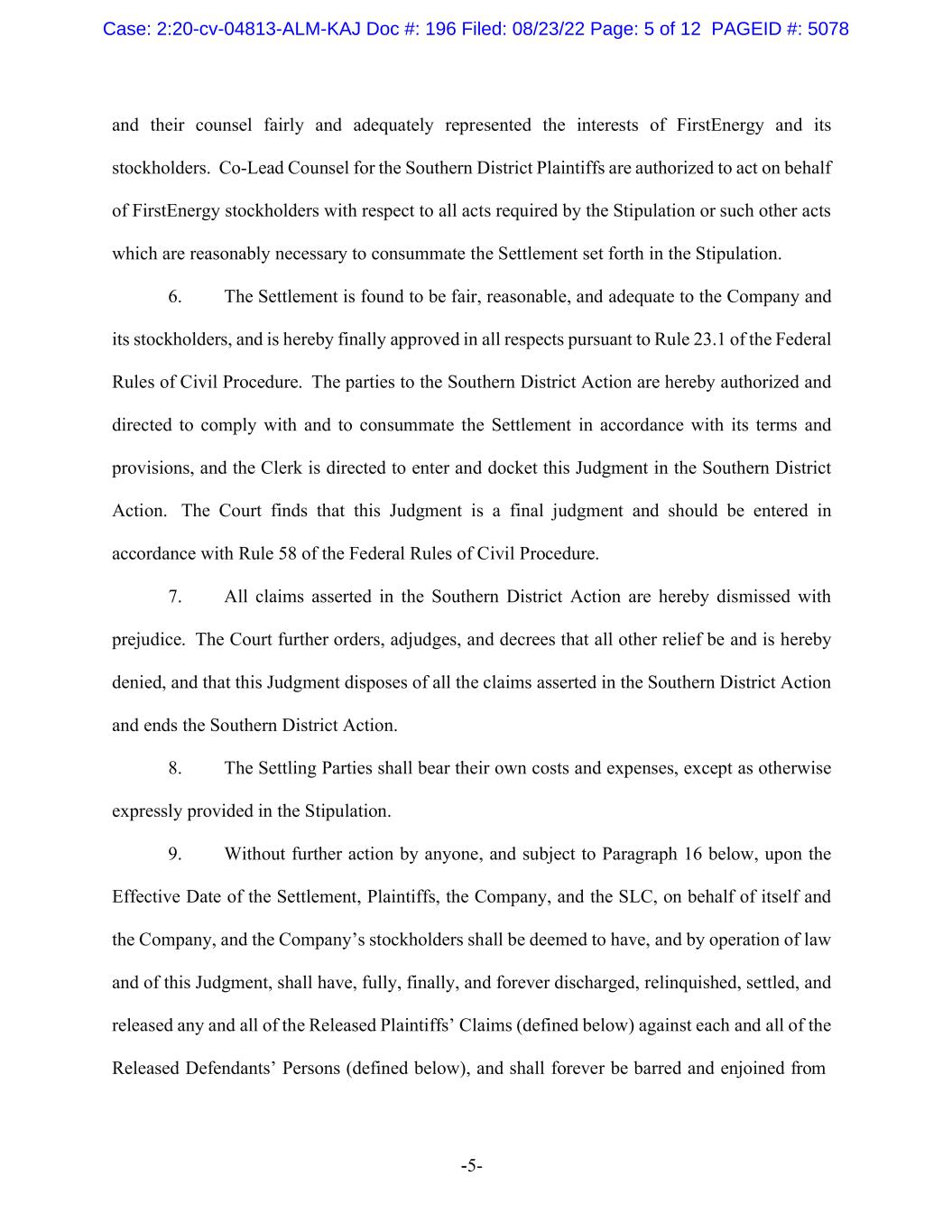
5- and their counsel fairly and adequately represented the interests of FirstEnergy and its stockholders. Co-Lead Counsel for the Southern District Plaintiffs are authorized to act on behalf of FirstEnergy stockholders with respect to all acts required by the Stipulation or such other acts which are reasonably necessary to consummate the Settlement set forth in the Stipulation. 6. The Settlement is found to be fair, reasonable, and adequate to the Company and its stockholders, and is hereby finally approved in all respects pursuant to Rule 23.1 of the Federal Rules of Civil Procedure. The parties to the Southern District Action are hereby authorized and directed to comply with and to consummate the Settlement in accordance with its terms and provisions, and the Clerk is directed to enter and docket this Judgment in the Southern District Action. The Court finds that this Judgment is a final judgment and should be entered in accordance with Rule 58 of the Federal Rules of Civil Procedure. 7. All claims asserted in the Southern District Action are hereby dismissed with prejudice. The Court further orders, adjudges, and decrees that all other relief be and is hereby denied, and that this Judgment disposes of all the claims asserted in the Southern District Action and ends the Southern District Action. 8. The Settling Parties shall bear their own costs and expenses, except as otherwise expressly provided in the Stipulation. 9. Without further action by anyone, and subject to Paragraph 16 below, upon the Effective Date of the Settlement, Plaintiffs, the Company, and the SLC, on behalf of itself and the Company, and the Company’s stockholders shall be deemed to have, and by operation of law and of this Judgment, shall have, fully, finally, and forever discharged, relinquished, settled, and released any and all of the Released Plaintiffs’ Claims (defined below) against each and all of the Released Defendants’ Persons (defined below), and shall forever be barred and enjoined from Case: 2:20-cv-04813-ALM-KAJ Doc #: 196 Filed: 08/23/22 Page: 5 of 12 PAGEID #: 5078
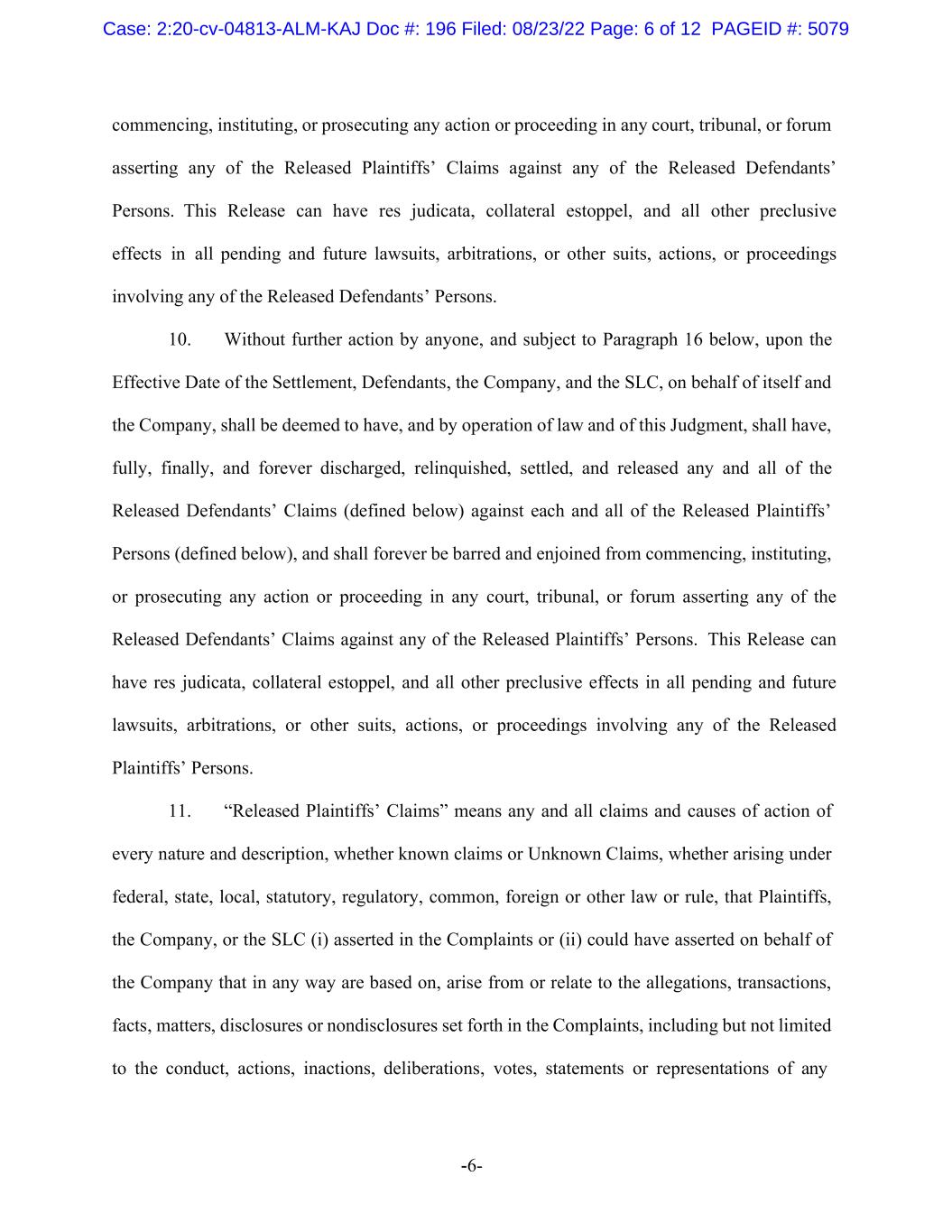
6- commencing, instituting, or prosecuting any action or proceeding in any court, tribunal, or forum asserting any of the Released Plaintiffs’ Claims against any of the Released Defendants’ Persons. This Release can have res judicata, collateral estoppel, and all other preclusive effects in all pending and future lawsuits, arbitrations, or other suits, actions, or proceedings involving any of the Released Defendants’ Persons. 10. Without further action by anyone, and subject to Paragraph 16 below, upon the Effective Date of the Settlement, Defendants, the Company, and the SLC, on behalf of itself and the Company, shall be deemed to have, and by operation of law and of this Judgment, shall have, fully, finally, and forever discharged, relinquished, settled, and released any and all of the Released Defendants’ Claims (defined below) against each and all of the Released Plaintiffs’ Persons (defined below), and shall forever be barred and enjoined from commencing, instituting, or prosecuting any action or proceeding in any court, tribunal, or forum asserting any of the Released Defendants’ Claims against any of the Released Plaintiffs’ Persons. This Release can have res judicata, collateral estoppel, and all other preclusive effects in all pending and future lawsuits, arbitrations, or other suits, actions, or proceedings involving any of the Released Plaintiffs’ Persons. 11. “Released Plaintiffs’ Claims” means any and all claims and causes of action of every nature and description, whether known claims or Unknown Claims, whether arising under federal, state, local, statutory, regulatory, common, foreign or other law or rule, that Plaintiffs, the Company, or the SLC (i) asserted in the Complaints or (ii) could have asserted on behalf of the Company that in any way are based on, arise from or relate to the allegations, transactions, facts, matters, disclosures or nondisclosures set forth in the Complaints, including but not limited to the conduct, actions, inactions, deliberations, votes, statements or representations of any Case: 2:20-cv-04813-ALM-KAJ Doc #: 196 Filed: 08/23/22 Page: 6 of 12 PAGEID #: 5079
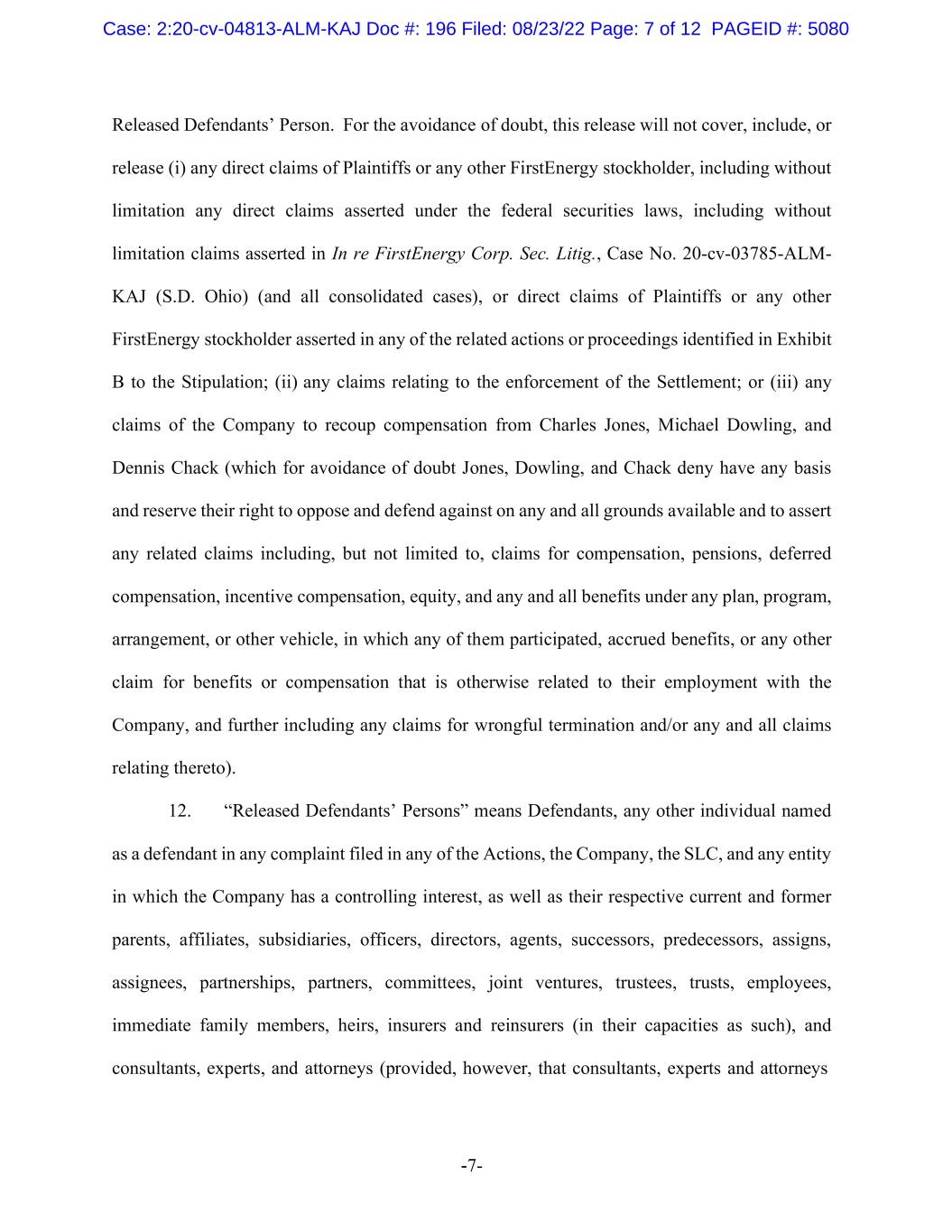
7- Released Defendants’ Person. For the avoidance of doubt, this release will not cover, include, or release (i) any direct claims of Plaintiffs or any other FirstEnergy stockholder, including without limitation any direct claims asserted under the federal securities laws, including without limitation claims asserted in In re FirstEnergy Corp. Sec. Litig., Case No. 20-cv-03785-ALM- KAJ (S.D. Ohio) (and all consolidated cases), or direct claims of Plaintiffs or any other FirstEnergy stockholder asserted in any of the related actions or proceedings identified in Exhibit B to the Stipulation; (ii) any claims relating to the enforcement of the Settlement; or (iii) any claims of the Company to recoup compensation from Charles Jones, Michael Dowling, and Dennis Chack (which for avoidance of doubt Jones, Dowling, and Chack deny have any basis and reserve their right to oppose and defend against on any and all grounds available and to assert any related claims including, but not limited to, claims for compensation, pensions, deferred compensation, incentive compensation, equity, and any and all benefits under any plan, program, arrangement, or other vehicle, in which any of them participated, accrued benefits, or any other claim for benefits or compensation that is otherwise related to their employment with the Company, and further including any claims for wrongful termination and/or any and all claims relating thereto). 12. “Released Defendants’ Persons” means Defendants, any other individual named as a defendant in any complaint filed in any of the Actions, the Company, the SLC, and any entity in which the Company has a controlling interest, as well as their respective current and former parents, affiliates, subsidiaries, officers, directors, agents, successors, predecessors, assigns, assignees, partnerships, partners, committees, joint ventures, trustees, trusts, employees, immediate family members, heirs, insurers and reinsurers (in their capacities as such), and consultants, experts, and attorneys (provided, however, that consultants, experts and attorneys Case: 2:20-cv-04813-ALM-KAJ Doc #: 196 Filed: 08/23/22 Page: 7 of 12 PAGEID #: 5080
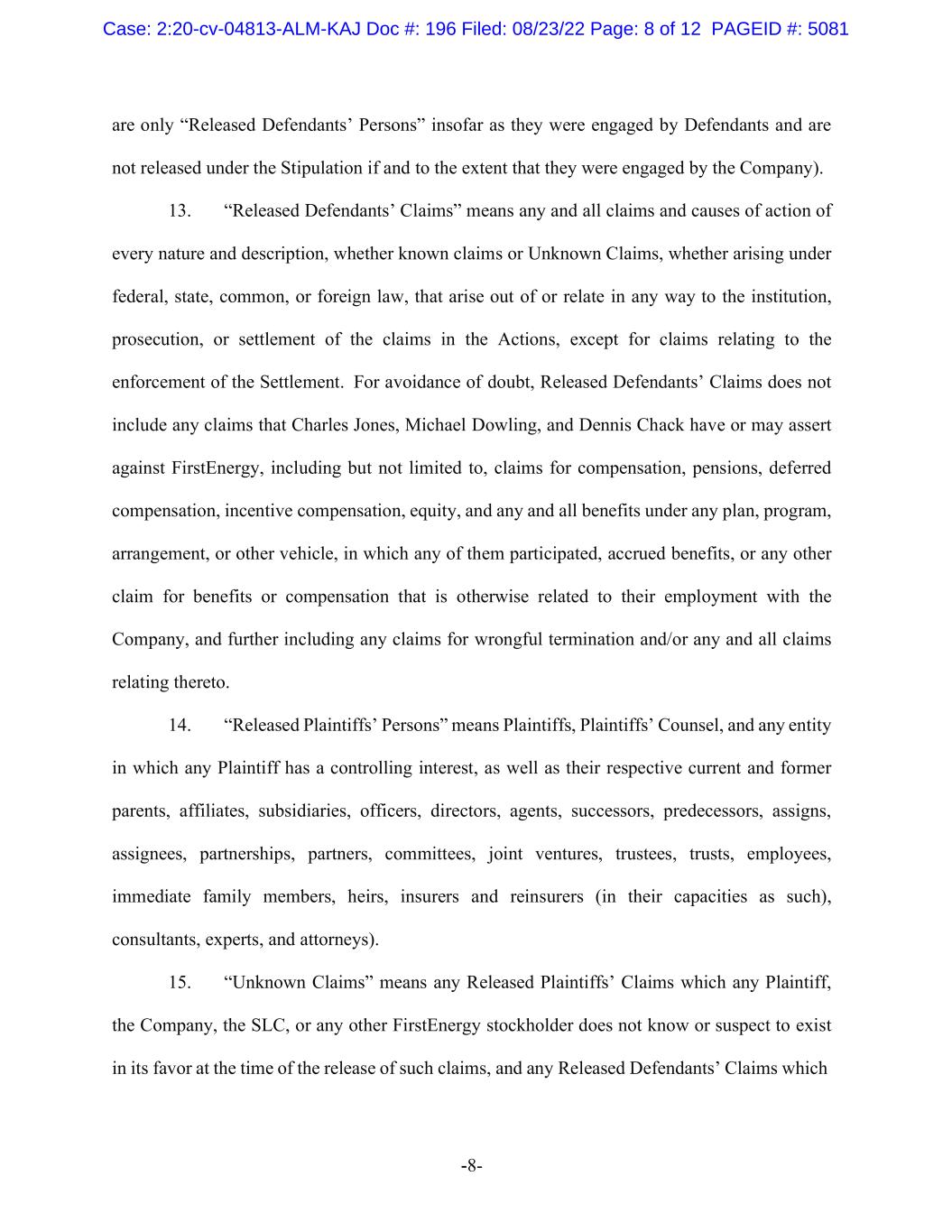
8- are only “Released Defendants’ Persons” insofar as they were engaged by Defendants and are not released under the Stipulation if and to the extent that they were engaged by the Company). 13. “Released Defendants’ Claims” means any and all claims and causes of action of every nature and description, whether known claims or Unknown Claims, whether arising under federal, state, common, or foreign law, that arise out of or relate in any way to the institution, prosecution, or settlement of the claims in the Actions, except for claims relating to the enforcement of the Settlement. For avoidance of doubt, Released Defendants’ Claims does not include any claims that Charles Jones, Michael Dowling, and Dennis Chack have or may assert against FirstEnergy, including but not limited to, claims for compensation, pensions, deferred compensation, incentive compensation, equity, and any and all benefits under any plan, program, arrangement, or other vehicle, in which any of them participated, accrued benefits, or any other claim for benefits or compensation that is otherwise related to their employment with the Company, and further including any claims for wrongful termination and/or any and all claims relating thereto. 14. “Released Plaintiffs’ Persons” means Plaintiffs, Plaintiffs’ Counsel, and any entity in which any Plaintiff has a controlling interest, as well as their respective current and former parents, affiliates, subsidiaries, officers, directors, agents, successors, predecessors, assigns, assignees, partnerships, partners, committees, joint ventures, trustees, trusts, employees, immediate family members, heirs, insurers and reinsurers (in their capacities as such), consultants, experts, and attorneys). 15. “Unknown Claims” means any Released Plaintiffs’ Claims which any Plaintiff, the Company, the SLC, or any other FirstEnergy stockholder does not know or suspect to exist in its favor at the time of the release of such claims, and any Released Defendants’ Claims which Case: 2:20-cv-04813-ALM-KAJ Doc #: 196 Filed: 08/23/22 Page: 8 of 12 PAGEID #: 5081
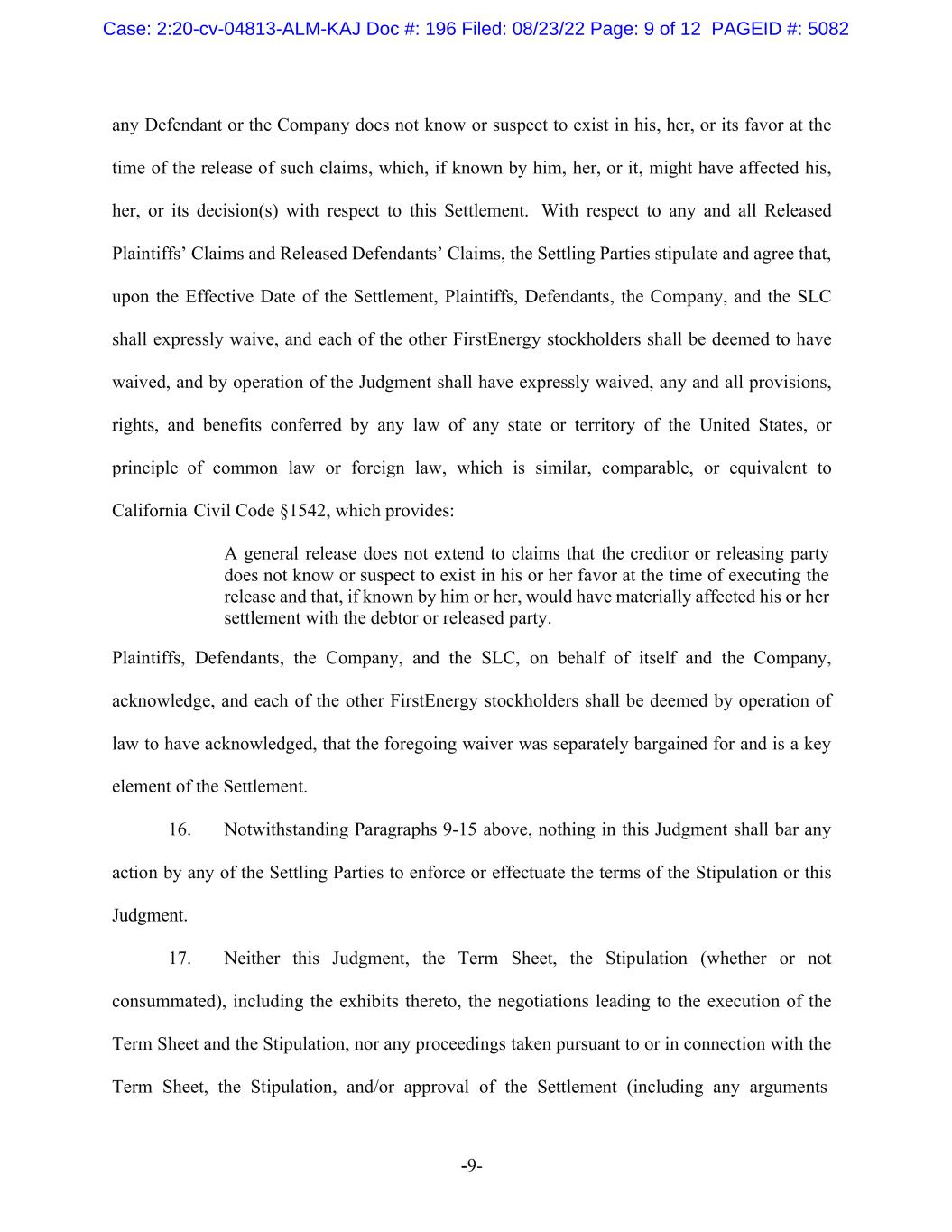
9- any Defendant or the Company does not know or suspect to exist in his, her, or its favor at the time of the release of such claims, which, if known by him, her, or it, might have affected his, her, or its decision(s) with respect to this Settlement. With respect to any and all Released Plaintiffs’ Claims and Released Defendants’ Claims, the Settling Parties stipulate and agree that, upon the Effective Date of the Settlement, Plaintiffs, Defendants, the Company, and the SLC shall expressly waive, and each of the other FirstEnergy stockholders shall be deemed to have waived, and by operation of the Judgment shall have expressly waived, any and all provisions, rights, and benefits conferred by any law of any state or territory of the United States, or principle of common law or foreign law, which is similar, comparable, or equivalent to California Civil Code §1542, which provides: A general release does not extend to claims that the creditor or releasing party does not know or suspect to exist in his or her favor at the time of executing the release and that, if known by him or her, would have materially affected his or her settlement with the debtor or released party. Plaintiffs, Defendants, the Company, and the SLC, on behalf of itself and the Company, acknowledge, and each of the other FirstEnergy stockholders shall be deemed by operation of law to have acknowledged, that the foregoing waiver was separately bargained for and is a key element of the Settlement. 16. Notwithstanding Paragraphs 9-15 above, nothing in this Judgment shall bar any action by any of the Settling Parties to enforce or effectuate the terms of the Stipulation or this Judgment. 17. Neither this Judgment, the Term Sheet, the Stipulation (whether or not consummated), including the exhibits thereto, the negotiations leading to the execution of the Term Sheet and the Stipulation, nor any proceedings taken pursuant to or in connection with the Term Sheet, the Stipulation, and/or approval of the Settlement (including any arguments Case: 2:20-cv-04813-ALM-KAJ Doc #: 196 Filed: 08/23/22 Page: 9 of 12 PAGEID #: 5082
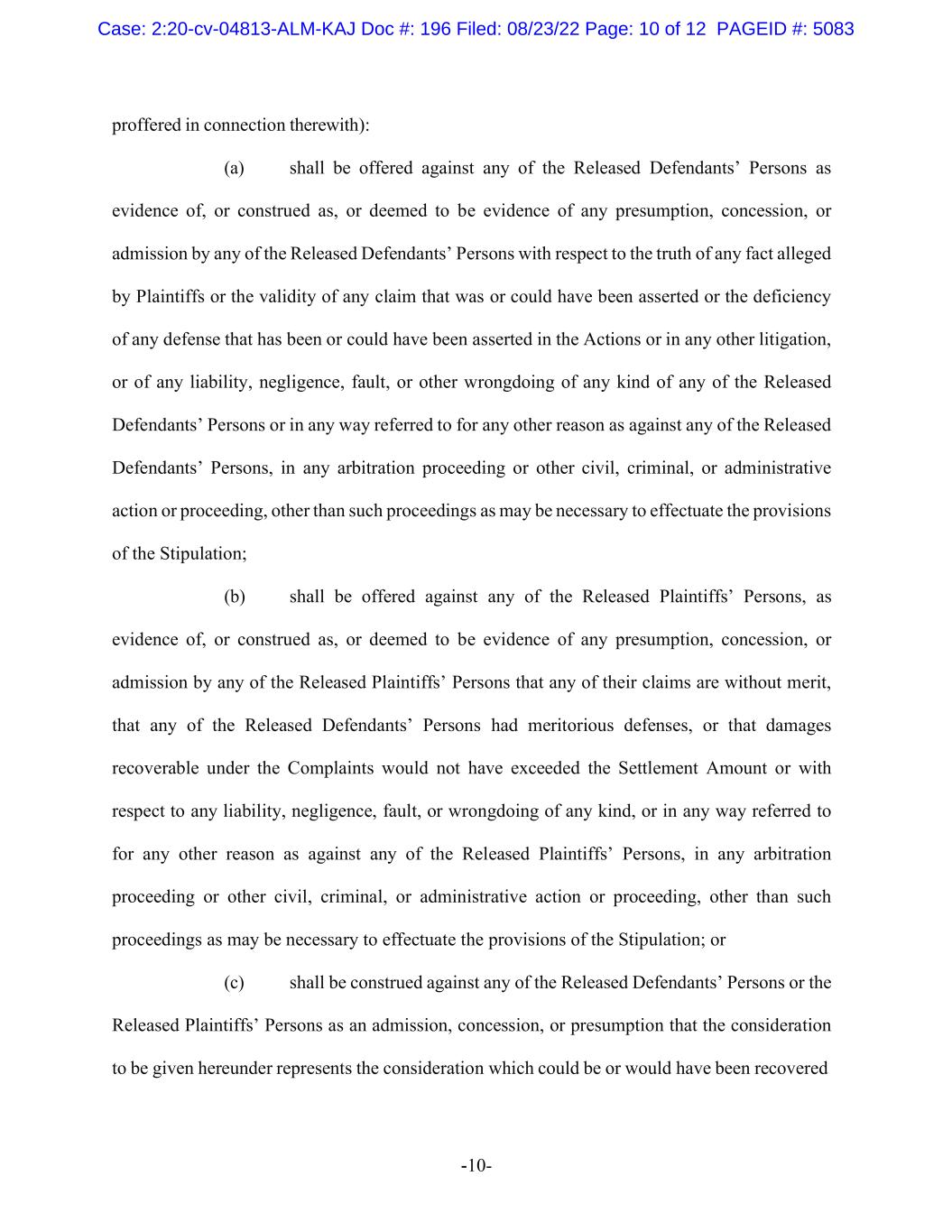
10- proffered in connection therewith): (a) shall be offered against any of the Released Defendants’ Persons as evidence of, or construed as, or deemed to be evidence of any presumption, concession, or admission by any of the Released Defendants’ Persons with respect to the truth of any fact alleged by Plaintiffs or the validity of any claim that was or could have been asserted or the deficiency of any defense that has been or could have been asserted in the Actions or in any other litigation, or of any liability, negligence, fault, or other wrongdoing of any kind of any of the Released Defendants’ Persons or in any way referred to for any other reason as against any of the Released Defendants’ Persons, in any arbitration proceeding or other civil, criminal, or administrative action or proceeding, other than such proceedings as may be necessary to effectuate the provisions of the Stipulation; (b) shall be offered against any of the Released Plaintiffs’ Persons, as evidence of, or construed as, or deemed to be evidence of any presumption, concession, or admission by any of the Released Plaintiffs’ Persons that any of their claims are without merit, that any of the Released Defendants’ Persons had meritorious defenses, or that damages recoverable under the Complaints would not have exceeded the Settlement Amount or with respect to any liability, negligence, fault, or wrongdoing of any kind, or in any way referred to for any other reason as against any of the Released Plaintiffs’ Persons, in any arbitration proceeding or other civil, criminal, or administrative action or proceeding, other than such proceedings as may be necessary to effectuate the provisions of the Stipulation; or (c) shall be construed against any of the Released Defendants’ Persons or the Released Plaintiffs’ Persons as an admission, concession, or presumption that the consideration to be given hereunder represents the consideration which could be or would have been recovered Case: 2:20-cv-04813-ALM-KAJ Doc #: 196 Filed: 08/23/22 Page: 10 of 12 PAGEID #: 5083
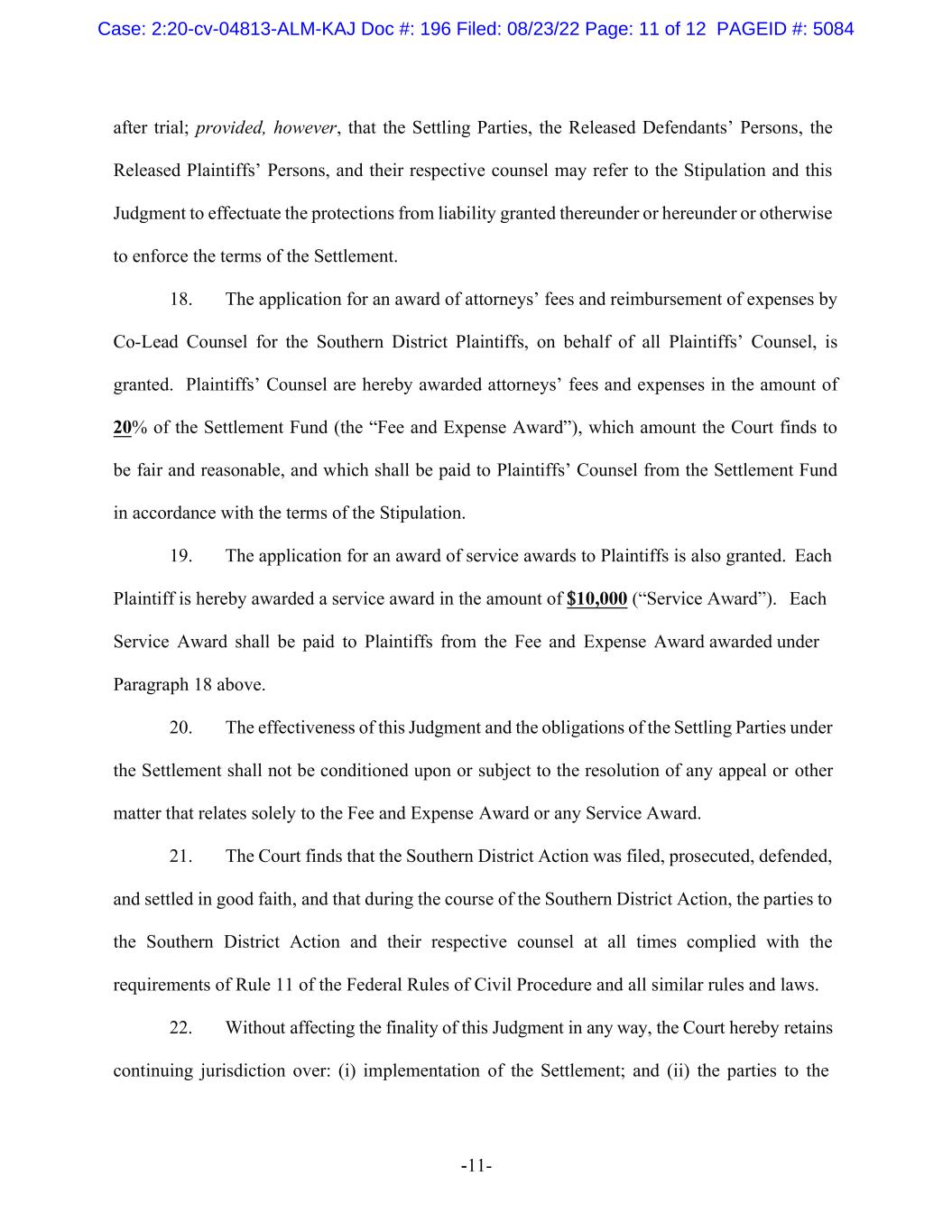
11- after trial; provided, however, that the Settling Parties, the Released Defendants’ Persons, the Released Plaintiffs’ Persons, and their respective counsel may refer to the Stipulation and this Judgment to effectuate the protections from liability granted thereunder or hereunder or otherwise to enforce the terms of the Settlement. 18. The application for an award of attorneys’ fees and reimbursement of expenses by Co-Lead Counsel for the Southern District Plaintiffs, on behalf of all Plaintiffs’ Counsel, is granted. Plaintiffs’ Counsel are hereby awarded attorneys’ fees and expenses in the amount of % of the Settlement Fund (the “Fee and Expense Award”), which amount the Court finds to be fair and reasonable, and which shall be paid to Plaintiffs’ Counsel from the Settlement Fund in accordance with the terms of the Stipulation. 19. The application for an award of service awards to Plaintiffs is also granted. Each Plaintiff is hereby awarded a service award in the amount of $ . Each Service Award shall be paid to Plaintiffs from the Fee and Expense Award awarded under Paragraph 18 above. 20. The effectiveness of this Judgment and the obligations of the Settling Parties under the Settlement shall not be conditioned upon or subject to the resolution of any appeal or other matter that relates solely to the Fee and Expense Award or any Service Award. 21. The Court finds that the Southern District Action was filed, prosecuted, defended, and settled in good faith, and that during the course of the Southern District Action, the parties to the Southern District Action and their respective counsel at all times complied with the requirements of Rule 11 of the Federal Rules of Civil Procedure and all similar rules and laws. 22. Without affecting the finality of this Judgment in any way, the Court hereby retains continuing jurisdiction over: (i) implementation of the Settlement; and (ii) the parties to the Case: 2:20-cv-04813-ALM-KAJ Doc #: 196 Filed: 08/23/22 Page: 11 of 12 PAGEID #: 5084
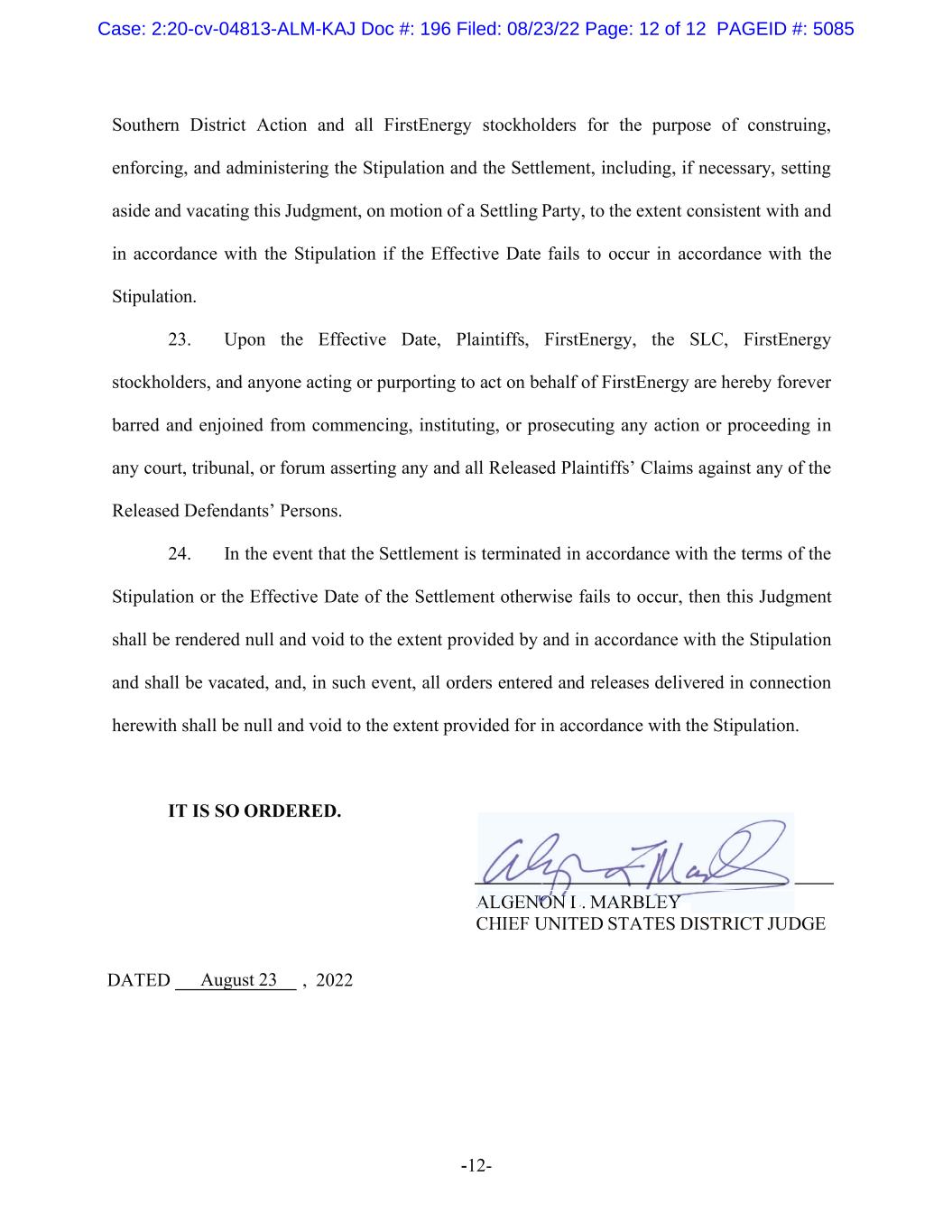
12- Southern District Action and all FirstEnergy stockholders for the purpose of construing, enforcing, and administering the Stipulation and the Settlement, including, if necessary, setting aside and vacating this Judgment, on motion of a Settling Party, to the extent consistent with and in accordance with the Stipulation if the Effective Date fails to occur in accordance with the Stipulation. 23. Upon the Effective Date, Plaintiffs, FirstEnergy, the SLC, FirstEnergy stockholders, and anyone acting or purporting to act on behalf of FirstEnergy are hereby forever barred and enjoined from commencing, instituting, or prosecuting any action or proceeding in any court, tribunal, or forum asserting any and all Released Plaintiffs’ Claims against any of the Released Defendants’ Persons. 24. In the event that the Settlement is terminated in accordance with the terms of the Stipulation or the Effective Date of the Settlement otherwise fails to occur, then this Judgment shall be rendered null and void to the extent provided by and in accordance with the Stipulation and shall be vacated, and, in such event, all orders entered and releases delivered in connection herewith shall be null and void to the extent provided for in accordance with the Stipulation. IT IS SO ORDERED. DATED 2022 ALGENON L. MARBLEY UNITED STATES DISTRICT JUDGE August 23 Case: 2:20-cv-04813-ALM-KAJ Doc #: 196 Filed: 08/23/22 Page: 12 of 12 PAGEID #: 5085
Serious News for Serious Traders! Try StreetInsider.com Premium Free!
You May Also Be Interested In
- FirstEnergy (FE) Appoints John Combs as SVP of Shared Services
- Thomas Jordan of SNB Cautions on Retail CBDC Risks
- Canadian Immigration Lawyer Ronen Kurzfeld Launches New Website for Kurzfeld Law
Create E-mail Alert Related Categories
SEC FilingsSign up for StreetInsider Free!
Receive full access to all new and archived articles, unlimited portfolio tracking, e-mail alerts, custom newswires and RSS feeds - and more!



 Tweet
Tweet Share
Share